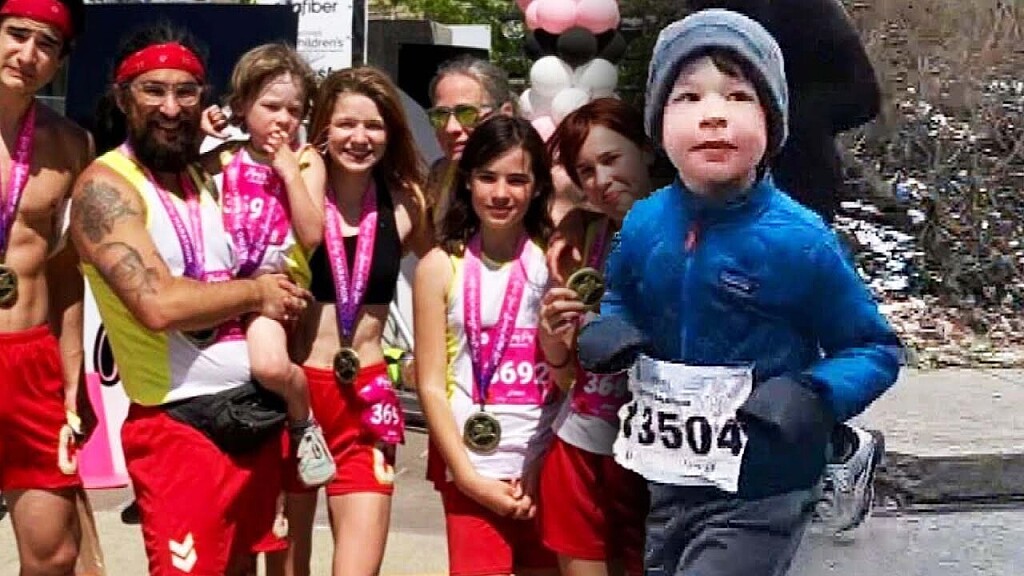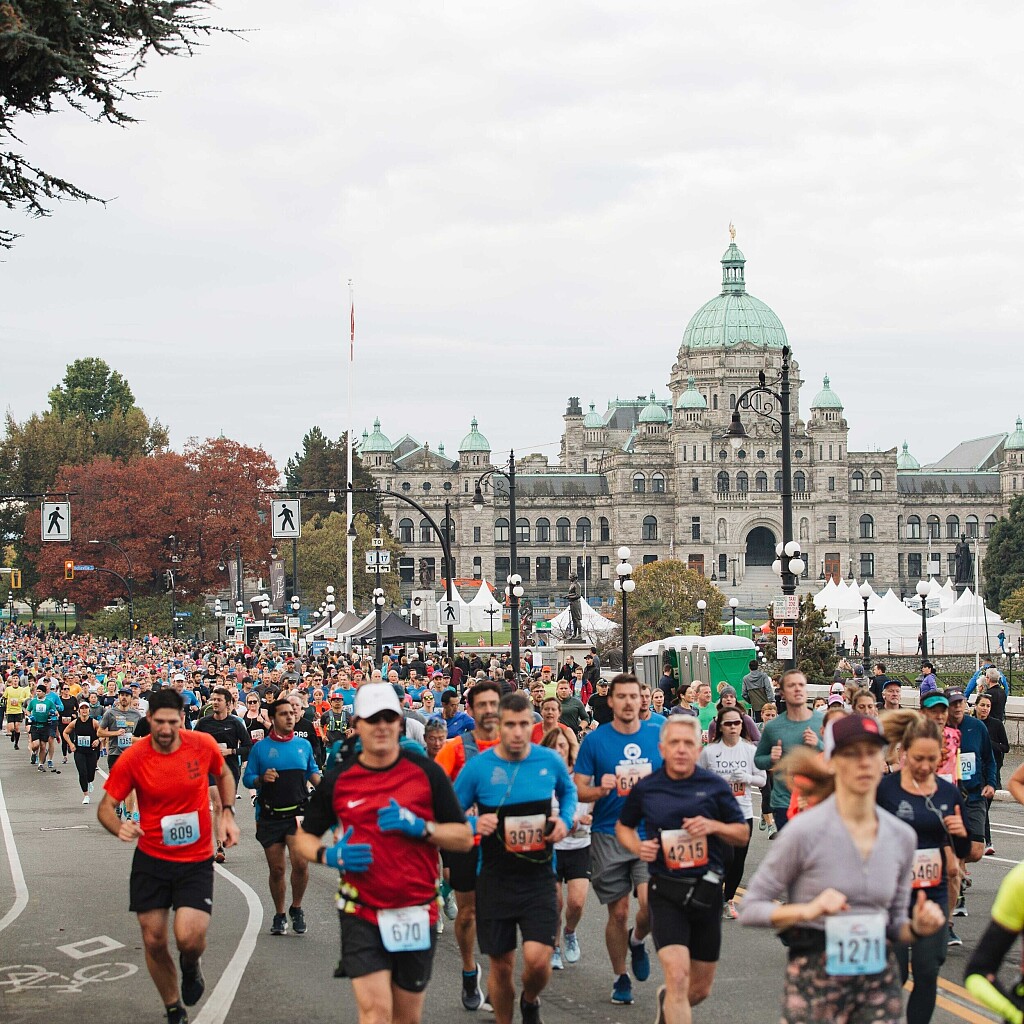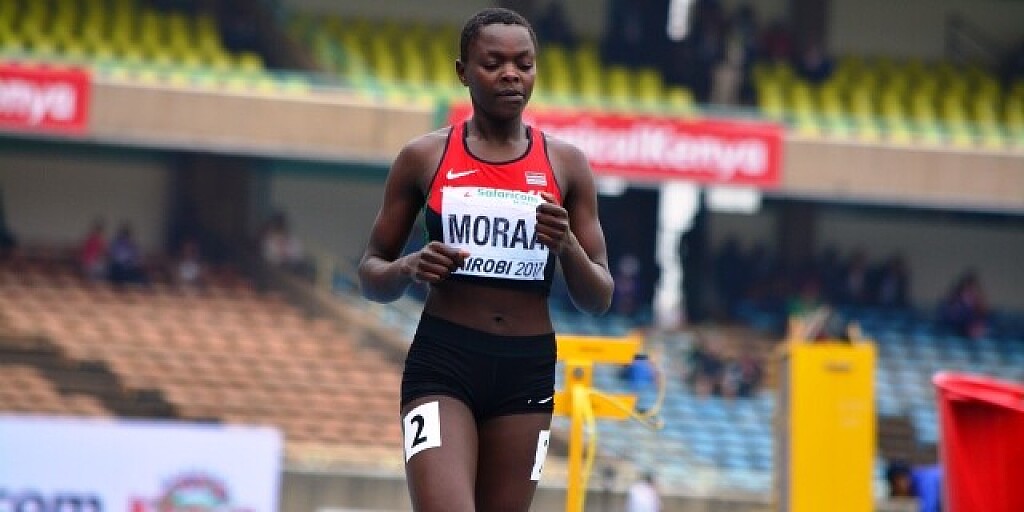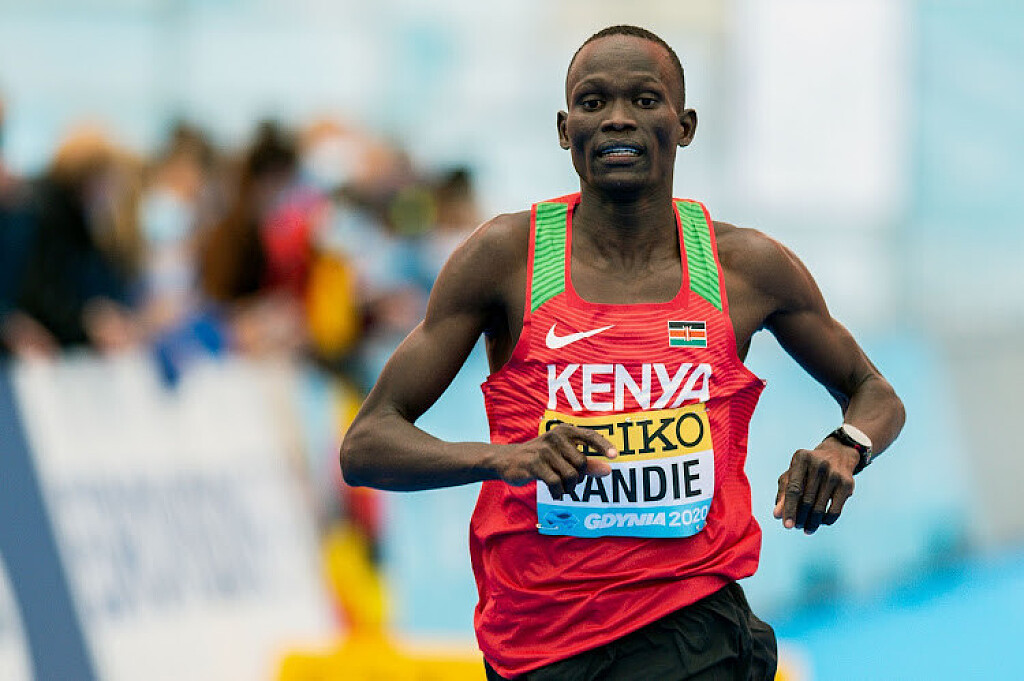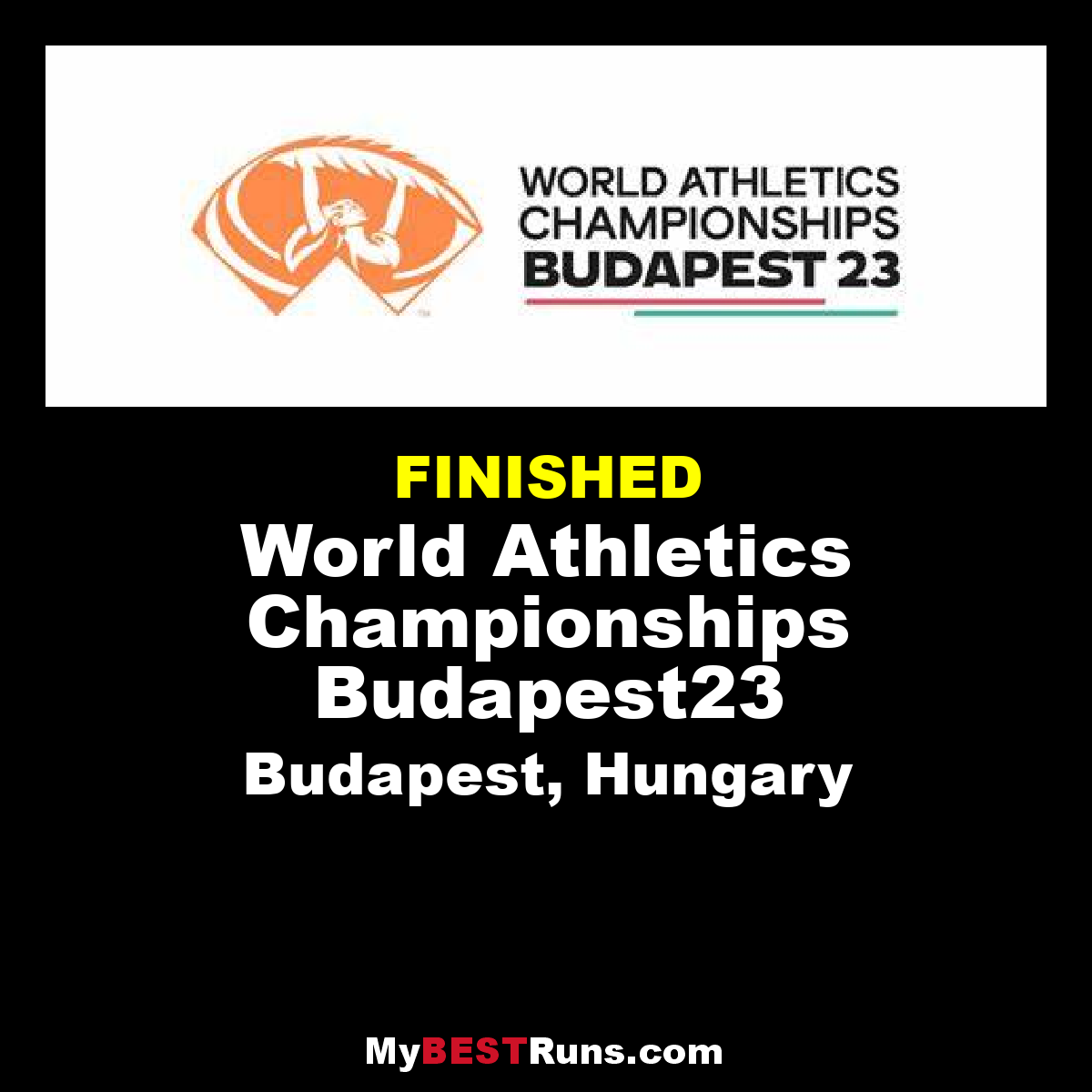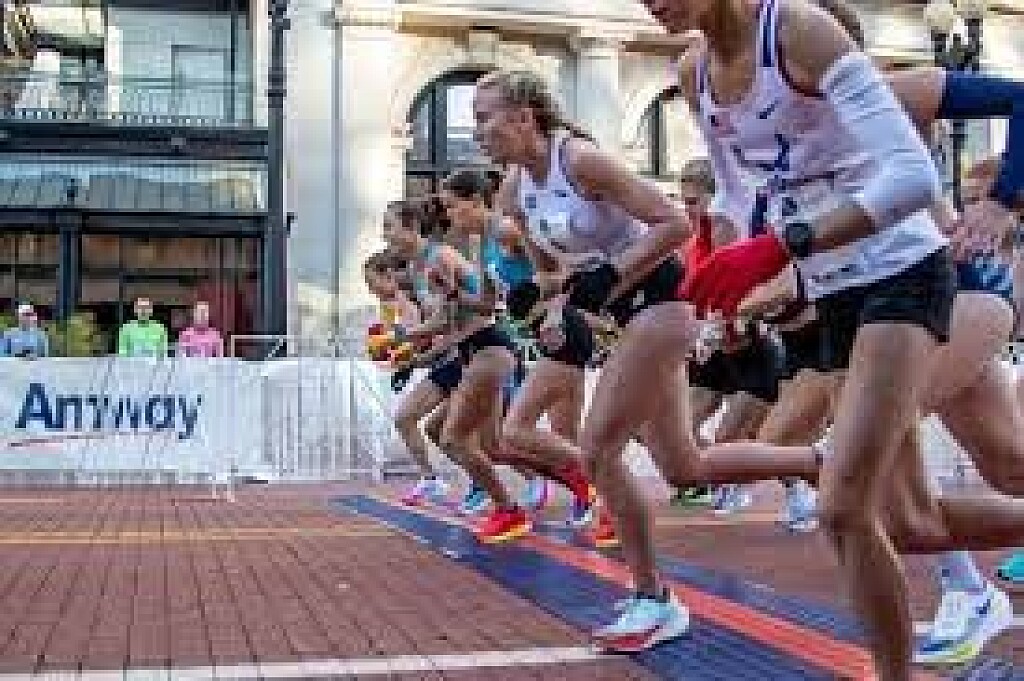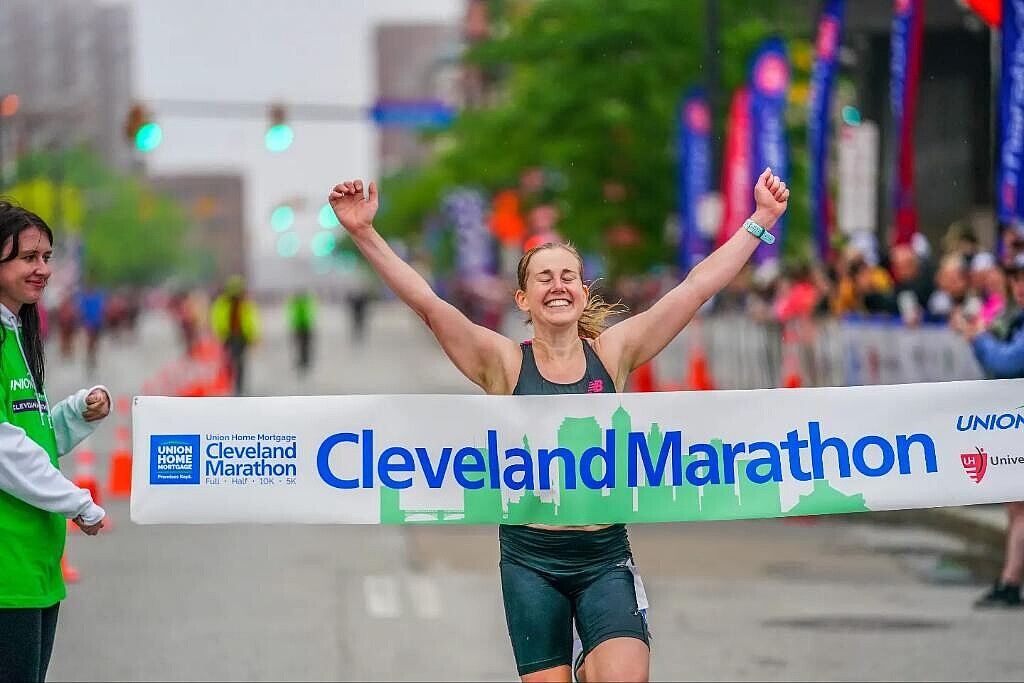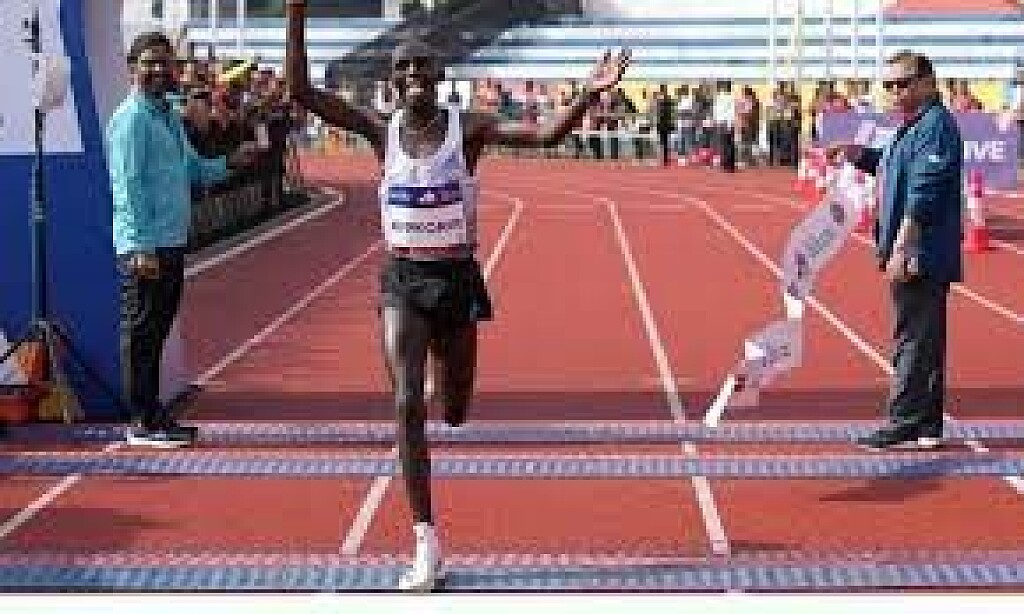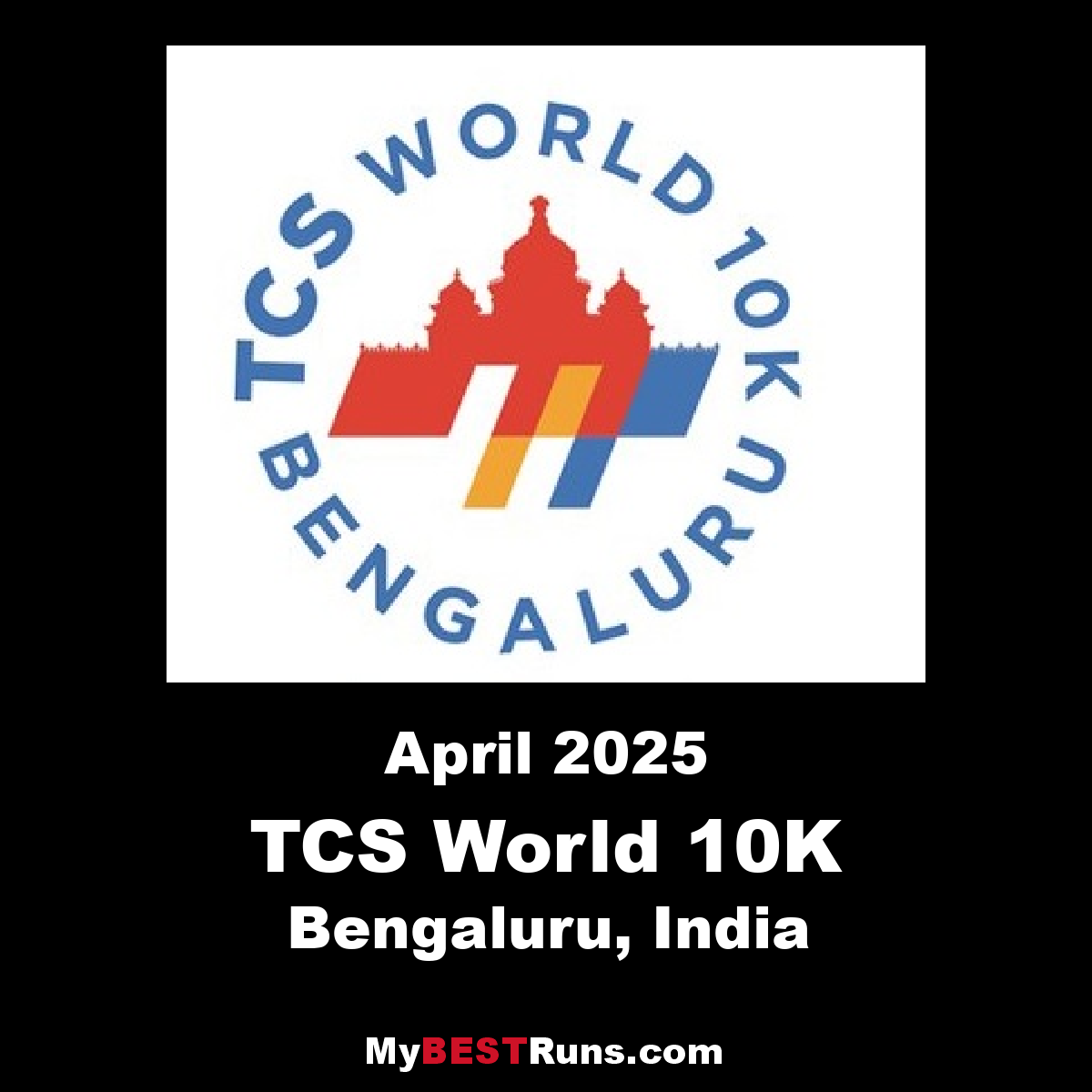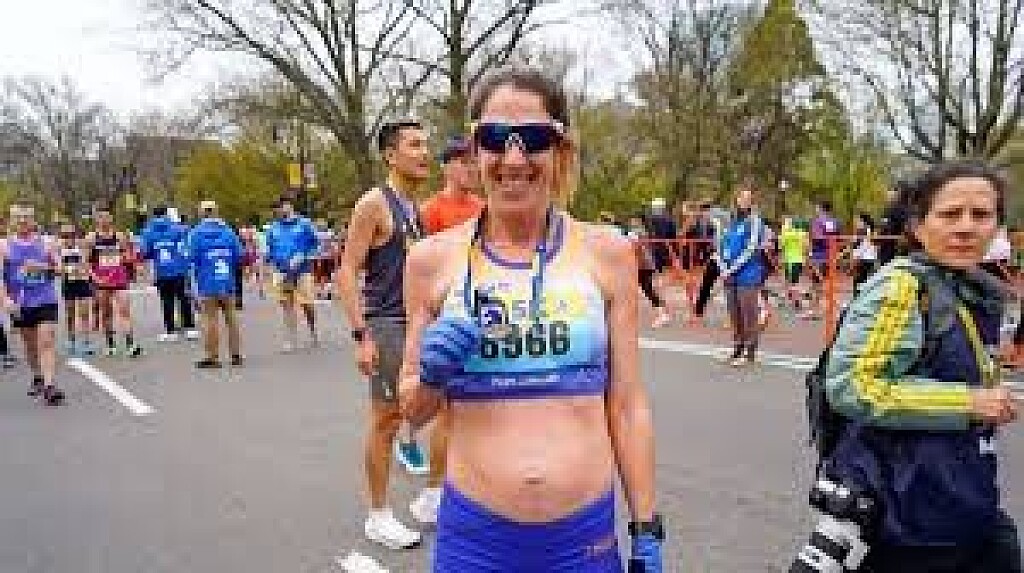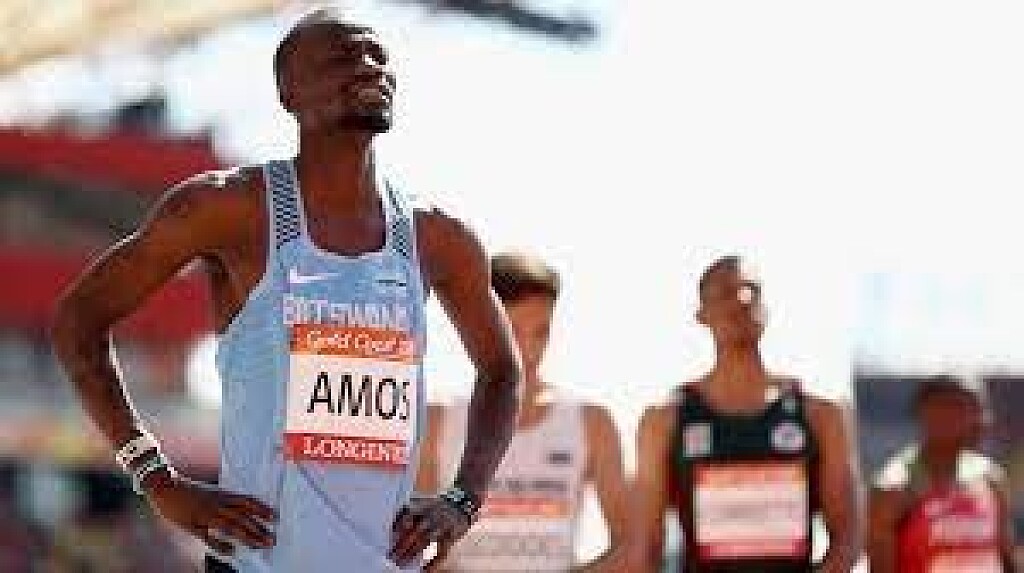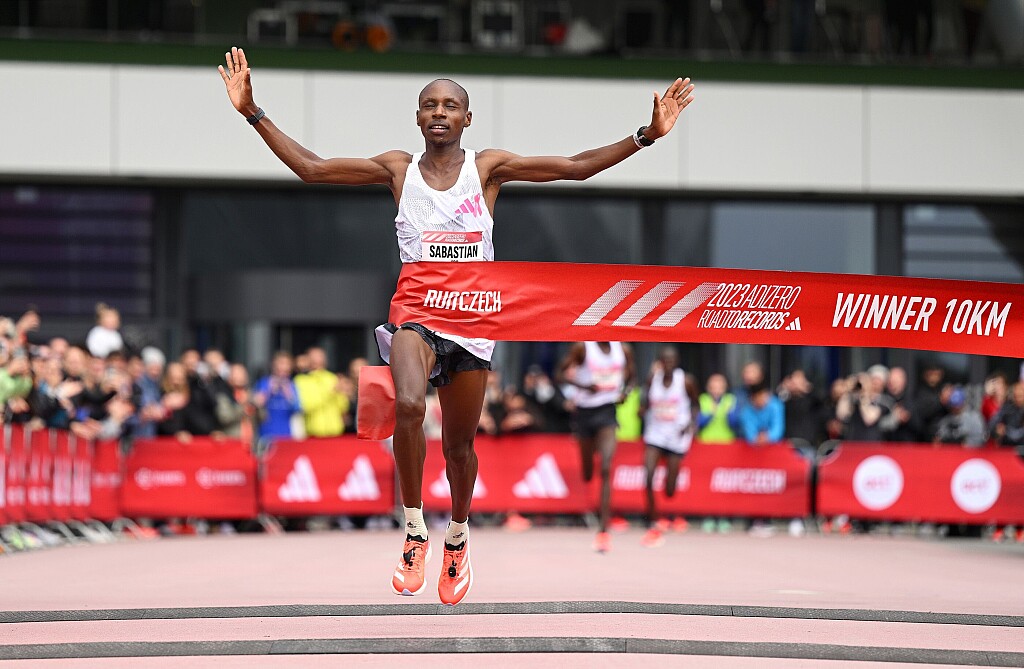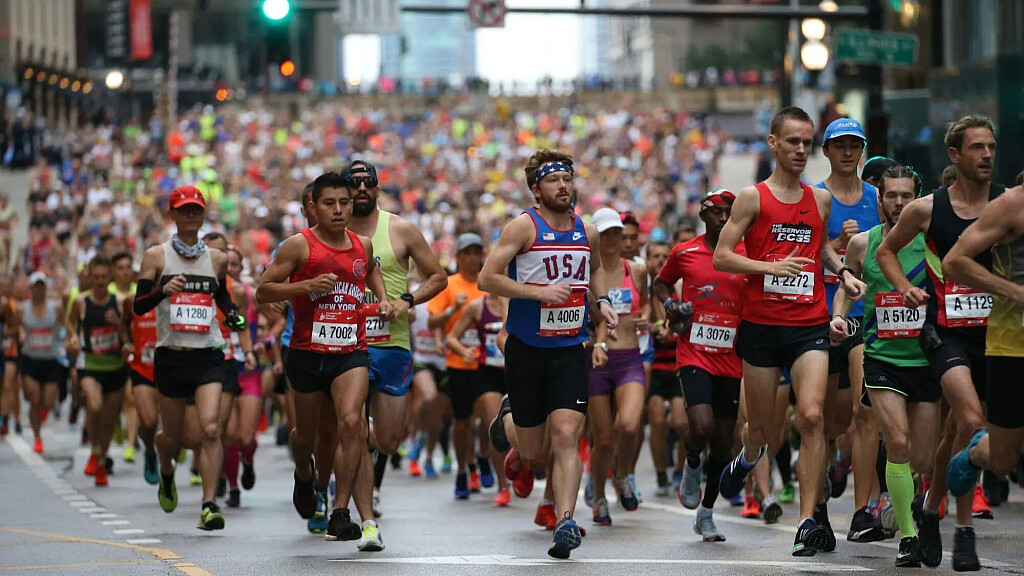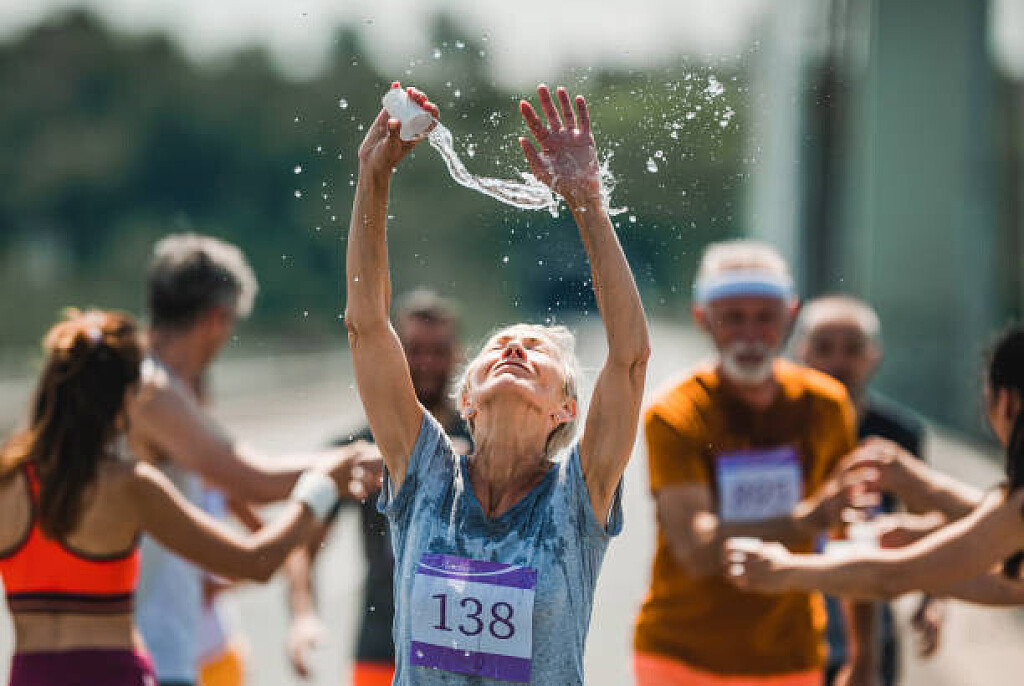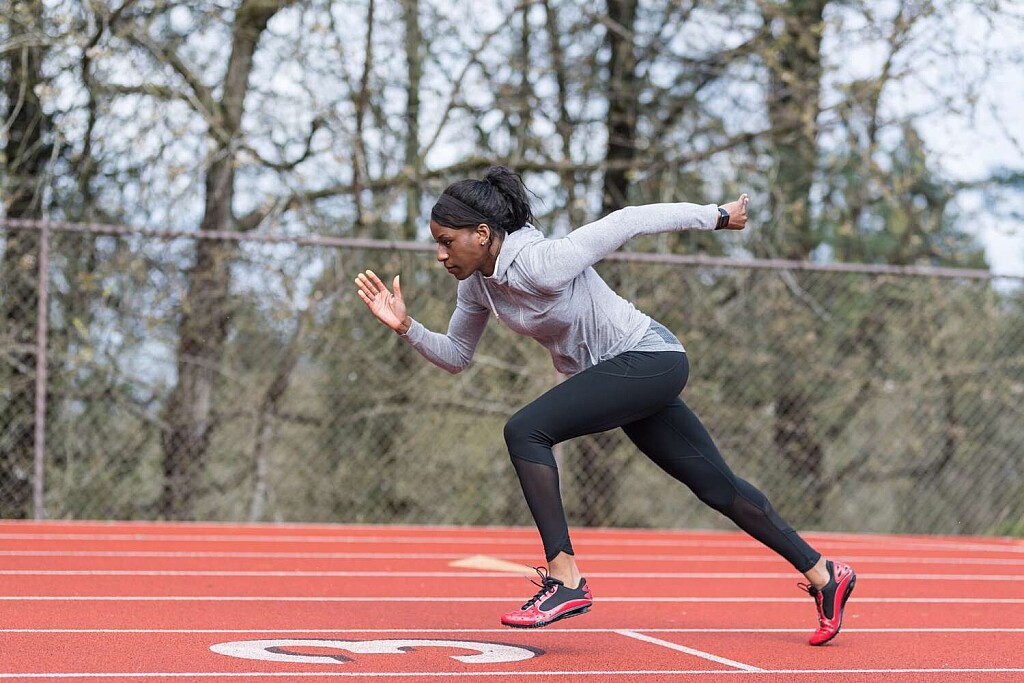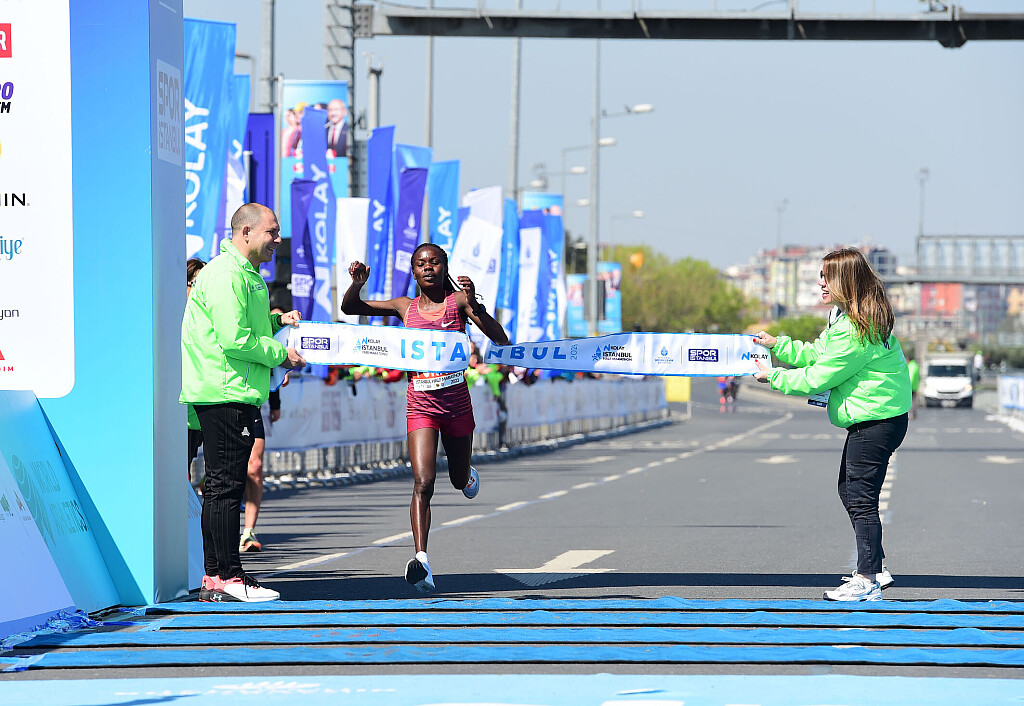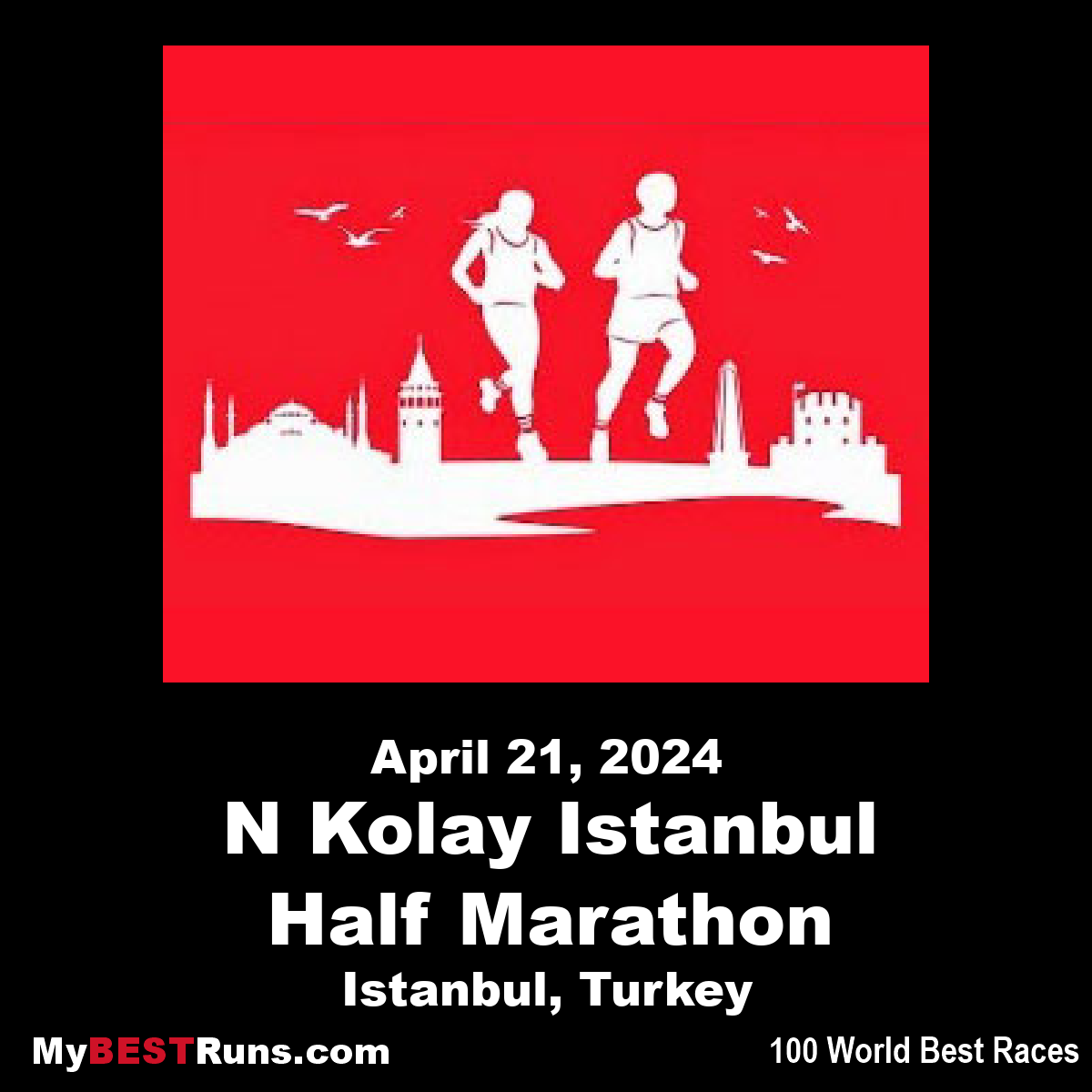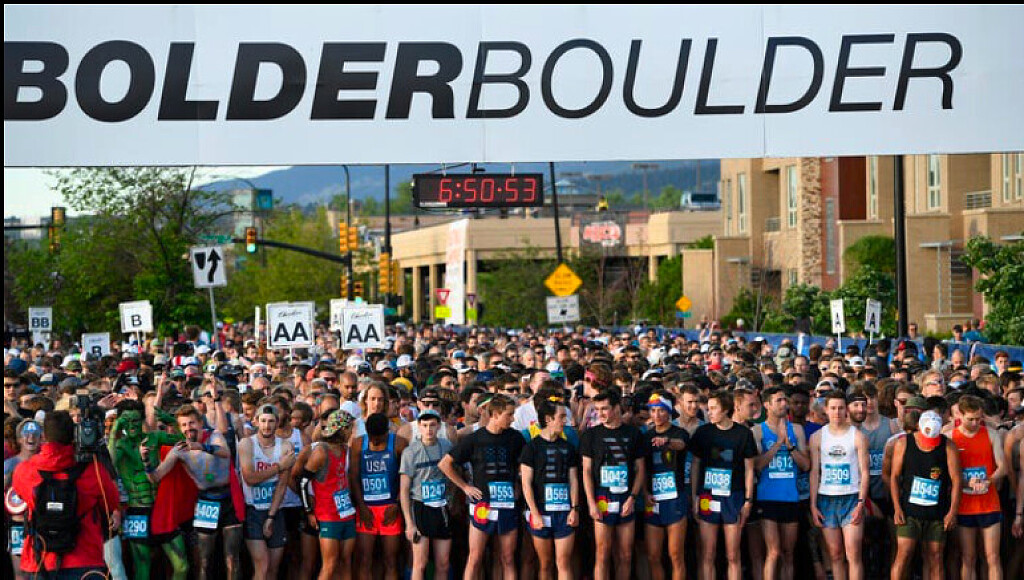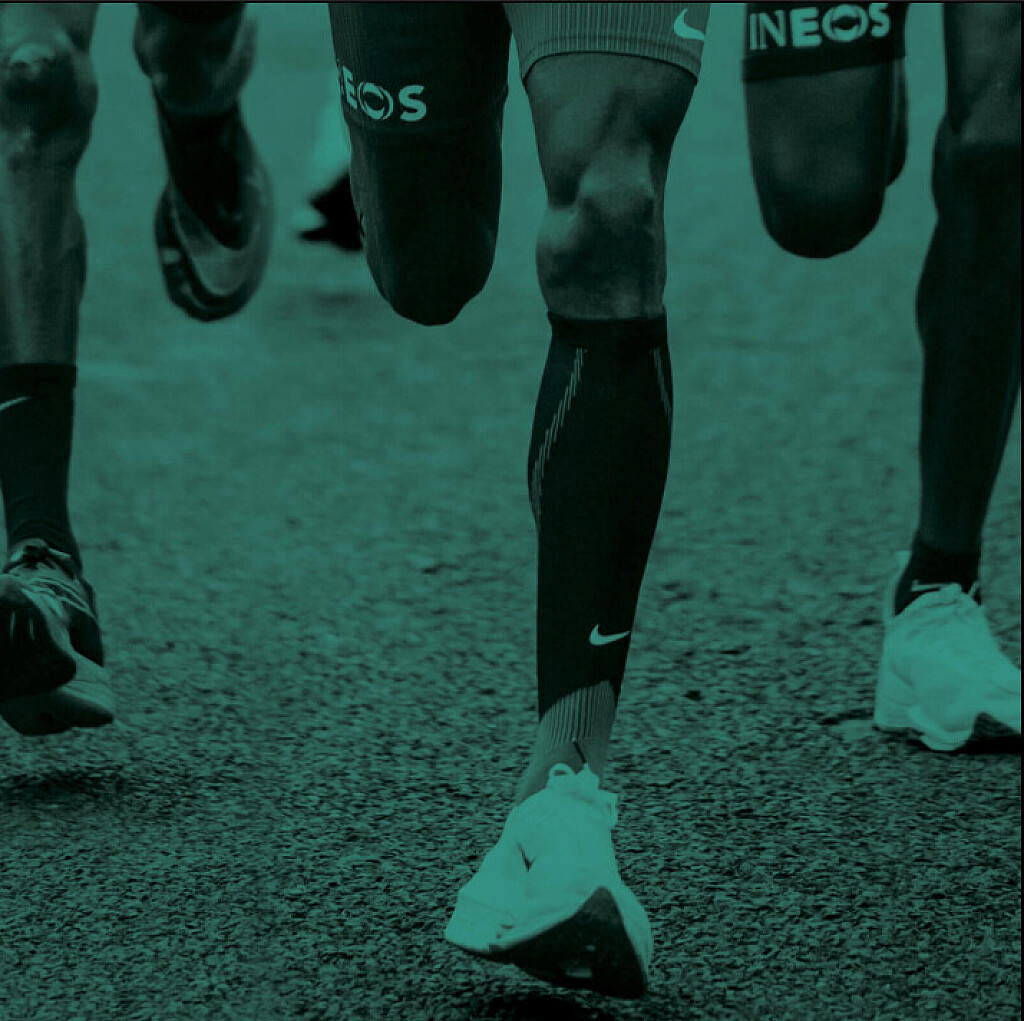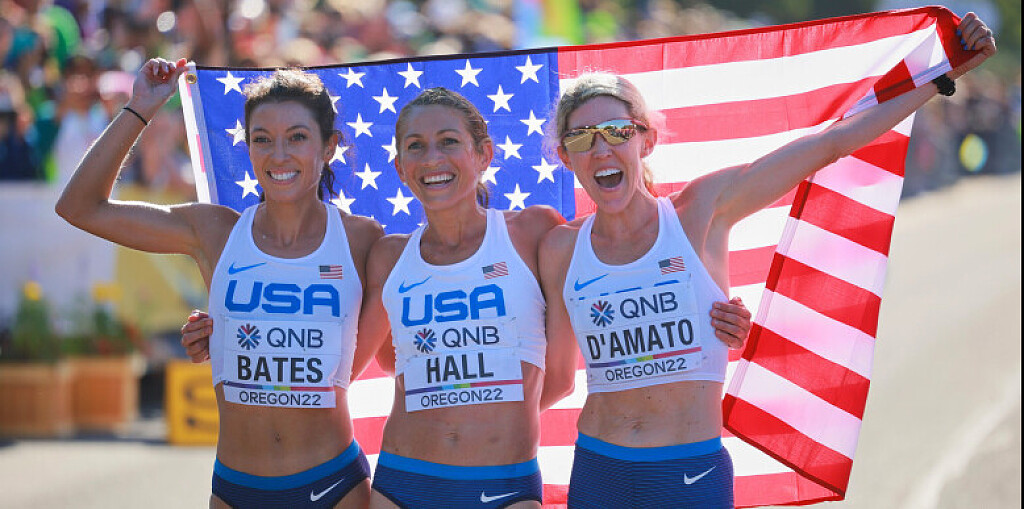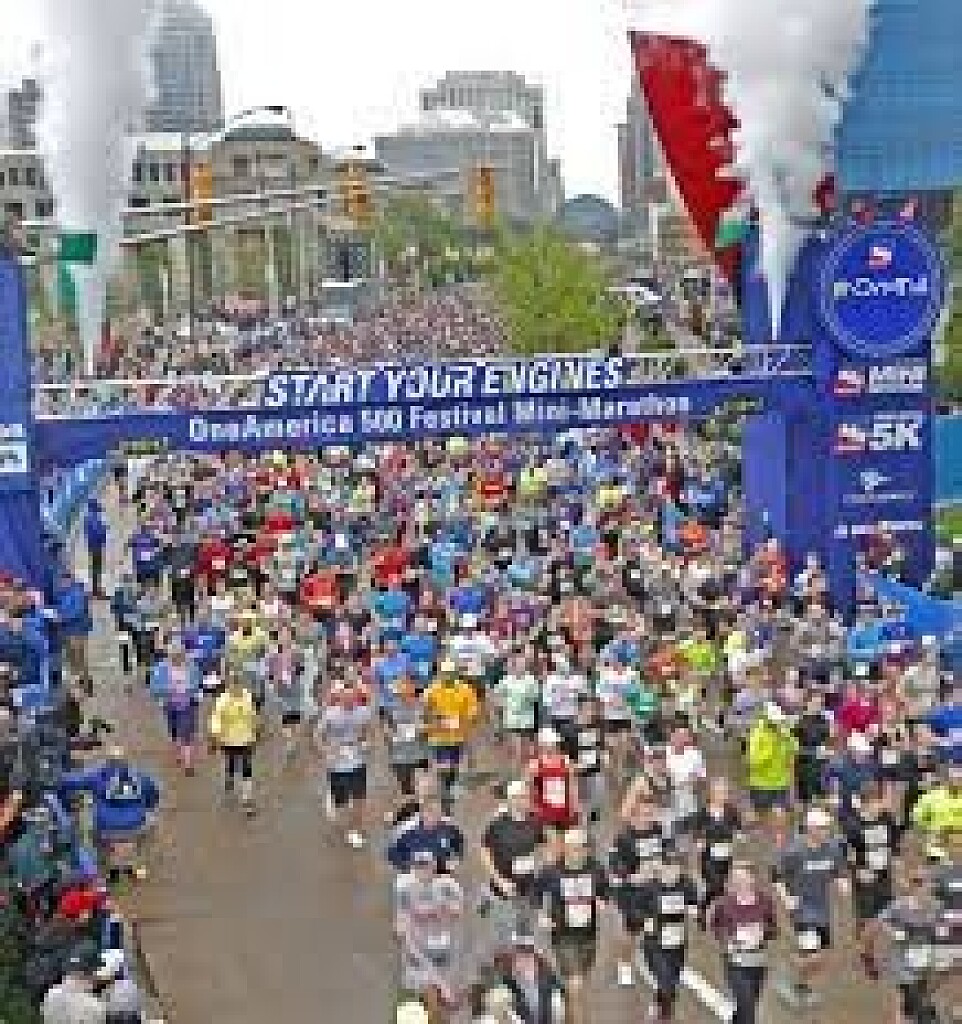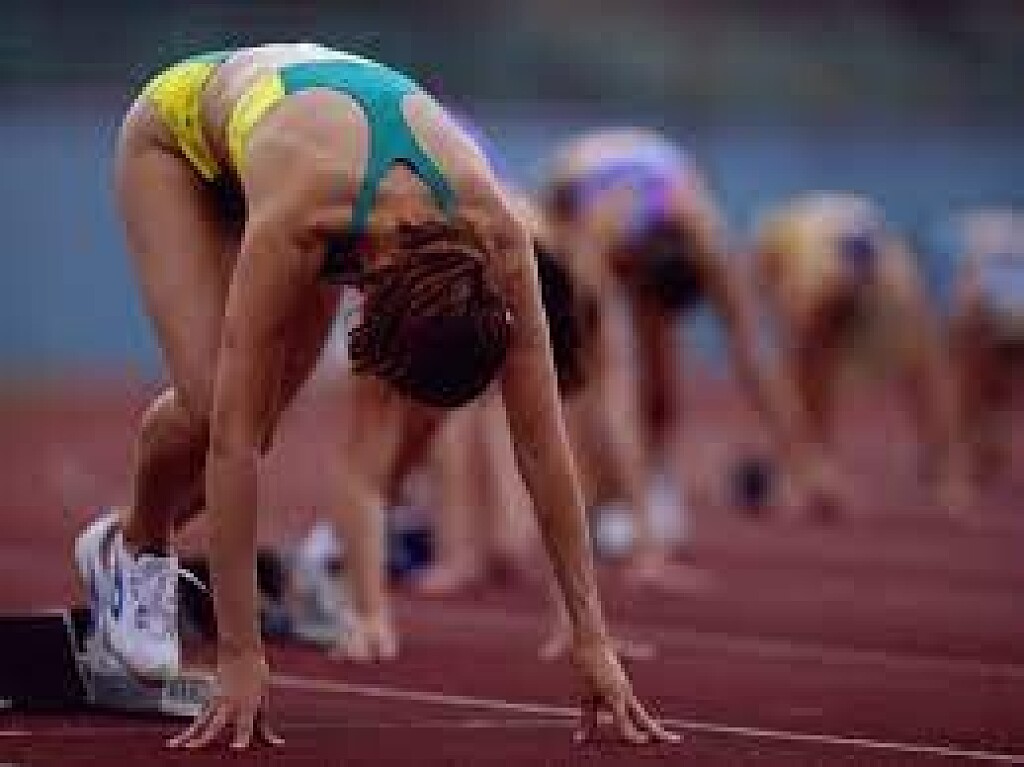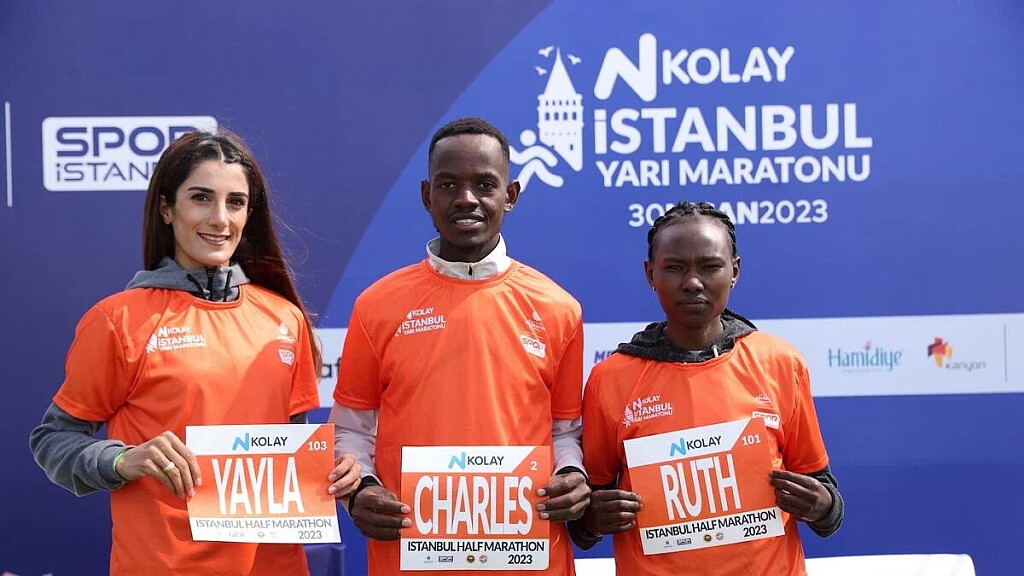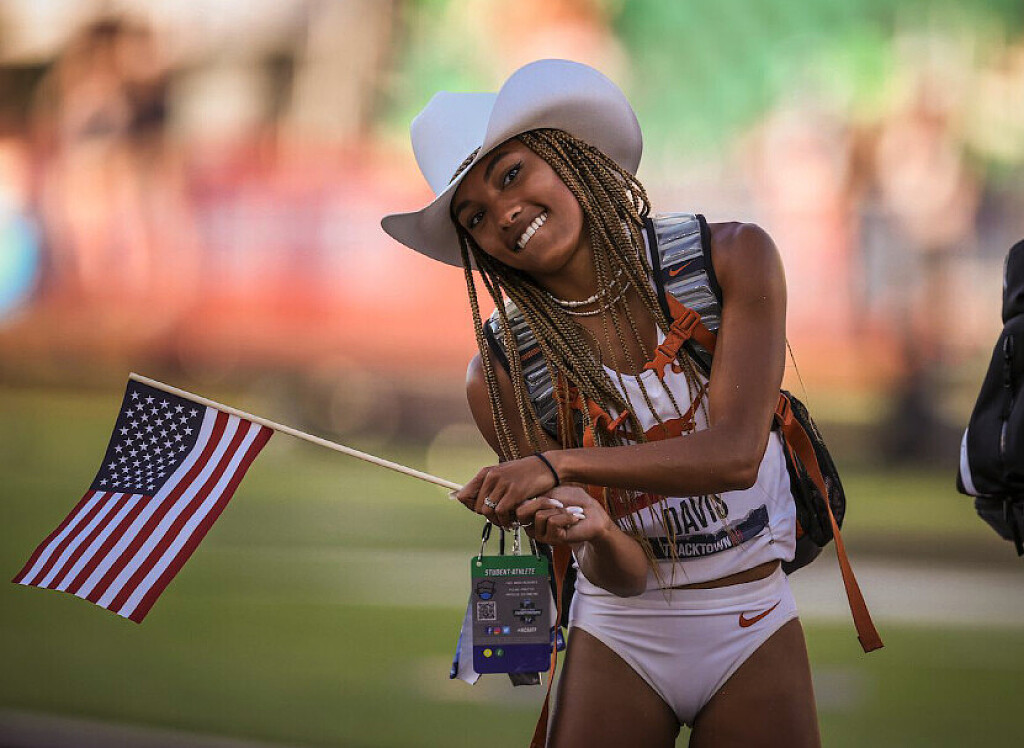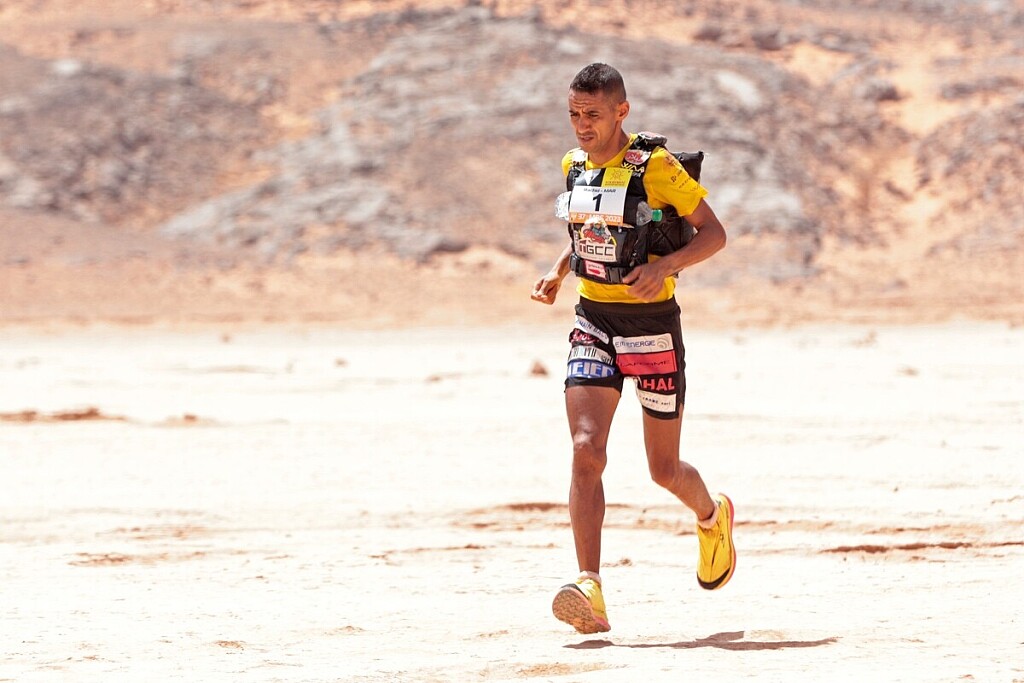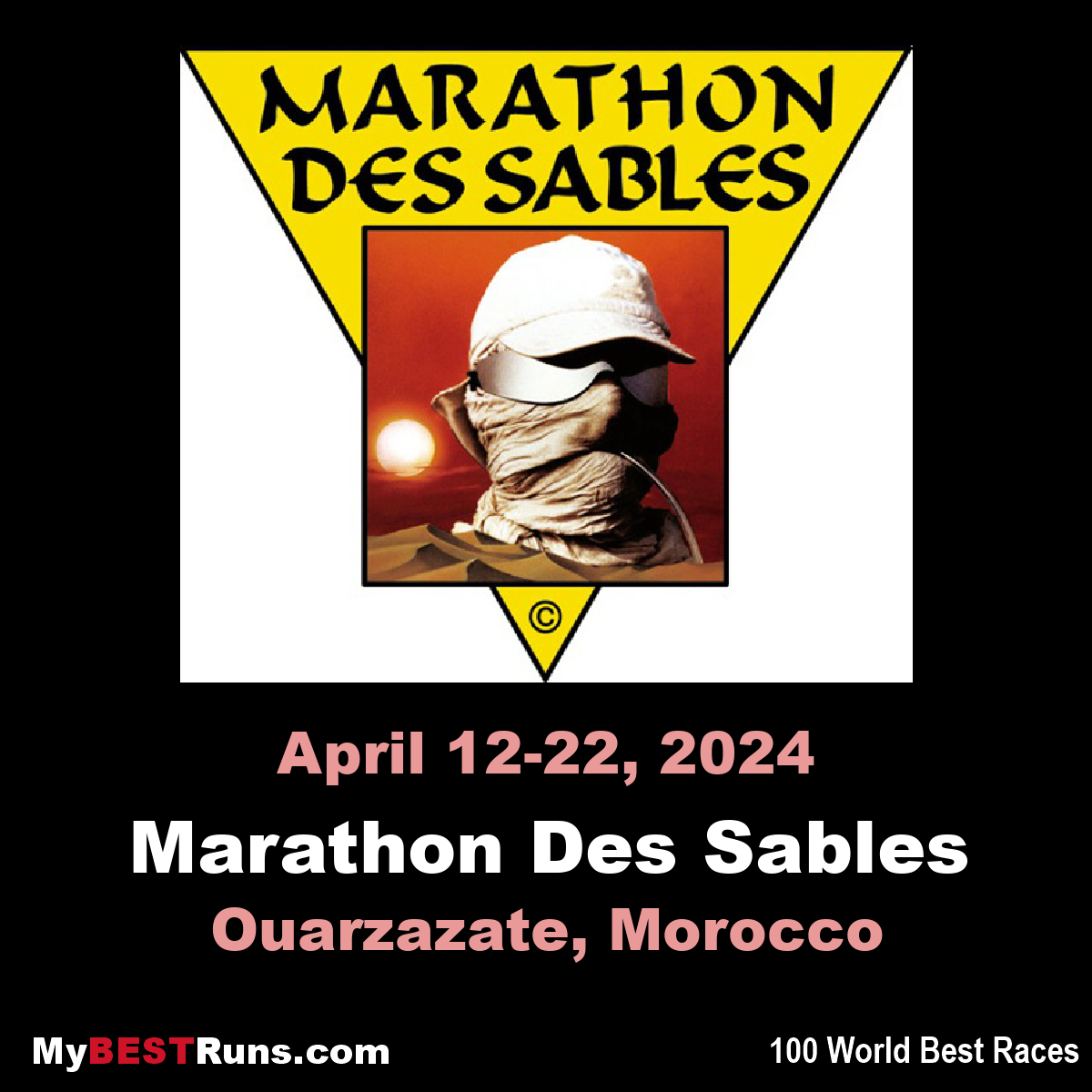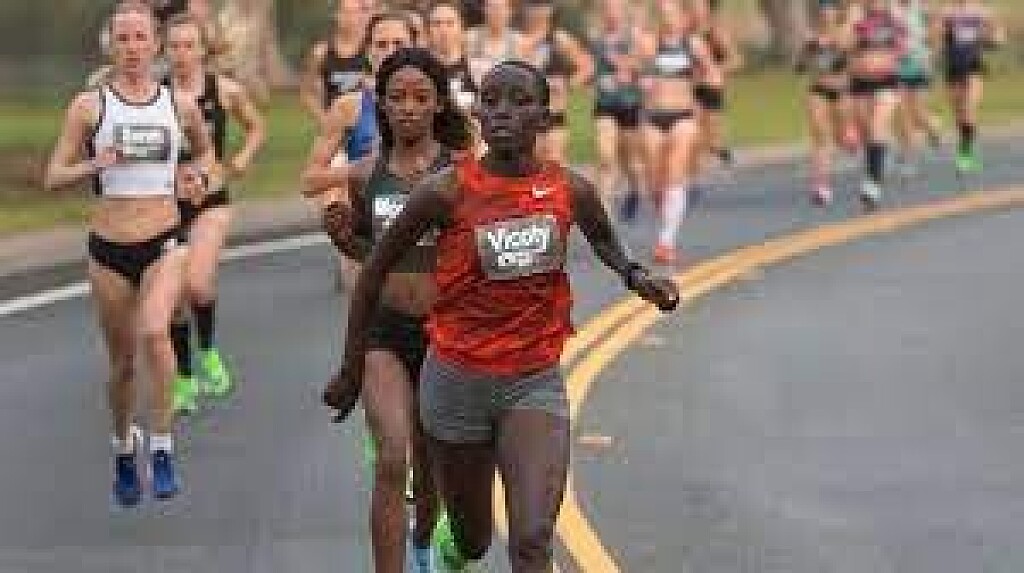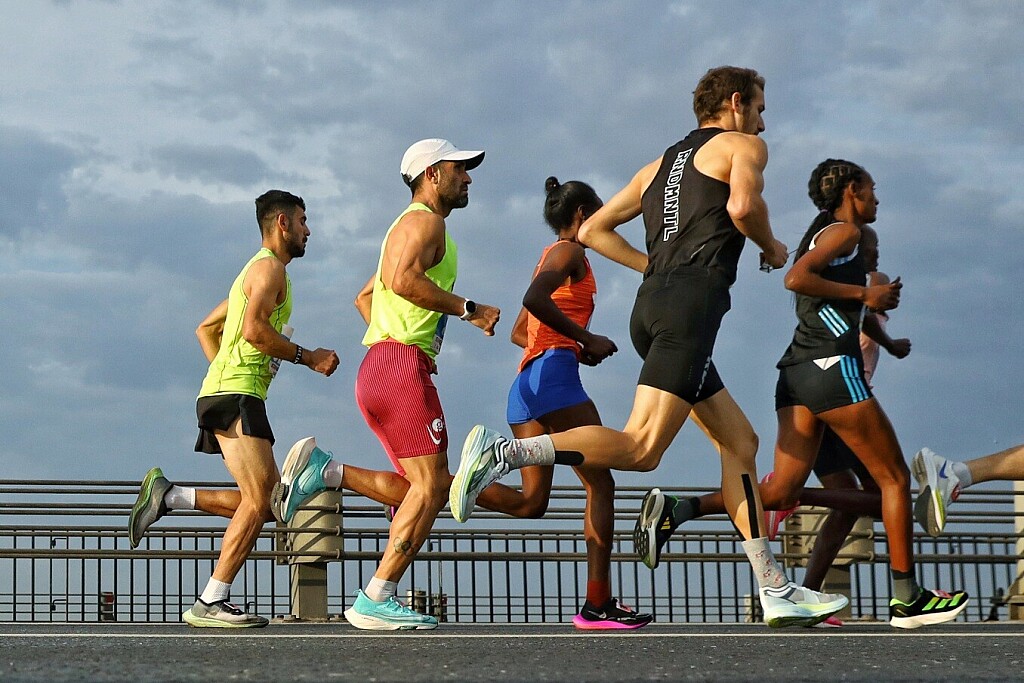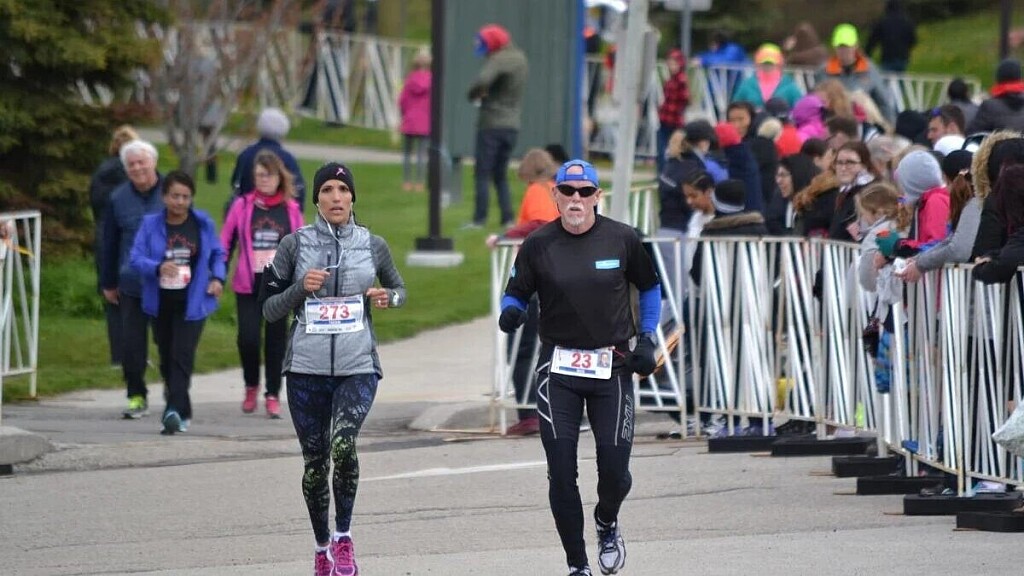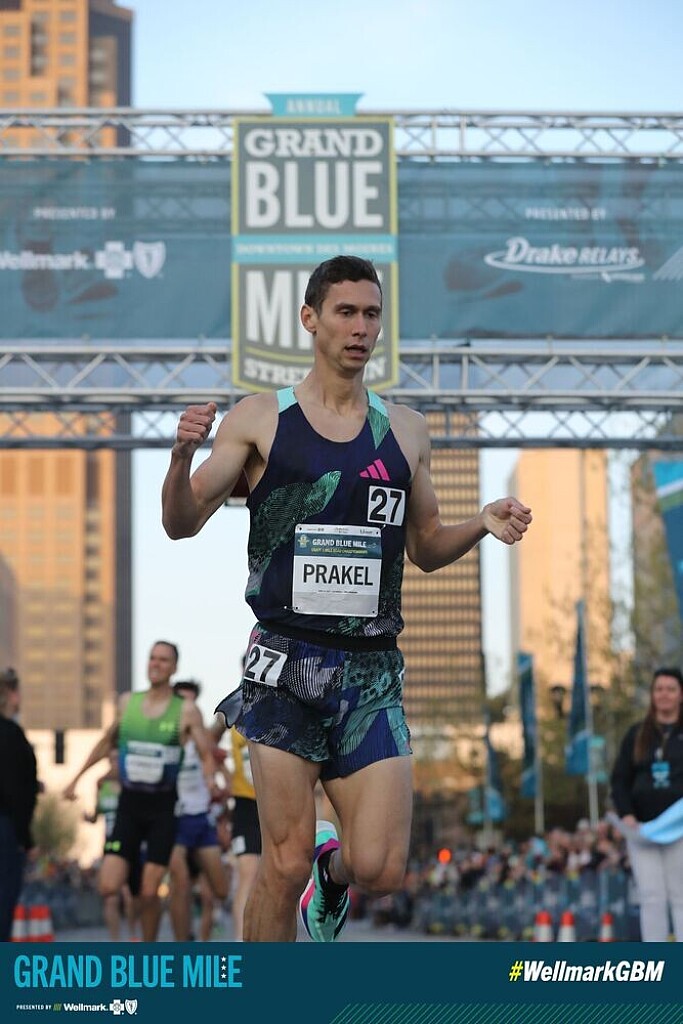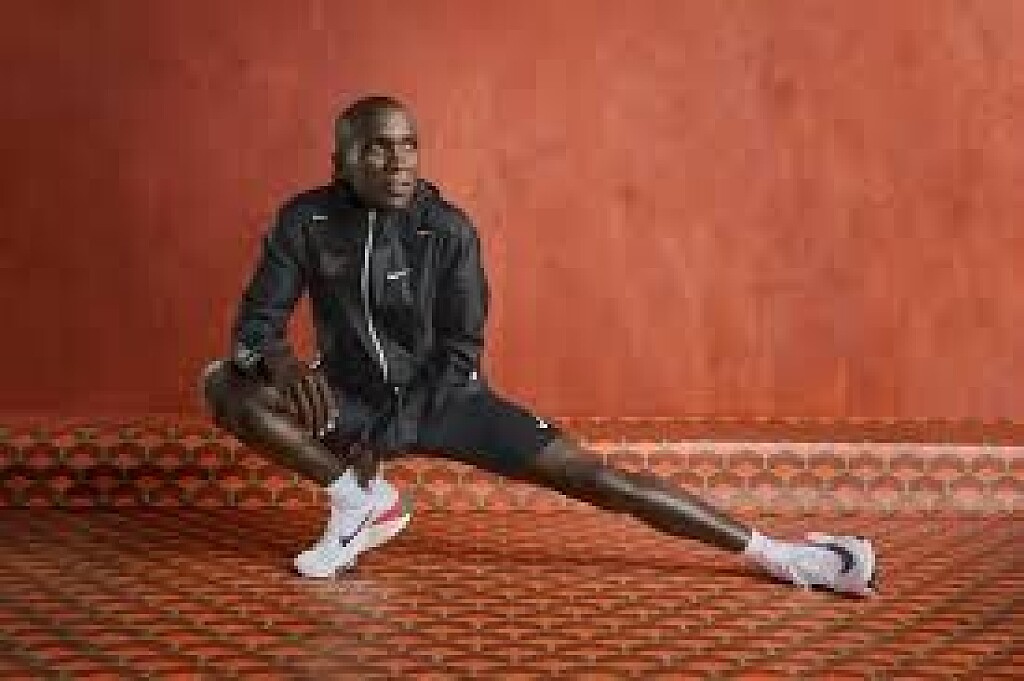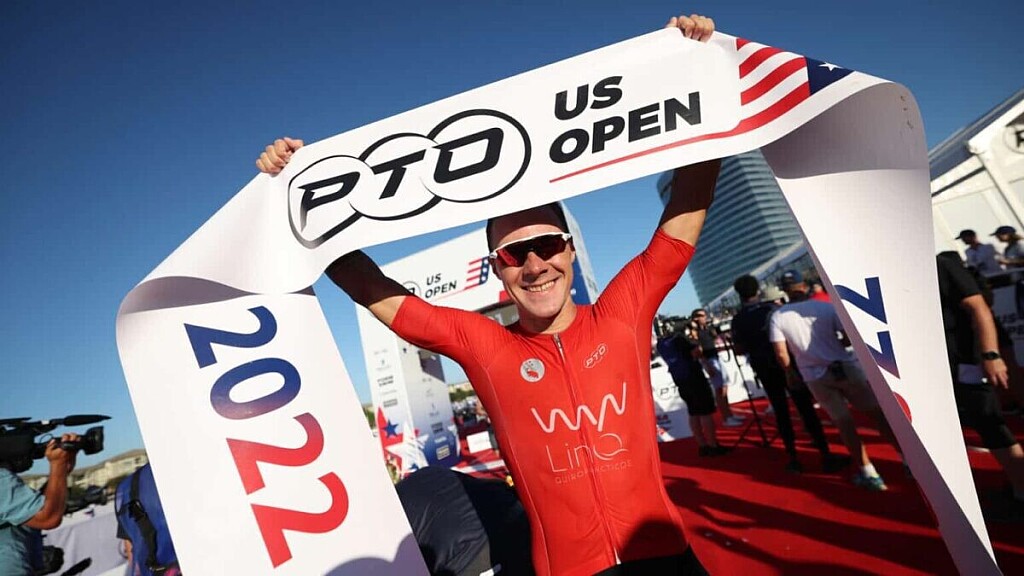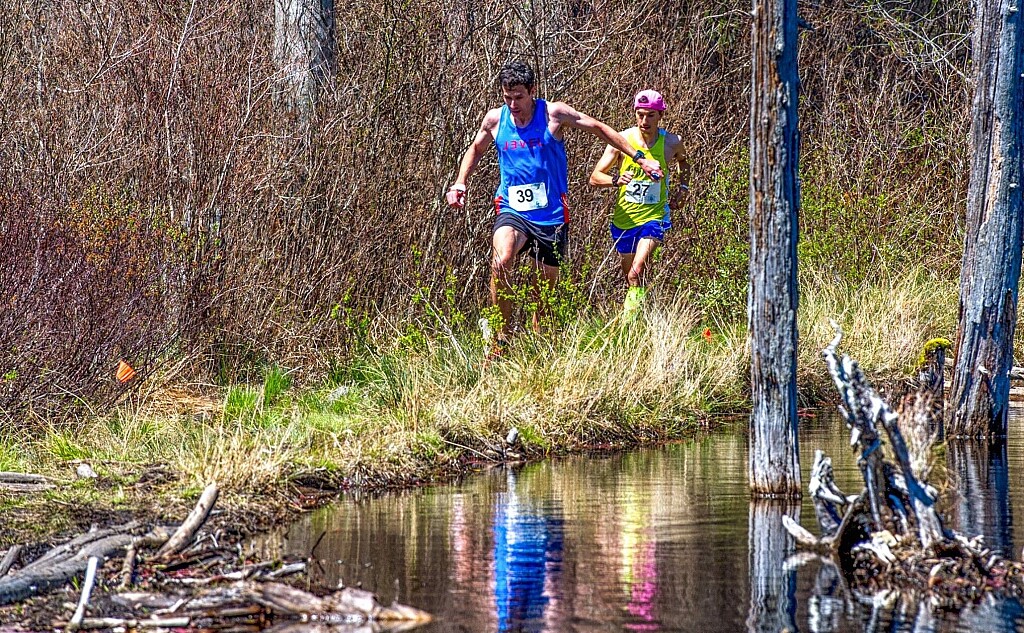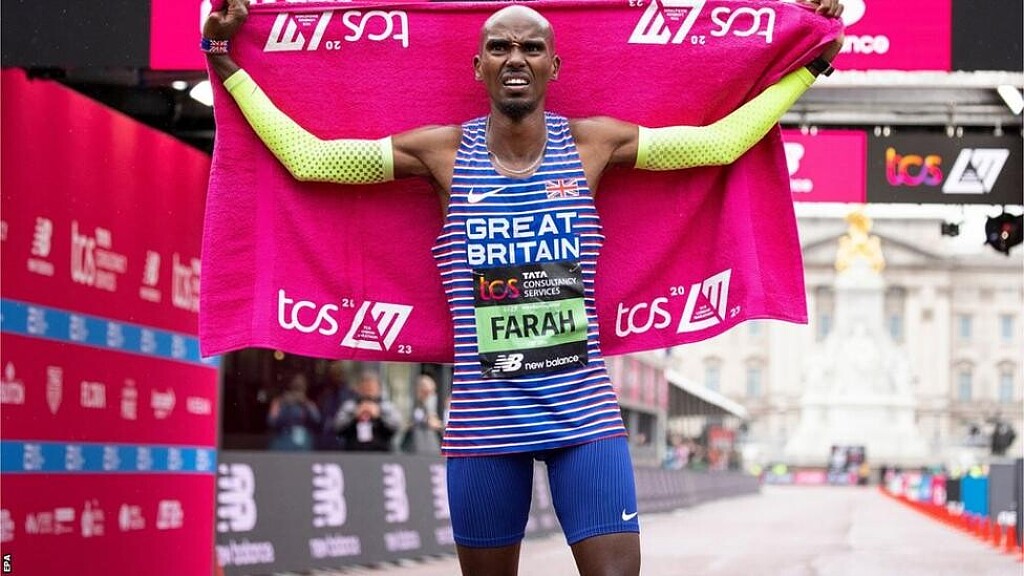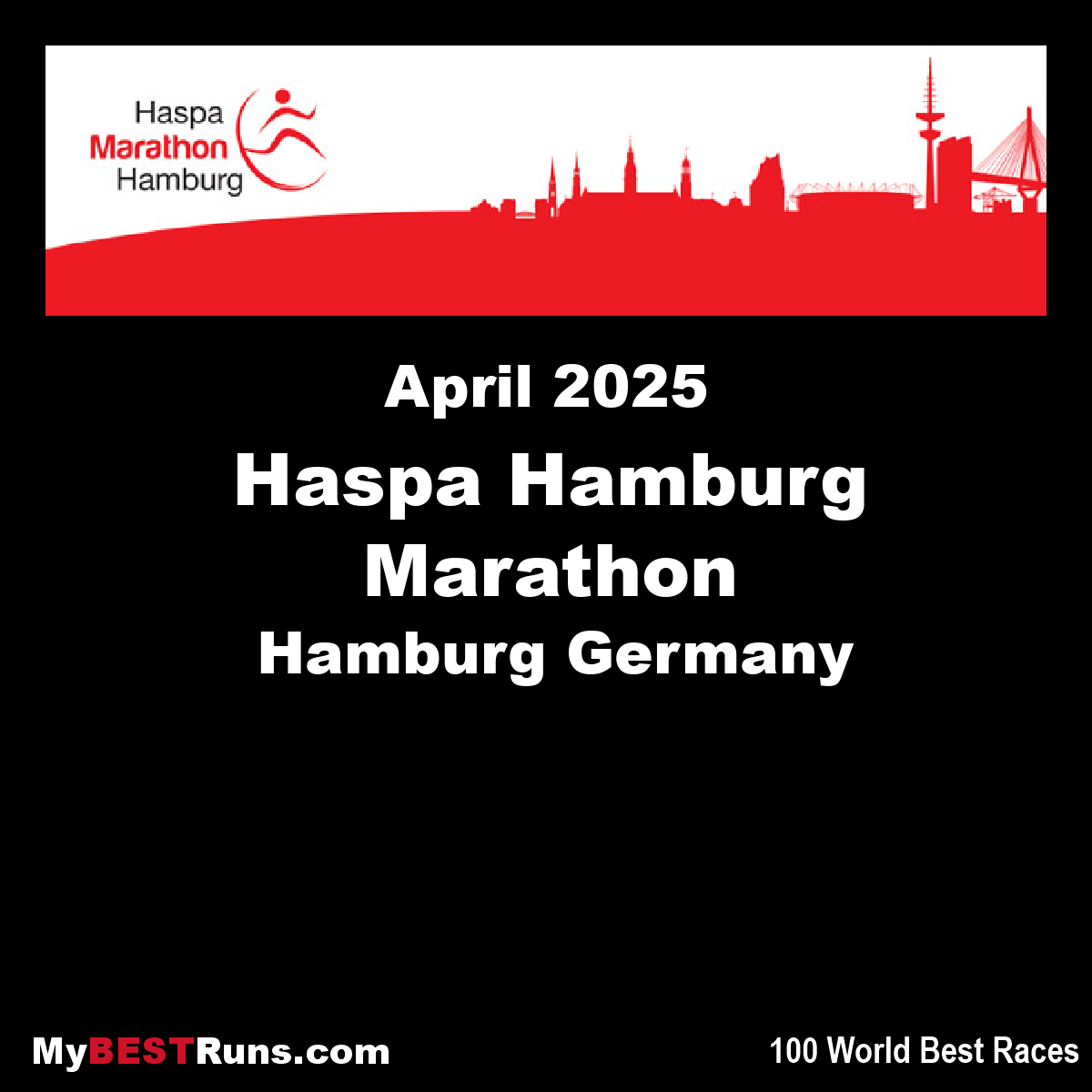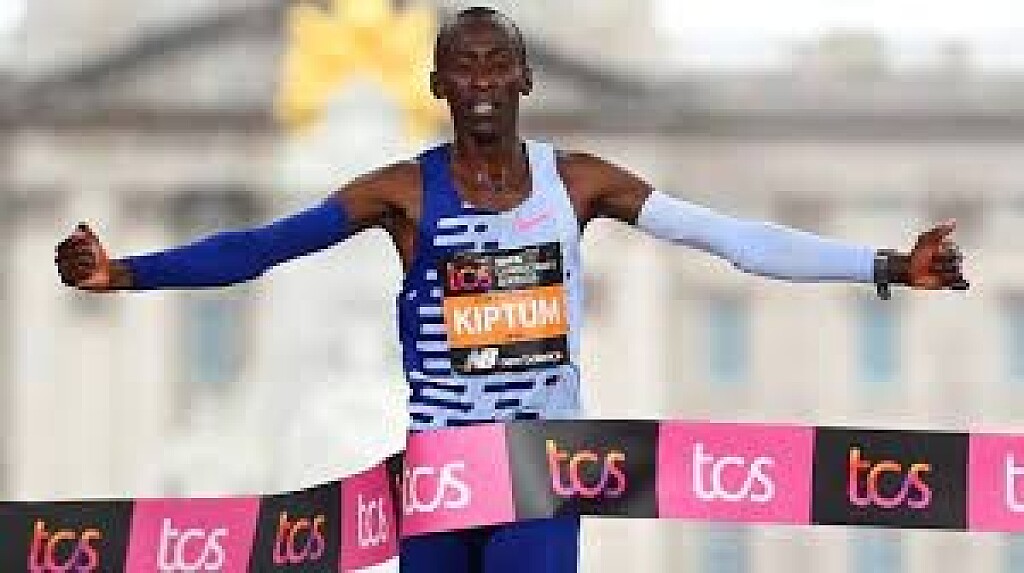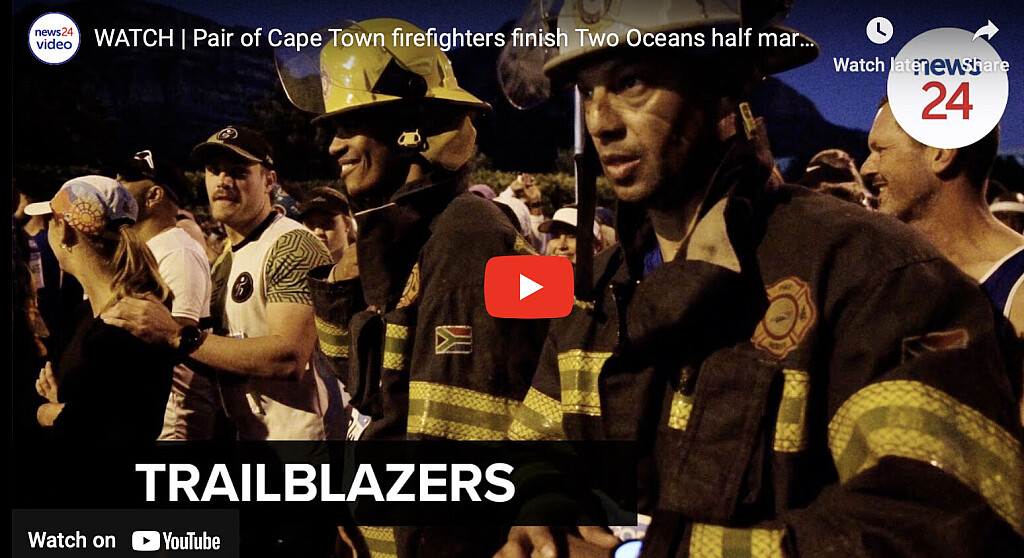Running News Daily
Running News Daily is edited by Bob Anderson in Mountain View, California USA and team in Thika Kenya, La Piedad Mexico, Bend Oregon, Chandler Arizona and Monforte da Beira Portugal. Send your news items to bob@mybestruns.com Advertising opportunities available. Over one million readers and growing. Train the Kenyan Way at KATA Running Retreat Kenya. (Kenyan Athletics Training Academy) in Thika Kenya. Opening in june 2024 KATA Running retreat Portugal. Learn more about Bob Anderson, MBR publisher and KATA director/owner, take a look at A Long Run the movie covering Bob's 50 race challenge.
Index to Daily Posts · Sign Up For Updates · Run The World Feed
After 6-year-old ran Flying Pig last year, the marathon is changing age rules
After last year's Flying Pig Marathon, there was outrage from Olympic runners, hundreds of critical comments on social media and even a report sent to child protective services.
All of this happened because a 6-year-old ran and completed the full race. Some people believed this was far too young for a 26.2-mile run.
This year, the race has drastically expanded its policy concerning the age of racers. Last year, the policy simply stated that no one under 18 could participate in the marathon unless they got an exemption from the race organizers. How and why those exemptions were granted was not defined.

New age rules and requirements for the Flying Pig Marathon in 2023
The updated policy states:

Participants must be 18 years of age on race day to participate in the marathon, 14 years of age on race day to participate in the half-marathon, and 12 years of age on race day to participate in the 10K and the relay.
There is no age requirement for distances less than 10K.
Waivers for participation in the half-marathon and marathon distances will be considered for those 12 years and older on race day.
Waivers for participation in the 10K or relay will be considered for all ages.
This year, the waiver process has also been more clearly defined. Those who are younger than the age limit must:
Have parental approval.
Have approval from a primary care physician.
Allow Pig Works medical staff to discuss participation with primary care physician.
Meet in-person or via phone with Pig Works medical staff.
Have a guide to participate with them throughout the duration of the event and/or provide a personal emergency action plan for race day contacts.
All waivers were required to be submitted at least 30 days before the race and are subject to the discretion of Pig Works, the non-profit that organizes the Flying Pig and several other area races.
Following the 2022 race, Pig Works CEO Iris Simpson Bush took responsibility for allowing the 6-year-old son of Ben and Kami Crawford race. The Crawford family of Bellevue, Kentucky, has a large social media following and has published a book about hiking the Appalachian Trail together.
"This decision was not made lightly because the father was determined to do the race with his young child regardless. They had done it as bandits in prior years before we had any knowledge and we knew he was likely to do so again," Simpson Bush said.
A "bandit" is someone who runs a race without being properly registered.
The Crawfords defended their decision to let their son race. Ben Crawford said his son had begged to participate and they were prepared to let him stop at any time. They produced a documentary about it.
The Crawford family did not reply to emails or messages on social media asking about their plans for the Flying Pig this year.
In a statement this year, Simpson Bush said about 40,000 people are set to participate in the Flying Pig Marathon and its associated races.
“The Flying Pig Marathon was created to provide opportunities for people of all abilities. The safety and security of everyone on the course from participants, volunteers and spectators remains our top priority," she said. "With that in mind, we review our policies every year with our medical team and our board of directors to ensure they provide safety for our event.”
(05/05/2023) ⚡AMPby Cameron Knight
Cincinnati Flying Pig Marathon
This beloved race found it's name from Cincinnati's pork history which dates back to the early 1800's. Cincinnati is also known as "Porkopolis."Our weekend line up of events are designed to welcome athletes of all abilities from the Diaper Dash to the full Marathon and everything in-between, we truly have something for everyone. We even added a dog race several...
more...Royal Victoria Marathon adds a 5K for 2023
This year’s Royal Victoria Marathon is set to take place on the weekend of Oct. 7-8, and in addition to the marathon, half-marathon, 8K and kids’ run, the race will be adding a 5K for the first time. Also, events will be staggered across two days, with the Oak Bay 5K and Thrifty Kids Run taking moving to the city’s Oak Bay neighbourhood on Saturday, Oct. 7. The marathon, half-marathon and 8K will take place, as usual, on Sunday, Oct. 8, starting and finishing in downtown Victoria.
The Oak Bay 5K will follow an out-and-back course along the Esplanade, Estevan and Beach Drive, starting and finishing at Willows Park. Registration is $30; the race is chip-timed, and registrants will receive a finisher’s medal and toque.

The RVM is celebrating the arrival of the 5K and helping participants prepare for the race by partnering with thetrackclub.ca to offer a one-month training program for the 5K, including four in-person sessions at the Pacific Institute for Sport Education (PISE).
The Thrifty Foods Kids Run will also start and finish at Willows Park. Registration is $25, with proceeds to KidSport Greater Victoria. Registrants may choose between a souvenir toque and reflective light, race bag and race number.
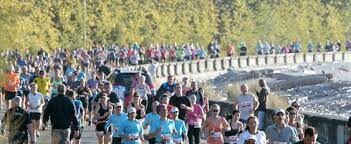
“We are excited to be adding a new distance to our lineup this year and hosting both the 5K and the Thrifty Foods Kids Run in Oak Bay,” RVM race director and general manager Cathy Noel said in a press release. “Moving the events to Oak Bay allows us to show off this wonderful community as well as provide an opportunity for participants to take part in a shorter event on the Saturday, and if feeling up for the challenge, take on one of our other distances on the Sunday!”
KidSport Greater Victoria executive director Jill Shaw added that the move to Willows Park on Saturday would “provide a safe and exciting space for our youngest participants. For those past Kids Run participants who are now ready for the challenge of a little more distance than the Kids Run route offers, the 5K is a fantastic stepping stone.”
The race’s Community Challenge charity program, which will return for its 19th year this year, has raised over $2.5 million for partner charities.
(05/05/2023) ⚡AMPby Anne Francis
Royal Victoria Marathon
We are one of Canada's premier running event, offering athletes an unmatchable running experience on the pristine West Coast. Our world-class, record-breaking course is designed by runners, for runners. As the only Certified Boston Qualifier on Vancouver Island, come join us to compete, to conquer and to move from warm-up to reward. ...
more...Kenya's track sensation Mary Moraa has her eyes firmly focused on a World Championship conquest in Budapest later in the year
Barely in her 20s, Kenya's track sensation Mary Moraa is already hogging the global limelight and stealing headlines at whim.
The 2022 Commonwealth Games 800 metres gold medallist has rocked premier global athletics shows in recent years to deservedly cut herself a niche in the Hall of Fame.
Fondly known as "The Kisii Express" by her dotting fans, Moraa has already claimed her space in the cutthroat world of athletics. Undoubtedly, the decorated track prodigy deserves every ounce of international acclamation.

Only recently, she set a new PB in April after storming to the 400m title at the Botswana Golden Grand Prix in an astonishing time of 50.44.
The sublime performance she pulled off in the blistering contest saw her smash her previous national record by 0.24 seconds, subsequently attaining the World Athletics Championships qualifying standards of 51.0 seconds.

"My previous 400m best was 50.67, which I attained at the Diamond League meeting in Brussels in September."
In Botswana, the two-lap specialists obliterated a stellar field that boasted Olympic and world finalist Candice McLeod of Jamaica, USA’s Kyra Jefferson, and the Botswana duo of Naledi Lopang and Thompang Basele.
She breezed to victory ahead of South Africa’s Miranda Coetzee and McLeod who crossed the line in 51.13s and 51.17s respectively.
She rallied from behind to take the lead with 30m to go on her way to the winner's podium at the National Stadium, Gaborone.
Moraa smashed the national record when she won the Kenyan trials for World Championships and Commonwealth Games in 50.84 on June 25, last year at the Moi Stadium, Kasarani.
Moraa, 23, has vowed to step into the big shoes of her role model Hellen Obiri, the middle and long-distance track sensation.
"I've always admired Obiri. I grew up watching her clinch titles and her amazing performances have inspired me a great deal. To an extent, there is a part of her that lives in me. I just want to be exactly like her," Moraa said.
"To date, Obiri still inspires me a great deal and I'm eager to emulate her success on the international stage," she added.
Indeed, Moraa has every reason to admire Obiri. She is the only woman to have won world titles in indoor track, outdoor track, and cross-country races.
Notably, Obiri is a two-time Olympic 5000 metres silver medallist from the 2016 Rio and 2020 Tokyo Olympics, where she also placed fourth over the 10,000 meters.
She is a two-time world champion, having claimed the 5000 m title both in 2017 and 2019 when she set a new championship record.
Obiri also tucked away a bronze in the 1500 metres during the 2013 World Championships and a silver in the 10,000 m in 2022.
She won the 3000 meters race at the 2012 World Indoor Championships, claimed silver in 2014, and placed fourth in 2018. She romped to the 2019 World Cross Country title and triumphed in the 2023 Boston Marathon.
Moraa said she and Obiri share a lot in common. Besides being compatriots, Moraa is elated they hail from the same county.
Coached by seasoned National Police athletics team gaffer Alex Sang, Moraa has her eyes firmly trained on a World Championship conquest in Budapest, Hungary later in the year.
She said she intends to run the 800m race at the World Championships in Budapest, Hungary in August, adding that she is determined to breast the tape in under two minutes.
Born on June 15, 2000, Moraa attended Nyangononi Primary School in Bassi Borabu, Kisii County where she sat for her Kenya Certificate of Primary Education (KCPE) in 2014.
Her potential in athletics came to the fore at Nyangononi when she ran away with several titles in the sprints and middle-distance races.
"I stamped authority in 100m, 200m, 400m, and 800m and even shattered the 400m East Africa school games record in 2014," Moraa proudly recounted.
Upon completing her studies, Moraa proceeded to Ibacho Secondary School in Kisii County but lasted there for only two years before transferring to Mogonga PAG Mixed secondary school where she sat for her Kenya Certificate of Secondary Education (KCSE) in 2018.
"While at Ibachi, I experienced difficulties paying my school fees and it was the principal who would chip in most of the time. Unfortunately, he got transferred from the school and I was left stranded.
"I later joined Mogonga Mixed Secondary School, where I got a lot of support from the principal who also happened to be my coach."
An orphan from a disadvantaged background, Moraa got financial help from her school principal Aron Onchonga who paid all her school fees at Mogonga. Indeed, aside from affording her pertinent financial assistance, Onchong'a played a key role in honing her skills and carving her path to stardom. It was during her years in Mogonga that Moraa started jutting out her talons on the track.
"I am grateful to the school administration and the Principal for the moral and financial support they gave me while there."
During my years in Mogonga, I wanted to remain a role model to the young girls who shied away from sporting activities. I was determined to train and participate in various activities even after completing school," said Moraa.
(05/05/2023) ⚡AMPby Tony Mballa
World Athletics Championships Budapest 23
From August 19-27, 2023, Budapest will host the world's third largest sporting event, the World Athletics Championships. It is the largest sporting event in the history of Hungary, attended by athletes from more than 200 countries, whose news will reach more than one billion people. Athletics is the foundation of all sports. It represents strength, speed, dexterity and endurance, the...
more...2024 TCS London Marathon receives more than half a million applicants
The 2024 TCS London Marathon has set a world record by receiving the most applications ever to be submitted to a marathon.
Marathon organizers say 578,374 hopefuls from the United Kingdom and across the globe entered the ballot for the 2024 TCS London Marathon, marking the first time the number of applications to a marathon has topped half a million. The previous world record total of 457,861 applications was set pre-pandemic in 2019 for the 2020 London Marathon.

Almost 53 per cent of the 457,105 applications from U.K. residents for 2024 were from men and 46.4 per cent were from women; the non-binary category received 0.6 per cent of total U.K. applications. A further 121,269 non-U.K. residents applied on the international ballot.
“This incredible new world record reflects the extraordinary inspirational effect of the TCS London Marathon on April 23,” says Hugh Brasher, event director for the TCS London Marathon. “We saw a record number of more than 48,600 finishers on marathon day and more than 8,200 children took part in the mass TCS Mini London Marathon the day before.”

Brasher said marathon organizers work “to inspire activity in people of all ages and abilities and these record-breaking numbers show how the TCS London Marathon weekend does that. The unique camaraderie and togetherness that participants feel when they take part in the London Marathon continues to have an extraordinary impact on the desire for people to take part. It is an event that inspires people to take up running and to raise millions for charity.”
The ballot for the 2024 TCS London Marathon was operated for the first time by Let’s Do This as part of a new five-year partnership. Founded in 2017 and headquartered in London, LDT is the registration partner to many of the leading running events around the world.
The TCS London Marathon always attracts a strong contingent of Canadian runners, however, there were no Canadians in the elite field in the 2023 event. Sam Hunt was the first Canadian to cross the finish line this year with a time of 2:37:38. Meaghan Strum was the fastest Canadian woman, in 2:52:06. The only Canadian runner in the non-binary category was Christy Dadswell, who finished in 3:46:38.
(05/04/2023) ⚡AMPby Paul Baswick
TCS London Marathon
The London Marathon was first run on March 29, 1981 and has been held in the spring of every year since 2010. It is sponsored by Virgin Money and was founded by the former Olympic champion and journalist Chris Brasher and Welsh athlete John Disley. It is organized by Hugh Brasher (son of Chris) as Race Director and Nick Bitel...
more...Kibiwott Kandie set sights on warm-up events ahead of Budapest
Commonwealth Games 10,000m bronze medalist Kibiwott Kandie has said he will grace as many events as possible as he eyes a World Championship conquest in Budapest Hungary in August.
In an exclusive interview on Wednesday, the 2020 World Half Marathon silver medallist said he had already gauged his potential in two global events this year and noticed an impressive rise in his curve.

The latest of his conspicuous achievements is the scintillating form he pulled off at the Adizero Road to Records event in Herzogenaurach, Germany, on April 29.
Kandie emerged second behind compatriot Sabastian Sawe who stormed to the title in 26:49 to move fifth on the men’s world 10km all-time list.

Kandie said the outcome attests to the fine form he currently enjoys after recuperating from injuries sustained earlier.
"I successfully competed in the 10km Road to Records race in Germany on Saturday and I was lucky to finish second in 26:53. This is a great result after recovering some injuries," Kandie said.
"I'm glad I'm gradually brushing off injuries in the past two years that locked me out of the 2021 Tokyo Olympics as well as last year’s World Championships in Oregon and the Commonwealth Games in Birmingham," he added.
The Kenyan contingent claimed a clean sweep with Nicholas Kipkorir Kimeli coming third in 26:54. World record-holder Rhonex Kipruto secured a fourth-place finish in 27:09 as Levy Kibet wrapped up the top-five in 27:14.
"My intention was to check my shape on a faster 10k road race abroad as we head to the World Championships in August," he added.
Kandie said he is limbering up to flex muscles at the upcoming Kenya Defence Forces Athletic Championships, adding that he intends to leverage every competition that comes his way.
"At the moment, I am preparing for the KDF championship as well as the World Championship trials later on," Kandie said.
"All I can hope for is a positive result in Budapest. My training has been superb and I aim to keep up the effort. That's why I performed so well in the 10k road race," he remarked.
Kandie reflected on his historic performance in Birmingham, revealing that earning a bronze medal at the Commonwealth Games had inspired him to punch above his weight at the next World Championships when he will aim for nothing less than a gold medal.
Kandie made an impressive track debut, winning bronze at the Birmingham 2022 Commonwealth Games after he accepted a challenge from NOC-K President Paul Tergat to run the 10,000m race.
"Since it was my first international track meet, winning bronze was a huge accomplishment. This was sufficient proof that I can achieve more not only on the road but also on the track.
"I'm working particularly hard to make a name for myself at the World Athletics Championships, where I'll compete in the 10,000m," he continued.
Kandie captained Team Kenya at the World Cross-Country Championships in Bathurst, Australia in April where the country emerged best overall with 10 medals — six gold, two silver, and two bronze.
(05/04/2023) ⚡AMPby Tony Mballa
World Athletics Championships Budapest23
Budapest is a true capital of sports, which is one of the reasons why the World Athletics Championships Budapest 2023 is in the right place here. Here are some of the most important world athletics events and venues where we have witnessed moments of sporting history. Throughout the 125-year history of Hungarian athletics, the country and Budapest have hosted numerous...
more...Amway River Bank Run returns to Grand Rapids celebrating its 46th year
It's a spring staple in West Michigan: the Amway River Bank Run is celebrating its 46th year.
It brings roughly 25,000 people to downtown Grand Rapids and has an estimated $2.4 million impact on the community.
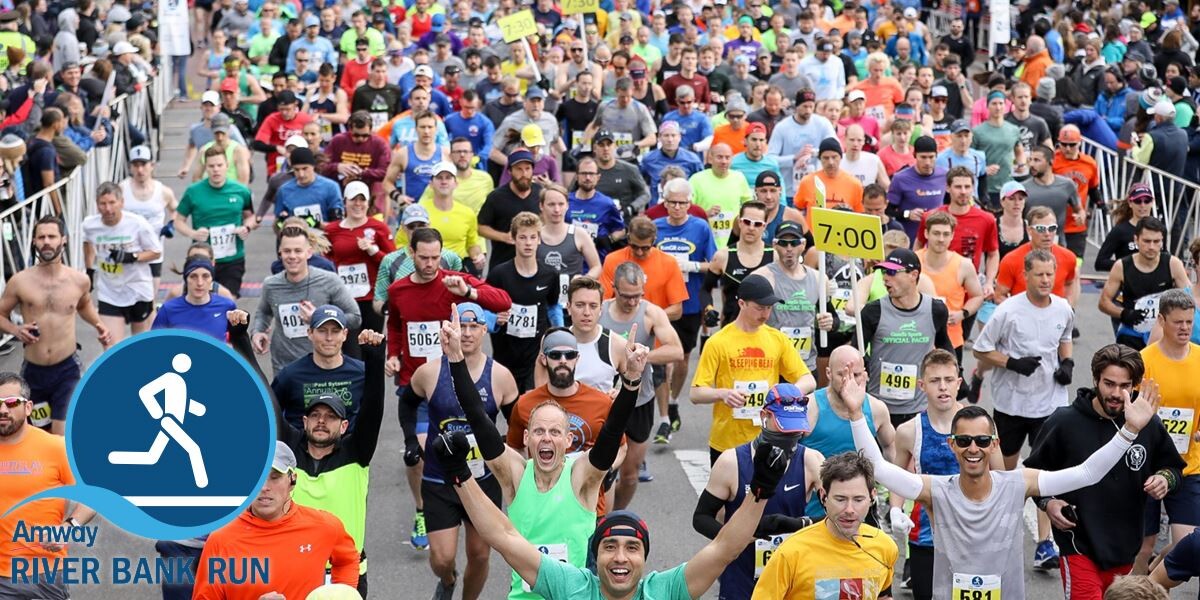
This is the second year with new race courses.
The 5K, 10K and 25K all start on Ottawa Avenue and end at Monroe and Pearl.

This means for the 25K you get the hills out of the way early on, then the back half is flat.
Race organizers say this will likely mean faster finish times.
Several elite runners will also be back this year including last year's winner Leonard Korir, along with Kiya Dandena and Johnny Crain who placed third and fourth, respectively.
On the women's side, Dakotah Lindwurm and Molly Bookmyer who placed third and sixth last year will also be returning.
Whether you're looking to set a course record or a personal one, officials say there's a race for you and a medal that comes with it!
Grand Rapids River Bank Run's revamped course to return.
“This race may have started with the 25K. And that event gains a lot of attention. But I encourage everyone to find their distance, whether it's a 5K, 10K, the walk, or the 25K, if that's what you want to do. This event is for everyone to participate in the greatest road race, I think, in the United States,” said Scott Stenstrom, VP of marketing & communications director for Fifth Third Bank.
Now, if running isn't your thing, you can still volunteer!
Roughly 1,000 people are needed to make race day a reality.
You can sign up to help online.
Of course, everyone is invited to celebrate at Finishers Fest happening inside DeVos Place.
(05/04/2023) ⚡AMPAmway River Bank Run
The Amway River Bank Run presented by Fifth Third Bank with Spectrum Health the Official Health Partner celebrates over 43 years. More than 16,000 people are expected to compete in the event which features the largest 25K road race in the country and offers the only 25K Wheelchair racing division in the world along with a 25K Handcycle division. The...
more...Northeast Ohio twin mom training, hoping for repeat Cleveland Marathon victory
A Northeast Ohio mom is taking multi-tasking to the next level.
Between juggling her kid's activities and working as a part-time physical therapist, Ashton Swinford is now preparing to embark on the Cleveland Marathon.

It all comes after she won the race last year. She's attempting a repeat scenario in 2023.
Sometimes she runs 90 miles a week. From time to time she will even incorporate her kids into the mix.
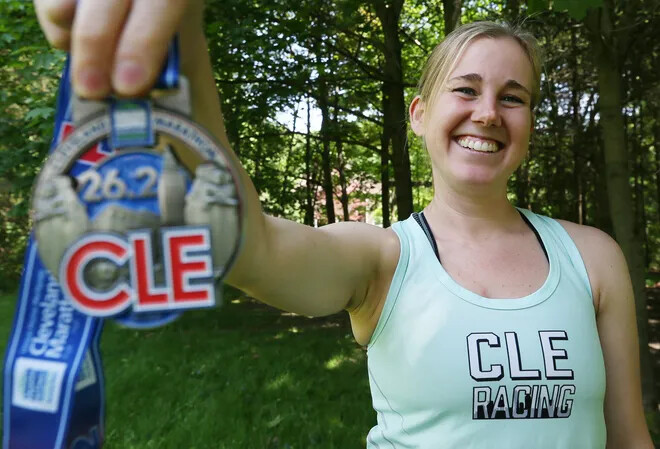
She's encouraging others to follow their dreams and commit to making them happen.
As a mom of twin 4-year-olds—Hudson native Swinford is literally always on the run.
"My training revolves around my kids schedule, so I only run when they're asleep or now when they're in preschool," said Swinford, Cleveland Marathon 2022 Winner.
Running, subsequently, has become her escape and a form of "me time" away from her busy life.
In the past when she was trying to get some extra miles in, she was known to throw the twins in a double stroller, embrace the resistance and go for a spin.
"If I had to run twice in a day, I would do my shorter run by pushing them in the stroller. And that was something we did together, and everybody really enjoyed it. It was a lot of fun. Actually, was a way to incorporate my kids into my training," Swinford said.
This year, she's preparing to lace up for the Union Home Mortgage Cleveland Marathon with runners from across the country.
It's where she will defend her title after winning last year's marathon with a remarkable 2:46:46 time.
The finish was a surreal and pivotal moment for the 33-year-old who took on long distance running a few years ago after her husband who ran cross country in college encouraged her to give it a shot.
"It definitely was a very slow, gradual process," Swinford said.
For Swinford—slow and steady really did win the race.
She didn't have overnight success, and it took years to perfect her craft.
She says support from her family and members of her all female elite running team called CLE Racing where she is a co-captain—help encourage her to be the best version of herself.
"I'm enthusiastic about it. I'm motivated. So I would say, yes, I'm ready," Swinford said.
Her message to those who have doubts or feel they can't do it—is simple and strong.
Be patient because each step will be worth it.
"Something that's worth achieving is going to take a lot of dedication, a lot of hard work. And there's going to be moments where you question what you're doing. But if you just keep putting one foot in front of the other. Step after step, you will get there," Swinford said.
(05/04/2023) ⚡AMPby Mike Holden
Cleveland Marathon
The Cleveland Marathon features a relatively flat and fast course, great volunteer support and a scenic view of downtown Cleveland and its major landmarks. The course has been designed for our athletes to enjoy views of Browns Stadium, the Rock and Roll Hall of Fame, Lake Erie and many other Cleveland highlights. The Cleveland Marathon began in 1978 in an...
more...Defending champions Nicholas Kimeli and Irene Cheptai set to return for TCS World 10K Bengaluru
The Tata Consultancy Services World 10K Bengaluru is set to witness a fierce competition on Sunday, May 21, 2023, as Kenya’s Nicholas Kipkorir Kimeli and Irene Cheptai return to defend their titles in the men’s and women’s categories respectively.
The event, which holds a prestigious World Athletics Gold Label Road Race status, boasts of a prize fund of USD 210,000 and saw the two athletes shatter the course records last year. Kimeli clocked a remarkable 27:38, while Cheptai stormed to victory in 30:35.

The event will feature an impressive International Elite field and enthusiastic amateurs from all over India and the world, converging on the Garden City to soak up the atmosphere and enjoy the race. Kimeli, who won last year’s edition, said, “I’m excited to be defending my title. I’ve prepared well and am feeling confident.” The men’s field is set to be highly competitive, with the top 12 runners holding personal bests under the course record and the top 3 having timed below 27.
In the women’s section, Cheptai will face tough competition from several other runners. The top four runners have personal bests under the course record. “I’m thrilled to be back in Bengaluru, and I have fond memories of India. I’ve trained well, but a lot depends on how you feel on race day,” said Cheptai.

Ethiopians Gemechu Dida and Birhanu Legese, Ugandan Stephen Kissa, and Kenya’s Sabastian Sawe are among the top runners in the men’s category. Legese, who is the world’s fourth fastest male marathoner, has finished on the podium a few times but is yet to secure the top spot at the TCS World 10K Bengaluru. “I’m feeling very positive, but I hope that things fall my way,” said Legese.
Dida, who won the 10K in Lille, France, in March, and finished fourth in the RAK Half Marathon in the UAE in February, is in excellent form. Kissa, who represented Uganda in the Tokyo Olympics over 10,000m, brings years of track speed to the road, and clocked an impressive 2:04.48 on his debut Haspa Marathon in Hamburg in 2022. He was also a third-place finisher at the 2020 Delhi Half Marathon in 58:56.
On the women’s side, Ethiopia’s Dera Dida, the 2019 World Cross Country silver medallist, ran a personal record and took home her first marathon victory in 2:21:11 at the Dubai Marathon in February this year. Among the favourites for the women’s honours is the talented Tsehay Gemechu, who finished second at this year’s Tokyo Marathon in 2:16.56.
(05/03/2023) ⚡AMPTCS WORLD 10K BENGALURU
The TCS World 10k Bengaluru has always excelled in ways beyond running. It has opened new doors for people to reach out to the less privileged of the society and encourages them to do their bit. The TCS World 10K event is the world’s richest 10 Km run and has seen participation from top elite athletes in the world. ...
more...Stephanie Bruce won the women’s Big Sur 12K—at 18 weeks pregnant—and then held the finish tape for her husband who won the marathon
While elite runner Stephanie Bruce waited for her husband, Ben, to run the Big Sur Marathon last weekend, she “snuck in [her] own little race,” and won. Oh, and she’s 18 weeks pregnant with her third child.
Bruce, who had announced her retirement from professional running in early 2022 and then reversed her decision, was the top female finisher in the Big Sur 12K in 45:41, coming in second overall, just 62 seconds behind first place.

“Averaged 6:09 pace. Proud of that at 18 weeks,” Bruce tweeted.
Bruce told Runner’s World earlier this year that 2022 was a “really amazing year” for her. She finished as the 12th woman in the Boston Marathon, running her second-fastest time (2:28:02), won the USATF 10K Road Championships, broke the Great Cow Harbor 10K course record (31:52), set a road PR at the NYC Mini 10K (31:49), and finished 13th at the New York City Marathon (2:30:34).

“When I look back, I think I had so much that happened to me in 2021; my mom died and then I found out I had a congenital heart condition,” she told Runner’s World last month. “I don’t know if I’d call it a midlife crisis, but I think I just hit a crossroads, and I was really deeply evaluating my life, and I’m like, should I still be running?”
Two weeks ago, Bruce ran 17:04 at the Boston Athletic Association 5K at 16 weeks pregnant, and last week, she posted a gender reveal video on Twitter (it’s a girl!). Plus, after her Big Sur 12K, she held the tape as her husband won the marathon in 2:36:59.
(05/03/2023) ⚡AMPby Heather Mayer Irvine
Big Sur Marathon
The Big Sur Marathon follows the most beautiful coastline in the world and, for runners, one of the most challenging. The athletes who participate may draw inspiration from the spectacular views, but it takes major discipline to conquer the hills of Highway One on the way to the finish line. Named "Best Marathon in North America" by The Ultimate Guide...
more...Botswana’s Nijel Amos 800m star and Olympic medalist, banned three years for doping
Botswana’s Nijel Amos, the joint-third-fastest 800m runner in history, was banned three years for doping.
The case stemmed to last June, when he tested positive for GW1516, an experimental drug which can modify the body’s metabolism but has been considered too dangerous for human use.

The ban was backdated to last July, when Amos was provisionally suspended pending an investigation. His ban now runs to 2025, which means the 29-year-old Amos will miss the 2024 Paris Olympics.
Amos received a one-year reduction of what would otherwise be a four-year ban because he made an early admission and acceptance of the suspension.

That came after he requested a supplement be tested for the presence of the drug. The test did not detect any GW1516 in opened and sealed bottles.
GW1516 was developed to help build endurance and burn fat but was found to cause cancer during tests on rodents. Anti-doping organizations have warned athletes not to use it on safety grounds.
The drug has previously been found in samples given by professional cyclists and by Olympic race walker Elena Lashmanova. The Russian served a two-year ban and was later stripped of the 20km gold medal she won at the 2012 Olympics for another doping offense.
In 2012, Amos, then 18, took silver in the 800m at the London Games in what many called the greatest Olympic race in history. Kenyan David Rudisha lowered his world record. Amos matched Seb Coe as the third-fastest man in history in the event (1:41.73). Every runner’s time was the fastest ever for that finishing placement.
Amos has not won an Olympic or world championships medal since. In July 2019, he ran 1:41.89, the world’s best time since that London Olympic final.
At the Tokyo Olympics, Amos and American Isaiah Jewett got tangled in the final lap of their semifinal. In an act of good sportsmanship, the runners helped each other up and later jogged across the finish line together in the last two places. Amos was granted a place in the final and finished eighth.
(05/03/2023) ⚡AMPby OlympicTalk
Olympic sprint champion Tori Bowie dies at 32
Tori Bowie, a three-time 2016 Olympic sprint medalist and 2017 World 100m champion, has died at age 32, according to her management company and USA Track and Field.
“We’ve lost a client, dear friend, daughter and sister,” the company tweeted. “Tori was a champion…a beacon of light that shined so bright!”

Bowie, raised by her grandmother in rural Mississippi, converted from the long jump to the sprints in 2014 and was the world’s fastest woman in the 100m that year.
At the 2016 Rio Olympics, she won 100m silver and 200m bronze and anchored the U.S. 4x100m relay to gold.

Then in 2017, she won the 100m at the world championships. Bowie remains the lone American woman to win an Olympic or world 100m title since Carmelita Jeter in 2011.
Bowie then re-added the long jump, placing fourth at the 2019 Worlds in her last major competition.
She did not enter the Tokyo Olympic Trials. Her last competition overall was in June 2022.
(05/03/2023) ⚡AMPby Olympic Talk
Setting running goals when you’re slowing down
Time waits for no one, as those of us who obsess over chip times know too well. Much of the thrill and focus of running boils down to besting ourselves, and that usually means covering the same courses and distances faster than we ever have before.
But there comes a time when we are no longer able to outrun ourselves. Age catches up, and at some point it becomes painfully clear that our fastest days are behind us.

But slowing down doesn’t mean all our PBs are suddenly set in stone or that we’re unable to achieve new firsts as runners. As we mature as runners, so too can the nature of our goals. Stop the clock and consider these alternatives to time-centric goalsetting
Go the distance

Running to set a personal best based on distance can add depth and variety to goalsetting. Going farther than you ever have is a challenge equally suited to longtime runners who have been building their fitness and endurance over years and decades, and fledgling runners who are taking up the activity later in life. The beauty of distance-based goalsetting is that it invites creativity. You might want to challenge yourself to finish your first ultra. Those more inclined to stick to shorter routes might find weekly, monthly or yearly distance goals a better fit. Runners in their retirement years who may now have more opportunities to travel can try smashing their record for most miles run outside Canada in a single year. Couples who have more time to connect can strive for new records for distances run together. Distance goals can be tailored to meet just about any runner’s strengths and schedule.
Get on a hot streak
Being consistent is both one of running’s greatest virtues and steepest challenges. Aiming to see a streak through to a new PB can really test your mettle, but it’s a goal that’s accessible to runners of all abilities. Streak-setting doesn’t exclude the super-speedy, like New Zealand’s Nick Willis, who last year marked his 20th straight year of running a sub-four-minute mile. That said, successful streaks can be a well-earned source of pride for runners who stick with running 1 km every day for a month, or 10 km every month of the year. Like distance-focused goals, streak targets are limited only by a runner’s imagination.
Consider non-performance goals
Slowing down offers us an opportunity to reflect on our relationship with running and to consider ways to make it deeper and more meaningful. An option worth considering is making the shift to a more supportive role. This might mean crewing a friend or family member’s attempt at an ultra-marathon, or dispensing water or medals as a volunteer at an upcoming half-marathon. Volunteering can also be a pathway to becoming a vital part of a world-famous race you always wanted to experience in-person but never got the chance to as a competitor.
(05/02/2023) ⚡AMPby Paul Baswick
Sabastian Sawe moved to fifth on the men’s world 10km all-time list, while Medina Eisa raced to a women’s world U20 5km best at the Adizero Road to Records event
SabastianSawe moved to fifth on the men’s world 10km all-time list, while Medina Eisa raced to a women’s world U20 5km best at the Adizero Road to Records event in Herzogenaurach, Germany, on Saturday (29).
Competing on a loop course in blustery conditions, Kenya’s Sawe turned the tables on last year’s 10km winner KibiwottKandie to triumph in 26:49 – three seconds ahead of his compatriot.

With that time, Sawe improved his PB by five seconds to better the 26:54 he ran when finishing runner-up to Kandie in Herzogenaurach last year. Forming part of a Kenyan top five, Nicholas KipkorirKimeli was third in 26:54, world record-holder RhonexKipruto was fourth in 27:09 and Levy Kibet was fifth in 27:14.
Kandie and Sawe were to the fore as the first kilometre was covered in 2:41 and then Kandie took control, leaving the pacemakers behind, as 3km was hit in 8:04. The halfway point was reached in 13:27 as Kandie led from Kipruto and they started to string out the field, a 2:37 sixth kilometre further breaking up the pack.

But then the pace dipped slightly and Sawe took advantage, gaining a gap on his rivals that he wouldn’t relinquish. Always in control, he continued to move ahead and claimed a clear win – a second consecutive victory after his half marathon triumph in Berlin at the start of this month.
Kenya’s IrineJepchumbaKimais also maintained a win streak, taking top spot in the women’s 10km in a PB of 30:23 as she held off the challenge from Ethiopia’s FotyenTesfay and Kenya’s Agnes JebetNgetich.
Kimais, who claimed half marathon victories in Barcelona in February and Prague earlier this month, improved her previous 10km best of 31:21 that secured her ninth place at this event last year, winning by three seconds ahead of Tesfay. Ngetich, who claimed bronze at the World Cross Country Championships in Bathurst in February, finished third in 30:27 as the top three all set PBs.
Behind them, Kenya’s JanethChepngetich finished fourth in 30:28 and Ethiopia’s 17-year-old SenayetGetachew set a world U20 best of 30:34 to finish fifth.
Eisa pips Teferi
Ethiopia’s Eisa narrowly denied her compatriot SenbereTeferi a third consecutive women’s 5km victory in Herzogenaurach as she sprinted to a world U20 best of 14:46 to beat her rival in a photo finish.
Further demonstrating her versatility, 18-year-old Eisa adds this latest victory on the roads to a CV that already includes a world U20 5000m win on the track in Cali last year and a second place finish in the U20 race at the World Cross Country Championships in Bathurst in February.
Teferi, who set the women-only world record of 14:29 at this event in 2021, made a move in the second half of the race, but her compatriots Eisa and Gebrzihair were ready to respond. The defending champion sprinted towards the finish line and raised her arms in anticipation, but Eisa had chased her down and made it to the tape first, breaking it in 14:46.
Gebrzihair finished two seconds behind them, while LemlemNibret was fourth in 14:57 and YalemgetYaregal fifth in 15:00 in an Ethiopian top five.
There was also a close finish in the men’s 5km as Ethiopia’s long-time leader YomifKejelcha was surprised by Bahrain’s BirhanuBalew in the final strides and had to settle for second place this time, after his win in Herzogenaurach last year.
Two-time world indoor 3000m champion Kejelcha was running solo by 3km – reached in 7:45 – but Balew never lost sight and he stormed past Kejelcha at the finish to win in 13:06.
Kejelcha clocked the same time in second, while Burundi’s RodrigueKwizera was third in a national record of 13:11 on his 5km race debut.
The women’s half marathon was won by Ethiopia’s BertukanWelde Sura, making her debut at the distance. The 18-year-old, who finished fourth in the 3000m at the World U20 Championships in Cali last year, timed her kick to perfection and won a sprint finish against her more experienced compatriots NigstiHaftu and DeraDida.
Haftu finished second, clocking the same time as the winner, while Dida was third in a PB of 1:07:47, a couple of months after her Dubai Marathon win in 2:21:11.
Another rising talent won the men’s half marathon, 20-year-old Tadese Takele surging away from his rivals over the final kilometer to win in 1:00:04.
Waving to the crowds and celebrating on his way to the finish line, Takele went from fifth in this event last year – when he set his PB of 59:41 – to first, winning by three seconds ahead of Kenya’s JosphatChumo and RoncerKipkorir.
(05/02/2023) ⚡AMPby World Athletics
ADIZERO: ROAD TO RECORDS
Adidas HQ in Herzogenaurach, Germany played host to elite adidas athletes competing on a specially designed course around the adidas World of Sport campus across 5km, 10km and 21km distances The course followed a loop of approximately 2.5km on a smooth tarmac surface with a slight elevation on each lap. Conditions were perfect as the first event,...
more...every runner should try the marathon at least once in their career
For many runners, the marathon is high on their race bucket list. There are a lot of runners out there, however, who couldn’t care less about the marathon. If you’re one of those people, it’s totally fine to stick to half-marathons and 10Ks, but it’s worth trying the full marathon distance at least once. We know you’re probably tired of hearing people tell you that you should run a marathon, and we’re not saying you have to become a marathon runner for life, but here are a few reasons to consider trying it out.
New mental challenges

No matter the race, you’re going to experience a mental battle at some point. Unlike a 5K, which is over relatively quickly, in the marathon, you can hit the wall with over an hour left of running, which means you’ll have a lot of time on the race course trying to convince yourself to keep pushing. This is when the race shifts from a physical battle to a mental one, and while it’ll be tough, it will also be incredibly rewarding to grind through those dark moments.
Confidence boost

Even if you don’t do another marathon, knowing you conquered such a massive race will definitely boost your confidence moving forward. Shorter races will still be hard, but when things get tough in those runs, you’ll be able to draw on your experience in the marathon and remind yourself that you’ve gone much farther and pushed through more exhaustion before.
Trying new things
It’s easy to stay inside your comfort zone, but it’s incredibly valuable to venture outside it from time to time. Doing a marathon is scary, there’s no doubt about it, but you’ll grow as a runner if you take that leap and give it a try. Also, you might love it. If you never try a marathon, though, you’ll never find out if it’s the race for you.
You can do it
If you’ve run other races, you can complete a marathon. You’ll need to train properly and prepare well for the race, but it’ll be worth it. You’re capable of running a marathon, so why not do it?
The marathon is ‘the’ race
Whether you like it or not, the marathon is considered the ultimate running event. Everyone knows about this race, and runners and non-runners alike are always going to ask you if you’ve done a marathon when the topic of running comes up. We don’t agree that the marathon is the most important event out there, but you might as well do at least one so you can answer yes when people inevitably ask you that question.
(05/02/2023) ⚡AMPby Ben Snider-McGrath
Four ways to brace for a sweltering race
If the weather could give you whiplash, no month would be a bigger pain in the neck than May. In much of Canada, this is a month of drastic temperature jumps that can necessitate clearing closet space for fleece sweaters as well as tank tops. No one feels the shock of May’s sudden temperature spikes quite like runners, particularly those registered for races at the end of the month or in early June. These athletes often spend the last crucial weeks of training in temperatures just north of freezing, only to be slapped by a brutal blast of July-like heat and humidity when toeing the starting line.
Being prepared to race in the fast-approaching season of sizzle means acclimating your body now. Check out these four tips for getting a head start on scorching weather before the mercury soars.

1.- Layer up
Dressing for the weather is sound year-round advice, and early May is the exception that proves the rule. When preparing your body and mind for the hotter days ahead, dressing for discomfort is the way to go. Layering up with an extra jacket, technical shirts and running tights for at least a couple of runs a week—and ideally including your long run—will help turn up the heat on a cold morning. Throwing in non-breathable pieces that aren’t typically part of your running wardrobe—plastic rainwear is perfect, if you have it—can help acclimate you to humidity as well as heat. It’s important, however, to compensate for the extra heat by having plenty of water on hand. You’re trying to train your body to perform while it’s hot, not while it’s dehydrated, and it’s important to be able to quench your thirst.

2.- Fire up the furnace
The trusty treadmill that you’ve relied on through the long winter tends to start gathering dust as soon as snow and ice disappear in spring. Don’t fold it up and shove it under the bed just yet—it can be the perfect pathway to heat acclimation. Cranking the thermostat and incorporating more treadmill runs into your training week is an effective way to prepare for racing in hot weather. Those without a fireplace will take a bit of a hit on their energy bill, but it might just be worth the investment.
3.- Keep it on simmer after your run
Ditch the post-run cooldown and instead use the opportunity to continue working on your heat adaptation. One of the most effective ways to do this is by capping off your run with a sauna session. A recent study shows that a 30-minute post-run sauna treatment is effective in helping distance runners adapt to running in hot weather. Sweating it out by soaking in a hot bath can also help with heat adaptation for those without access to a sauna.
4.- Pick a perspiration destination
This one requires the right combination of foresight and unused vacation days, but planning a trip to warmer climes in the weeks leading up to your late-May race can do wonders for heat adaptation. If you’ve booked a trip south with the main purpose of training in hot weather, beware the urge to treat it too much like a vacation, or you could blow a unique and effective training opportunity. Also, make sure not to stray too far from your home time zone—you don’t want to be fighting jet lag along with the heat and humidity on race day.
(05/02/2023) ⚡AMPby Paul Baswick
Best Workouts to Improve Your Speed
Whether you want to get faster or improve your overall fitness level, track workouts are one of the most effective ways to accomplish your goals. These 4 best track workouts will improve your running speed and efficiency and make you a stronger athlete. Whether you want to PR in your next race or just become a faster runner in general, these track workouts will help you. An added bonus is speed workouts burn more calories per minute of exertion than regular slow runs, and you will notice an improvement in your overall fitness level.
Track Intervals

Intervals are a classic speed workout that can be adapted for any level of runner. Whether you’re training for a marathon and running 800-meter intervals or are just beginning running and doing 100-meter sprints, speed workouts can be adapted to any runner’s needs. You can even do interval workouts on the road or trail if you don’t have access to a track. Interval workouts involve measured bursts of speed mixed in with slow jogging or even walking or resting for recovery time.
When I coach runners, I usually have them start with 400-meter intervals workouts to begin speed training. Here is a sample 400-meter interval running workout that can help any runner get faster and stronger:
400-METER INTERVALS
This workout is easiest to do on a track — 400 meters is one lap on a standard outdoor track. You can, however, use your smartphone running app or running watch to measure out .25 of a mile for each 400-meter interval if you are running on the road or trails. Be sure to record your times for your interval workout and you will see your speed improve as you repeat the workout each week.
Warm-up - Run 800-meters or 1/2 of a mile at a relaxed pace, jogging.

Speed Interval: Run 400-meters (one lap on the track or .25 of a mile on the road) at 80-85% effort level. This pace should make you feel winded by the end and like you are going considerably faster than your regular running pace. You will not be able to talk at this speed as you run.
Recovery: Jog or run slowly for 400-meters for active recovery. This will allow you to catch your breath and reset before the next speed interval.
Repeat the speed interval-recovery cycle, alternating one recovery lap between each fast lap. If you are a beginning runner, do 4 fast 400-meter intervals and 4 recovery laps for your first speed workout. For intermediate runners, start with 6 speed intervals. You can run this interval workout once a week, adding one more speed interval every 2 weeks to build up your endurance. You can also increase the interval distance to 800-meters or even 1-mile intervals if you are training for a long-distance race like a marathon.
Cooldown - Run 800-meters or 1/2 of a mile at a relaxed pace, jogging. Stretch.
Tempo Runs
Tempo runs are a staple speed training workout for long-distance runners. Tempo runs help improve your body’s ability to run faster for long stretches of time and adapt to lower oxygen supplies as you run. These runs are great preparation for racing.
What is a tempo run, you may be wondering? A tempo run — or lactate threshold run — is a running workout at a pace at which your body produces and clears lactate (a metabolic by-product of exercise) at a close-to-equal rate. In layman’s terms, a tempo run is a pace your body can run and keep breathing and working without cramping up or getting too winded to keep going. A tempo run is not an anaerobic workout like sprinting but instead trains your body to be able to keep pushing and performing at higher levels for longer distances. Whether you are a 1-mile track runner or a marathoner, tempo runs are excellent training tools to make you a better, more efficient runner.
HOW TO DO A TEMPO RUN
Tempo runs are the middle ground of running, falling between easy, slow runs and intense speed intervals. To determine your tempo pace, add 24 to 30 seconds per mile to your 5K PR or goal pace. If your best 5K time is at an 8-minute-mile pace, for instance, your tempo run pace will be 8:30 per mile.
For your first tempo run, warm up for 5 minutes running at a relaxed, easy pace. Then do 20 minutes of running at your tempo run pace. Cool down for 5 minutes of easy running and then stretch. For the best results, do one tempo run a week, and you can gradually build up your temp running time to meet your race training distance goals, building up to a maximum of an hour of tempo running if you are training for a long-distance race such as a half marathon or marathon.
Fartleks
Fartleks - Swedish for speed play - offer a flexible, fun speed workout that can be adapted to any running level. Fartleks are a great running workout for beginners as they can be very short and informal and are not intimidating.
If you are wondering what the heck fartleks are, let me help — fartleks are short bursts of speed during a regular, easy-paced run. The speed bursts can vary, often using something such as a pole or street light ahead to run fast toward, and then slow down once you pass the landmark.
HOW TO DO FARLEKS
To do a fartleks workout, go for a 3-4 mile, relaxed pace run. After your first 5 minutes of running, pick a spot in the distance and run fast toward it. If you are on the track, you may run the long straight away fast for your fartlek. You will be running at about 90-percent effort level, faster than your 5K race pace. Usually, this fartlek interval should be for about 1-2 minutes in duration. Then return to your regular, relaxed base run pace. After a few minutes, pick a landmark — or stretch of the track — to run fast toward again. Do 5 to 10 fartleks during your workout. Your fast running time should total 10 to 12 minutes by the end of your run.
Fartleks are a great workout to prepare for more measured interval workouts. If you are a beginner, do one fartlek workout a week to start.
Strides
Strides are a great, short, speed workout you can tack on to the end of an easy run day. Strides help train your body to run at higher speeds even when your body is already fatigued from running. They also help improve your running form and efficiency.
Strides are a running drill that you run for short bursts of speed with an exaggerated running form. You can run strides after an easy run to work on your form and speed. Strides are short, 20-30 second accelerations that you can plug into your weekly training program.
Here is how to run strides:
Find a flat place to run 100 meters. This can be the straightaway part of a track, or on a flat road.
Begin running your stride by taking short steps (or strides), and pumping your arms up and down, in an exaggerated motion. As you speed up, your leg turnover will get quicker.
Begin running at an easy, relaxed pace, and build up your speed as you run.
You should be running at about 95 percent effort level by the end of your stride. Your stride should only take 20-30 seconds so you may get winded at the end but will recover quickly.
Do 4 strides for your first stride workout and build up to doing 6 or 8 strides.
Do your stride workout after an easy run or regular base run.
Speed Workout Tips
When you do speed workouts, it’s important to give your body time to rest and recover so your muscles can rebuild and repair. You will want to follow the easy-hard principle of training and schedule track workouts between easy run or recovery days. Track workouts, long runs and races are all considered hard trianing days, so you will need time to recover from them. If you do a speed workout, take a rest day or do an easy run the following day for recovery. Do not do speed workouts two days in a row.
Make sure you stay hydrated before, during, and after your track workouts. This will help prevent muscle cramps and speed up your recovery time.
When you are doing interval workouts, aim for consistency in your pace so all your fast runs of a particular distance are the same pace. It is tempting to begin with a sprint or go too fast when you begin track workouts, but it’s important to hold back some in the first intervals so you can maintain your speed through the very last interval.
If you love track workouts and want to do some track races, check out the USA Track and Field calendar of events for sanctioned track races around the U.S.
(05/01/2023) ⚡AMPby Marnie Kunz
The best ways to improve distance running performance
Maximizing speed and performance in distance running can be achieved by improving lactate threshold and running economy. While VO2max—the maximum volume of oxygen your muscles can consume per minute—has received most of the attention among runners and coaches, a high VO2max alone is not enough to attain competitive performances.
A high VO2max simply gains one access into the club, since a runner cannot attain a high level of performance without a high VO2max. But, while you can improve your VO2max, it is largely genetically determined.
The other two major physiological players of distance running performance—lactate threshold (LT) and running economy (RE)—influence your performance more, and are more responsive to training.

From the time of the classic study published in Medicine and Science in Sports and Exercise in 1979 by some of the most prominent names in exercise physiology—Farrell, Wilmore, Coyle, Billing and Costill—research has shown that the LT is the best physiological predictor of distance running performance.
LT is an important physiological variable that demarcates the transition between running that is almost purely aerobic and running that includes significant oxygen-independent (anaerobic) metabolism. It represents the fastest speed you can sustain aerobically. Since the LT represents your fastest sustainable pace, the longer the race, the more important your LT.

What is LT Pace?
LT pace is about 10 to 15 seconds per mile slower than 5K race pace, or about 10K race pace for runners who take 40 minutes or more to complete 10K. If using a heart-rate monitor, the pace should be about 75 to 80 percent of your maximum heart rate.
For highly trained and elite runners, LT pace is about 25 to 30 seconds per mile slower than 5K race pace, or about 15 to 20 seconds per mile slower than 10K race pace, and corresponds to about 85 to 90 percent max heart rate. The pace should feel "comfortably hard."
How to Improve LT?
Sample workouts to improve lactate threshold include:
Continuous runs at LT pace, starting at 3 miles and increasing up to 7 to 8 miles, or about 45 minutes for marathoners
Intervals at LT pace with short rest periods, such as 4 to 6 x 1 mile at LT pace with 1 minute rest
Shorter intervals at slightly faster than LT pace with very short rest periods, such as 2 sets of 4 x 1,000 meters at 5 to 10 seconds per mile faster than LT pace with 45 seconds rest and 2 minutes rest between sets
Long, slow distance runs with segments run at LT pace (for marathoners), such as 12 to 16 miles with the last 2 to 4 miles at LT pace, or 2 miles + 3 miles at LT pace + 6 miles + 3 miles at LT pace.
How Running Economy Makes Running Easier
Running Economy is the volume of oxygen consumed at submaximal speeds. In 1930, David Dill and his colleagues were among the first physiologists to suggest that there are marked differences in the amount of oxygen different athletes use when running at the same speeds, and that these differences in "economy" of oxygen use are a major factor in explaining differences in running performance in athletes with similar VO2max values.
For example, research has shown that, while Kenyan runners have similar VO2max and LT values as their American or European counterparts, the Kenyans are more economical—possibly due to their light, non-muscular legs that resemble those of thoroughbred race horses. The heavier your legs, the more oxygen it costs to move them.
RE is probably even more important than the LT in determining distance running performance because it indicates how hard you're working in relation to your maximum ability to use oxygen.
For example, if two runners, Jack and Martin, have a VO2max of 70 milliliters of oxygen per kilogram of body weight per minute and a LT pace of 7 minutes per mile, but Jack uses 50 and Martin uses 60 milliliters of oxygen while running at 7:30 pace, the pace feels easier for Jack because he is more economical. Therefore, Jack can run faster before using the same amount of oxygen and feeling the same amount of fatigue as Martin.
I have yet to see a runner who has superior RE who does not also have a high VO2max and LT.
4 Strategies to Improve Running Economy
Despite its importance, RE seems to be the most difficult of the three physiological players to train. While many runners and coaches think that RE is a reflection of running form, it is more influenced by those microscopic structures that influence oxygen delivery to and use by the muscles—capillaries and mitochondria, the densities of which are both enhanced with high mileage.
Research has shown that runners who run high mileage—more than 70 miles per week—tend to be more economical.
In addition to increasing mitochondrial and capillary density, the greater repetition of running movements may result in better biomechanics and muscle fiber recruitment patterns and a synchronization of breathing and stride rate, which may reduce the oxygen cost of breathing.
RE may also be improved by the weight loss that often accompanies high mileage; the change in body weight lowers oxygen cost.
Since VO2max plateaus with about 70 to 75 miles per week, improved RE may be the most significant attribute gained from running high mileage. However, it's not entirely clear whether high mileage runners become more economical by running more miles or they're innately more economical and can therefore handle higher mileage.
Intervals and tempo runs can also improve RE since, as VO2max and LT improve, the oxygen cost of any submaximal speed is also likely to improve.
However, it is possible to become more economical without improving VO2max or LT, as research on power training with very heavy weights and plyometrics has shown.
Power training focuses on the neural, rather than metabolic, component of muscle force development to improve RE.
(04/30/2023) ⚡AMPby Jason Karp
Purity Komen upsets Ruth Chepngetich and Daniel Ebenyo wins in Istanbul
Purity Komen was the surprise winner of the N Kolay Istanbul Half Marathon. Overtaking fellow-Kenyan and race favourite Ruth Chepngetich the 24 year-old stormed to her biggest career win with a personal best of 66:30. Course record holder Chepngetich followed in second with 67:18 while Evaline Chirchir made it an all-Kenyan podium with 67:31. Stella Rutto of Romania was the fastest European, finishing 10th with 70:05.
In partly windy conditions hopes for a course record faded in the men’s race as well after a fast first section. 27 year-old Daniel Ebenyo of Kenya was the winner of Turkey’s best quality road race with 59:52. Marokko’s Hicham Amghar took second place in 59:58 and Haftu Teklu clocked 60:03 for third. Britain’s Marc Scott was the best European runner in 63:17 for 12th place.

A record number of 12,300 runners competed in the 18th edition of the half marathon and the 10k race staged parallel. Many athletes ran for charity, collecting money for the victims of the devastating earthquake that shook southern Turkey earlier this year. The N Kolay Istanbul Half Marathon is a Gold Label Road Race of World Athletics.
"It was a nice race and especially the men’s elite was very competitive. We are happy that we continue to register record fields. It is always exciting to experience the historic atmosphere here in Istanbul and we are now inviting everyone to be back for our marathon on 5th November,“ said Race Director Reynar Onur.
The women’s race began as expected. Ruth Chepngetich sped away from the field right after the start and was so quick that even the TV cameras missed her on a few occasions early on. Passing the 5k mark in 15:16 the Kenyan was almost on course for breaking her Kenyan record and her Istanbul course record of 64:02, which in 2021 was a world record as well.
However once the 2019 Marathon World Champion came off Galata Bridge and had to run against the wind for almost four kilometers she slowed considerably. At the 10k point her 31:09 split time then indicated a 65:45 finish and her lead had shrunk to only four seconds. Purity Komen, Evaline Chirchir and Ethiopia’s Bosena Mulatie caught her a few minutes later. Then it was Komen, who had only been number nine with a PB of 67:08 on the final start list, who moved ahead before the 15k mark. Chepngetich tried to follow her in a bid to make it six wins from six races in Istanbul, but today she was unable to do so. Purity Komen won the race with 66:30 and became the first woman to beat Ruth Chepngetich on the historic roads of Istanbul.
“My body did not respond after the early part of the race. I don’t know why, but I assume that may be the race came a bit too soon after the Nagoya Marathon in March,“ said Ruth Chepngetich. “I have not yet decided if I will run the World Championships’ marathon or an autumn race. The big goal is the Olympic Games next year and I hope to be selected for the team.“
While Ruth Chepngetich is an experienced marathoner the victory in Istanbul may well have brought Purity Komen closer to her debut at the classic distance. “This victory was unexpected. I was surprised when I suddenly saw Ruth in front of me and was then able to pass her,“ said Purity Komen. “I had hoped to achieve a 65 minutes’ time, but it was too windy today. I now plan to run my marathon debut next year.“
The men’s race began very fast as well with the first couple of split times indicating a finishing time of around 58:00. But as in the women’s competition the pace then dropped considerable once the leading group hit the wind. A group of around ten athletes passed the 10k mark in 28:22, which is sub 60 minutes’ pace.
Two athletes were pushing the pace at the front: Kenya’s Daniel Ebenyo and Hicham Amghar of Morocco, who have PBs of 59:04 and 59:53 respectively. Soon after the 15k point (42:33) Ebenyo took the lead, covering the 16th kilometre in 2:46. Only Amghar was able to follow him, but when Ebenyo indicated to him to help pushing the pace the Moroccan stayed right behind him. Ebenyo then kept pressing ahead and opened up a decisive gap with around 4k to go.
“I hoped to catch Daniel but I am happy with my result. I was going for a PB, but it was not possible in the wind,“ said Hicham Amghar, while Daniel Ebenyo was happy about his first major half marathon victory. “I am excited to have won this race. My aim was to run 59:00 minutes but it was too windy for that,“ said the Kenyan. “I will probably run my marathon debut next year. May be I come back to Istanbul for that.“
Results, Men:
1. Daniel Ebenyo KEN 59:52
2. Hicham Amghar MOR 59:58
3. Haftu Teklu ETH 60:03
4. Charles Langat KEN 60:07
5. Vincent Kipkemoi KEN 60:09
6. Boniface Kibiwott KEN 60:23
7. Benard Biwott KEN 60:47
8. Ashenafi Kiros ETH 61:21
9. Alfred Ngeno KEN 62:24
10. Alene Mekonen ETH 62:32
Women:
1. Purity Komen KEN 66:30
2. Ruth Chepngetich KEN 67:18
3. Evaline Chirchir KEN 67:31
4. Bosena Mulatie ETH 67:43
5. Tigist Gezahagn ETH 68:49
6. Betelihem Afenigus ETH 69:04
7. Beatrice Cheserek KEN 69:14
8. Bekelech Gudeta ETH 69:35
9. Shamilah Kipsiror KEN 69:38
10. Stella Rutto ROM 70:05
(04/30/2023) ⚡AMPN Kolay Istanbul Half Marathon
The Istanbul Half Marathon is an annual road running event over the half marathon distance (21.1 km) that takes place usually in the spring on the streets of Istanbul, Turkey. It is a IAAF Gold Label event. The Istanbul Half Marathon was first organized in 1987. After several breaks it was finally brought back to life in 2015 when the...
more...How the Bolder Boulder 10K Became One of the World’s Most Cherished Road Races
5,000 runners are expected to run this year’s Memorial Day 10K on May 29
At bedtime last week, legendary American distance runner Melody Fairchild regaled her 7-year-old son Dakota with tales of the Bolder Boulder 10K he plans to run this year.


One of the biggest road races in the world for the past several decades, the race sends 40,000 runners through the streets of Boulder, Colorado, on a point-to-point race that ends at the University of Colorado (CU) football stadium, full of cheering spectators and fellow runners.
“I told him it’s an amazing feeling to run into that stadium,” Fairchild says. “When you hit the field, the whole crowd is cheering for everybody. You feel like they’re cheering for you. He had this huge smile on his face.”
And if 50,000 people cheering isn’t enough, there’s also the famous slip-n-slide, numerous bands playing on the course, runners and spectators wearing outrageous costumes, and the military jet flyover by the Colorado Air National Guard you can feel in your bones. Named America’s All-Time Best 10K, it’s likely to be one of the biggest parties you’ll ever attend.
Fairchild recounted for Dakota her experience as the U.S. captain for the Bolder Boulder’s first International Team Challenge professional race in 1998.
“I remember looking out the window and seeing the stadium full. I was so nervous, I thought I was gonna vomit all over the floor,” she says. “When I walked out and they introduced me as the local hometown girl, the whole crowd roared.”
Fairchild ran her first Bolder Boulder at age eight. She went on to win the citizens’ race three times (1989, 1990, 1991) when she was a record-setting high schooler, became an All-American and NCAA champion at the University of Oregon, and then qualified for the U.S. Olympic Trials in the 10,000-meter run and marathon as a professional runner. But the Bolder Boulder has always held a special place in her heart, which is why she has continued to run it through the years and why she’s so eager to introduce Dakota to it.
The idea for the Bolder Boulder germinated in the mind of a father watching his five children participate in all-day track meets. It was the summer of 1978 at the upswing of the original American running boom, and runner and local businessman Steve Bosley had grown frustrated with the disorganized events and parents berating their children for not running fast enough.
Bosley, then 37, reached out to his friend, Boulder resident and international running icon Frank Shorter, a two-time Olympic medalist in the marathon, for help designing a race that would serve their community and promote the sport of running. The race would not only become a Colorado icon, it set a gold standard for road races around the world and helped elevate women’s running in unprecedented ways.
During the spring of 1979, Cliff Bosley, the current race director, went door to door with his Boy Scout troop, passing out posters to encourage neighbors to run his dad’s inaugural race. The poster announced a 4,000-participant cap and enticed Boulderites to “Run with Frank Shorter and Ric Rojas!” for a mere $6.50 entry fee. (Rojas was another local elite athlete who would go on to win the inaugural race in 1979. His daughter, Nell Rojas, a current professional runner, won the women’s citizen’s race 40 years later in 2019.)
Bosley recalls giving a man in his front yard a poster who threw it back in his face in disbelief. “‘Yeah right, 4,000!’ the man scoffed. “I was just a 12-year-old kid. You believe everything your parents tell you. I thought, ‘Dad says it could happen—why won’t it?!’”
The inaugural race saw 2,700 registrations. The next year, it doubled in size and live entertainment was added to the celebration. Participation continued to soar in the ensuing years and decades, eventually reaching 50,421 in 2010. With an average of 45,000 finishers over the past 10 years, it’s now the seventh-largest road race in the nation and the largest Memorial Day celebration in the U.S.
From its inception, the Bolder Boulder 10K offered equal prize money for the female and male winners. In 1984, it created a separate elite race from the citizens’ race. There was also a deliberate split in the women’s and men’s elite race so that both races could be showcased equally and covered live on the local TV broadcast. Today, it offers one of the largest non-marathon prize purses in the U.S., but this did not come without a lot of work.
Initially road races were precluded from paying prize money to athletes because it changed their amateur athlete status, preventing them from competing in the Olympics. In the early 1980s, Steve Bosley, then the president of the Bank of Boulder, worked with two local attorneys, Frank Shorter, and TAC (The Athletics Congress which was then the name of the national governing body for the sport; now it’s known as USATF), to create a mechanism using trust accounts for athletes to earn prize money. It was then paid into athletes’ individual trust accounts so they could draw living and training expenses. At the time these accounts were called TACTRUST Accounts, and the Bank of Boulder was the steward of 95 percent of all of these accounts on behalf of both American and international athletes from around the world.
One of the most circulated photos of the Bolder Boulder 10K is that of Shorter, the 1972 Olympic marathon champion, winning the 1981 race— the first time the race finished in the University of Colorado’s Folsom Stadium. But that same year, Ellen Hart, then 23, won the women’s race—although she says there was no finish line tape for the female winner.
“It was the most exciting thing I had ever seen,” she recalls. “Since I was a little girl, I had wanted to go to the Olympics. I thought, Oh my god. This is like the Olympics! I traveled to races all over the world and the BB was my favorite race.”
Hart would move to Boulder in 1982, and then win the race again in 1983 before the four-year reign of Portugal Olympian Rosa Mota. In many ways, Hart says, her success in the Bolder Boulder launched her career as a professional athlete.
She went on to place 11th at the inaugural women’s U.S. Olympic Trials Marathon in 1984, set an American record in the 30K, and won 18 world championship titles in triathlon and duathlon racing. “In terms of women’s sports, the Bolder Boulder was certainly more forward-thinking than any other race I ever attended,” Hart says.
The race organization was also ahead of its time when it began the Women’s High Altitude Training Camp, something it did not offer for men, in 1989. The 100-day program was designed to bring five talented post-collegiate female runners to Boulder to train prior to racing Bolder Boulder. Runners were placed in volunteer host families, provided an elite coordinator and a trail guide, and given access to a local gym and the university’s track to train.
New Jersey runner Inge Schuurmans McClory was a member of the 1990 team.
“I really didn’t feel worthy of national attention, but I applied for the program not even thinking I was going to get in,” she says. She was not only accepted, but she fell in love with Boulder and stayed.
“I went to graduate school here. I met my husband here. I coached cross country and track at CU. It sort of was the launching pad for the rest of my life, and I owe it to the Bolder Boulder and that high-altitude training camp,” says McClory, now a physician’s assistant who has trained cardiac patients—the Brave Hearts—for the Bolder Boulder since 2000.
Since 1996, there have consistently been more women (average 53-54 percent) than men completing the race. Cliff Bosley attributes this to his mom creating a walking division in 1984 so that her father, diagnosed with prostate cancer, could participate.
“We kind of look at it as a placeholder,” says Bosley, “You come in as a walker and now you’re on the continuum. Let’s help you become a jogger. Let’s help you become a racer.” This exemplifies the Bolder Boulder’s rallying cry, “Oh Yes You Can!” that it established in 1979.
The Bolder Boulder has always been defined by its strong community involvement, which includes an eager network of volunteers, aid stations staffed by local running groups, and the thousands of spectators who line the streets and fill the stadium. Historically, the race donates more than $100,000 to local nonprofits and community groups that volunteer. Even during the pandemic, the race still found a way to contribute.
“Knowing we could not stage the Bolder Boulder in-person, we created a virtual event called the VirtuALL 10K and offered it at no cost,” Bosley says. Thousands of T-shirts, designed for the 2020 race that went unused, were donated to shelters.
Another Bolder Boulder program that supports the community is the BB Racers Club. Created in 1996, the program prepares children for the race, so their experience is a positive one. Initially started as a middle school program, this club now includes elementary schools. Children who are signed up are given a special training program, coach, and starting wave. Fairchild’s Boulder Mountain Warriors club, of which her son Dakota is a participant, is training a large number of BB Racers this year.
Bosley is prepared for up to 45,000 participants at this year’s race on May 29. And just as they did 44 years ago, race organizers will serve participants a sack lunch and send them a postcard in the mail with their finishing place, pace, time, and ranking in their age group.
“I can still remember checking the mailbox every single day until it came,” says Fairchild. “It makes me emotional just thinking about how much attention to detail they’ve always given hundreds of thousands of people. They care so much. It’s not an accident that they are the best 10K in the world.”
(04/30/2023) ⚡AMPby Outside
Five Lessons from the Marathon Goat and his team
THE MOST REMARKABLE aspect of the fastest marathoner in history is how unremarkable—and how accessible—his training is. Eliud Kipchoge has the best resources in the world at his disposal, but rather than relying on treadmills that cost more than a Lexus or recovery devices worthy of NASA missions, he follows simple training tenets that maximize how he recovers, what he eats, his mindset, and the conditioning he does after his runs.
1. SLEEP LIKE YOUR RUN DEPENDS ON IT


ELIUD KIPCHOGE SLEEPS up to 9 hours at night, often also taking an hour-long midday nap. Most of us don’t have the time or the 120-mile weekly workload to clock that much shut-eye, but we can still benefit from Kipchoge’s sleep hygiene cues.
At least 30 minutes before bed, he turns off or puts down all electronics. The habit reduces his exposure to blue light, known to delay the release of melatonin, leading to a decrease in sleepiness, says Kannan Ramar, MD, past president of the American Academy of Sleep Medicine. Then, instead of scrolling through social media (he prefers Facebook), Kipchoge winds down by reading at least two chapters of a book.
“If I have enough sleep, my body and my mind are free of stress and ready to go with the programs,” says Kipchoge.
While you’re asleep, your body is doing more than resting. Crucially, your pituitary gland releases growth hormone, which helps your muscles repair and grow, says Ramar.
Most runners don’t need a nap if they consistently get the recommended 7 to 9 hours, Ramar says. But when you don’t hit that target, naps can help counter short-term sleep loss and provide an energy boost for a late-day run, Ramar adds. He suggests a 20-minute doze between noon and 3 p.m. to relieve fatigue. Napping longer than 20 minutes can leave you feeling groggy due to entering a deep-sleep state, Ramar says.
2. REVIVE SORE MUSCLES WITH AN ICE BATH
TWICE A WEEK, Kipchoge takes a 10-minute plunge in his camp’s ice baths to aid his postrun recovery. It may not be pleasant, but studies find that cold water immersion (CWI) therapy like Kipchoge’s ice bath is effective. “Most research shows that over 48 hours, athletes have reported an improvement in DOMS [delayed onset muscle soreness] and sometimes corresponding improvements in strength and/or flexibility,” says Rebecca Stearns, PhD, a professor of kinesiology at the University of Connecticut.
Cold water reduces the body’s temperature, which narrows the blood vessels. This flushes metabolic waste from inflammation out of muscles to speed recovery, says Stearns. Water temperature between 50 and 59 degrees Fahrenheit for 10 to 15 minutes is cold enough to produce results, she adds.
You can set up an ice bath at home by filling a tub halfway with cold water. Then, depending on your tap temperature, add one to three 5-pound bags of ice. Stearns suggests trying CWI once or twice a week and checking with your physician to make sure you don’t have any contraindications for doing ice baths.
“It’s very intense. It’s not for everybody,” Kipchoge says. “You need to learn to relax and learn to absorb pain.”
3. UPGRADE YOUR DIET WITH PROTEIN
KIPCHOGE HAS ALWAYS maintained a highcarb diet, but after running 2:00:25 in Nike’s 2017 Breaking2 project, he began working with exercise biochemist Armand Bettonviel to improve his nutrition and further push his performance. Bettonviel, who develops nutrition plans for elite athletes, sought to up Kipchoge’s protein intake to aid his recovery as well as help to build and maintain his lean muscle.
“I’ve noticed a difference since I started to be serious about nutrition,” Kipchoge says. “Recovery is very fast, I have a lot of energy.”
While Kipchoge’s exact protein intake is confidential, Bettonviel suggests runners aim for 1.5 to 2 grams of protein per kilogram of bodyweight. For a 150-pound runner, that’s 102 to 136 grams.
Kipchoge’s meals feature Kenyan staples like ugali (a cornmeal porridge), potatoes, rice, chapati (a wheat flatbread), managu (an iron-rich leafy green), beans, whole-fat milk, eggs, chicken, and beef. Meat is only served about half the week, so to hit his protein goal Kipchoge drinks mala, a local sour milk, says Bettonviel. Every 6 ounces has about 7 grams of protein, making it comparable to kefir found in most stateside dairy aisles.
Bettonviel also introduced a high-protein porridge to the camp menu (Kipchoge eats it with fruit after training) made with whey protein and teff, an ancient grain that offers 10 grams of protein per cooked cup. You can DIY by mixing a half scoop of protein powder with whole-grain teff—stocked at many grocery stores and sold on Amazon—and cook it similarly to oatmeal. Alternatively, Kodiak Cakes makes oatmeal with whey protein and 12 grams of protein per serving.
4. MEDITATE TO BUILD MENTAL STRENGTH
KIPCHOGE IS AN especially mindful runner, says his coach Patrick Sang. While training and racing, he focuses on his breath and his movements, and aims to minimize outside distractions. It’s a skill that helps him embrace the pain and challenges of a marathon.
Mindfulness—a practice of focusing your awareness on the moment, with a kind and curious attention in a nonjudgmental attitude—can benefit any runner, says Corrie Falcon, director of mindfulness-based training for athletes at the University of San Diego Center for Mindfulness. Resting your attention on elements of a present moment, like your breath, heartbeat, or even a drip of sweat, can prevent you from getting caught in an inner dialogue mid-training or competition that may unravel your focus.
“In moments of high stress before or during a race, mindfulness has been shown to reduce the production of stress hormones, reduce blood pressure and heart rate, improve emotional regulation, and promote relaxation in the body,” says Tara Zinnamon, PhD, a neuroscientist and meditation teacher.
Kipchoge credits his focused, spartan lifestyle for developing mindfulness, but it can also be cultivated through a consistent mindfulness routine. Even just 12 minutes of guided meditation five days a week for one month can be effective, says Amishi Jha, PhD, a professor of psychology at the University of Miami.
If guided meditation seems outside your comfort zone, Falcon recommends a strategy you can try while running. She describes it as a “sense practice.” Run in silence. For two minutes, focus on what you see, then focus on sound, followed by what sensations you feel, and then smell. “And when you have a thought, label it ‘thought’ or ‘thinking’ and return to the present moment experience through the senses,” says Falcon.
5. BUILD BONUS ENDURANCE ON A BIKE
TO BOOST HIS training volume without increasing his risk of a running injury, Kipchoge rides a stationary bike for an hour twice a week after his runs.
Cycling is a concentric (shortening) muscle-contraction activity, which is easier for muscles to recover from, says Colorado-based coach Bobby McGee, who has worked with runners and triathletes (including Olympic gold medalist Gwen Jorgensen) for more than three decades. In running, the primary loading is eccentric (lengthening), which is more demanding and damaging.
“A one-hour endurance run is limited by leg fatigue, not heart and lung fatigue. A two-hour ride doubles the cardio conditioning but has minimal leg-muscle damage,” says McGee.
Kipchoge spins at an easy pace, which he says also helps reduce muscle soreness. “Cycling is a far more effective recovery modality than an easy run, especially for bigger runners with a slower cadence,” says McGee. He recommends cycling no more than twice weekly and for less than 20 percent of your overall training time.
(04/30/2023) ⚡AMPWho Will Run the World Championships Marathon for the U.S. This Summer?
The three men and three women are selected by a descending order time list. But not everyone accepts their spot. Over 9 days in August, the World Athletics Championships will take place in Budapest, Hungary. The women’s marathon is scheduled for August 26, and the men’s is August 27, the last day of competition.
USA Track and Field (USATF) uses different selection procedures for this event than it does for the Olympic Games. Instead of using a Trials race, as it does for the Olympics, USATF offers spots to athletes using a descending order time list for certain marathons run between December 1, 2021, and May 30, 2023, as long as those athletes have met the qualifying criteria set by World Athletics. (The rules are complicated. For instance, the Boston Marathon is not on the list of “World Athletics approved” courses, but USATF is allowing times run at Boston in 2022 and 2023 for the descending order list.)

Not every American athlete will accept a spot, if offered. Some instead will choose to focus on a fall marathon, where they can earn substantial appearance fees and prize money that aren’t offered at worlds. Others won’t race at all this summer or fall, and instead they’ll train for the Olympic Marathon Trials in February 2024. How is it likely to shake out? Runner’s World reached out to the top seven men and women currently on the list or their coaches or agents to inquire about their plans. The window to run a qualifying time, however, remains open until the end of May. So a top performance in the next month could shake up the list.
Here’s what they said:
Women
Emily Sisson, 2:18:29, 2022 Chicago Marathon: Not likely, per her agent, Ray Flynn
Keira D’Amato, 2:19:12, 2022 Houston Marathon: Yes, if offered a spot
Betsy Saina, 2:21:40, 2023 Tokyo Marathon: No, she is focusing on a fall marathon
Sara Hall, 2:22:10, 2022 World Championships marathon: Has not yet decided
Emma Bates, 2:22:10, 2023 Boston Marathon: Not likely, per her agent, Ray Flynn
Susanna Sullivan, 2:24:27, 2023 London Marathon: Yes, if offered a spot
Aliphine Tuliamuk, 2:24:37, 2023 Boston Marathon: Will consider if offered a spot, per her agent, Hawi Keflezighi
Wild card: Will Molly Seidel run a May marathon?
Men
Conner Mantz, 2:08:16, 2022 Chicago Marathon: Not likely, per his agent, Ray Flynn
Scott Fauble, 2:08:52, 2022 Boston Marathon: No Elkanah Kibet, 2:09:07, 2022 Boston Marathon: Yes, currently deployed with the U.S. Army in Poland but will accept a spot if offered
Zachery Panning, 2:09:28, 2022 Chicago Marathon: Yes, per coach Kevin Hanson
Leonard Korir, 2:09:31, 2023 Paris Marathon: Did not immediately respond to a message from Runner’s World
Galen Rupp, 2:09:36, 2022 World Championships marathon: No, will run a fall marathon, per his agent, Ricky Simms
Futsum Zeinasellassie, 2:09:40, 2023 Rotterdam Marathon: Will consider if offered a spot, per his agent, Hawi Keflezighi
Wild card: Biya Simbassa runs the Prague Marathon, his debut, on May 7.
(04/30/2023) ⚡AMPby Runner’s World
Indy Mini-Marathon named nation's best half-marathon
The Greatest Spectacle in Running is getting national attention.
The OneAmerica 500 Festival Mini-Marathon has been named the nation's best half-marathon as part of USA TODAY's 2023 10Best Readers' Choice travel awards.

According to USA TODAY, the half-marathon is the fastest-growing race distance in the United States with some 2 million runners participating annually.
The public had the opportunity to vote on their favorite race and in the end it was the OneAmerica 500 Festival Mini-Marathon that came out on top.

The marathon, often referred to as the Indy Mini, takes runners through downtown Indianapolis, past historic landmarks and famous sites like the Indianapolis Motor Speedway.
It's one of the nation's largest half-marathons, bringing some 35,000 runners to the Circle City each year. It's also part of the 500 Festival, which leads up to the iconic Indianapolis 500.
The Indy Mini beat the RunTheBluegrass Half Marathon in Lexington, which is known for being "America's prettiest half-marathon," and the Hippie Half, which brings people to Gregory, Michigan every summer to camp, run, listen to live music and enjoy a festive atmosphere.
(04/29/2023) ⚡AMPU.K. Athletics bans official for cyberbullying female athlete
British Athletics official Paul Baxter faces a three-and-a-half-year ban from the sport after he was found to be cyberbullying and harassing a female athlete on Facebook.
Baxter was suspended by U.K. Athletics for making several inappropriate posts toward a woman in a popular Facebook running group I Was, Or Am A Runner!

Baxter, a prominent figure in the northern U.K. Athletics community, was sanctioned for harassing Katey Ross, who waived her right to anonymity, according to The Times.
In December 2021, Baxter made a number of inappropriate posts on Facebook about Ross which made her feel intimidated, alarmed, and distressed for her personal safety.

Several weeks later, he created a specific post entitled ‘Who is Katey Ross?” and tagged some 52 members of the Facebook group. Baxter had already been previously removed from the group prior to the post and had re-joined under a different name.
Baxter argued to the U.K. Athletics panel that his posts in the group were in reference to the lyrics of a song, unrelated to Ross. The disciplinary panel did not accept his explanation.
According to the report, Baxter violated four U.K. Athletics Code of Conduct rules for officials and was sentenced to a three-and-a-half-year ban from athletics. If Baxter plans to return to the sport after serving his ban, he must attend a training course on equality, diversity, inclusion and anti-bullying.
These are the four Code of Conduct rules Baxter violated:
Code 2.6: Avoid swearing and critical, abusive language or irresponsible behaviour, including behaviour that is dangerous to others, acts of violence, bullying, harassment and physical and sexual abuse.Code 3.1: Respect the rights, dignity and worth of every athlete and others involved in athletics and treat everyone equally.Code 3.3: Act with dignity and display courtesy and good manners towards others.Code 3.4: In no way undermine, put down or belittle other officials, athletes, coaches or practitioners.
Ross told The Times: “The behaviour of Baxter and the other men who contributed to his abusive posts sadly illustrates the wider problem of misogyny in sport; a problem women in all areas of athletics face.”
“Reporting abuse of any kind isn’t easy,” said Ross. “Women who raise awareness of abuse in sport being attacked online by men for daring to do so happens far too often.”
(04/29/2023) ⚡AMPby Running Magazine
Kenyan Ruth Chepngetich wants to make it six out of six in Istanbul
Ruth Chepngetich, one of the world’s leading long distance runners, will be the star attraction of the N Kolay Istanbul Half Marathon on Sunday. The Kenyan, who broke the world record on this course with 64:02 two years ago, has a unique win streak in Istanbul.
The 28 year-old competed five times in Turkey’s two major international road races, the half marathon and the marathon. She always won and broke the course record on each occasion. There is no other city in the world where Ruth Chepngetich participated more often in a road race. On Sunday the Kenyan World Marathon Champion from 2019 wants to make it six wins from six races in Istanbul. With her PB of 64:02 she is currently the third fastest half marathon runner of all times and leads a very strong women’s start list, which features 14 runners with personal bests of sub 68:00. Fellow-Kenyan Charles Langat head the men’s list with a PB of 58:53. There are seven men in the field who have already run below the hour mark.

A record number of 12,300 runners will be competing in the half marathon and the 10k race staged parallel on Sunday. This is an increase of participants of close to 25 percent compared to the previous entry record from 2022. The 18th edition of the N Kolay Istanbul Half Marathon, which is an Elite Label Road Race of World Athletics, will start at 9.30 am and will be streamed worldwide at: https://youtube.com/@IBBSporIstanbul
“Turkey has gone through a difficult period due to disasters. During these times sport is the best way to stand up. We are looking forward to the N Kolay Istanbul Half Marathon, it will be a very competitive race. Ruth, who broke the world record on this course in 2021, is with us again. May be this year we will see another record,“ said Race Director Renay Onur.
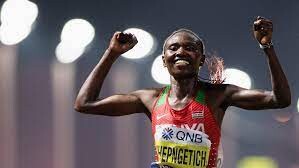
A large number of runners who have entered the N Kolay Istanbul Half Marathon will be running for charity on Sunday, collecting money for the devastating earth quake that hit the southern area of the country in winter. One group of charity runners, that is close to race organizer Spor Istanbul as it was founded by Renay Onur, will have over 1,250 runners alone on Sunday.
Turkey’s Yayla Gönen, who is on the women’s elite start list with a PB of 70:26, was in a training camp in Diyarbakir when the earth quake struck. The 26 year-old was lucky since the house in the camp did not collapse. But it was a struggle for her to get food for a week and she was then brought back to Istanbul by her club IBBSK. Despite this she still managed to run a marathon PB of 2:29:10 in Sevilla in February. Yayla Gönen is the favourite to win the Turkish Half Marathon Championships which are included in Sunday’s event.
“Istanbul is a beautiful city, the people and their support are amazing. It is my favourite city and I have to thank the race organisers for inviting me back once again“ said Ruth Chepngetich, who last raced on 12th March when she won the Nagoya Marathon in a world-class time of 2:18:08. “My recovery after the marathon was good and after a two-week-break I started preparing for the N Kolay Istanbul Half Marathon. Compared to my race here in 2021 I can say that my form is better now.“ However the Kenyan record holder does not have a certain time goal.
"My goal is to win and as always in this race I will do my best,“ said Ruth Chepngetich, who will have some additional motivation since her daughter Shalyne has accompanied her to Istanbul. “My daughter always motivates me a lot. Since she is here with us I will have to make sure not to disappoint her!“
Ruth Chepngetich knows that it will not be an easy task to make it six wins from six in Istanbul on Sunday. Ethiopia’s Bosena Mulatie has a strong PB of 65:46 while fellow-Kenyan Evaline Chirchir has run 66:01.
Charles Langat is the fastest runner on the men’s elite start list. He improved to an impressive 58:53 when he won the Barcelona half marathon in February. With this time the 27 year-old is currently the third fastest half marathoner in the world this year. “If the weather conditions are good and the course is fast then I will try to run sub 59:30,“ said Charles Langat, who also won the Lisbon Half Marathon last autumn.
Fellow-Kenyan Daniel Ebenyo is the number two on the start list with a PB of 59:04 while defending champions and course record holder Rodgers Kwemoi of Kenyan had to withdraw due to an injury. Great Britain’s Marc Scott is the fastest European runner on the list with a personal record of 60:39.
(04/29/2023) ⚡AMPby Runners Web
N Kolay Istanbul Half Marathon
The Istanbul Half Marathon is an annual road running event over the half marathon distance (21.1 km) that takes place usually in the spring on the streets of Istanbul, Turkey. It is a IAAF Gold Label event. The Istanbul Half Marathon was first organized in 1987. After several breaks it was finally brought back to life in 2015 when the...
more...U.S. Olympian stripped of national title after positive cannabis test
On Tuesday, The U.S. Anti-Doping Agency (USADA) reported the one-month suspension of U.S. Olympian Tara Davis-Woodhall after a positive cannabis test in February 2023. The test came after Davis-Woodhall won the long jump at the 2023 USA Indoor Track and Field Championships, held in Albuquerque, N.M. As a result, she will have to give up her national title and she will forfeit any medals, points and prizes accumulated between Feb. 17 and March 21.
Davis-Woodhall tested positive for a urinary metabolite of THC (the active ingredient in cannabis) in a sample collected on Feb. 17, according to the report. The use of cannabis is still banned in competition by the World Anti-Doping Agency (WADA) and usually holds a penalty of up to three months. Davis-Woodhall’s period of ineligibility was reduced to one month because her use of the substance occurred out of competition and was unrelated to sports performance, per USADA.

The 23-year-old also successfully completed a substance abuse treatment program.
Davis-Woodhall qualified for the 2020 Summer Olympics in the women’s long jump, where she placed sixth in the final. She is married to a prominent U.S. Paralympian Hunter Woodhall, who won medals at the previous two Paralympic Games.
In 2021, WADA altered its code involving THC, allowing for a reduced three-month sanction if the athlete establishes that their use of the substance occurred out-of-competition and unrelated to sports performance. This came after the July 2021 suspension of Sha’Carri Richardson, who lost her chance to compete at the 2020 Olympics after she tested positive for the substance. Richardson also served a one-month suspension and had her U.S. outdoor 100m title revoked.
Richardson’s suspension caused a stir on social media, with many siding with the U.S. sprinter. Even Toronto rapper Drake weighed in on the suspension, name-dropping Richardson in the song No Friends in the Industry of his Certified Lover Boy album.
(04/29/2023) ⚡AMPby Running Magazine
Who Would Be the #1 Pick If Running Had a Draft?
Here are the runners you’d want to build a franchise around.
It's NFL draft weekend. A weekend of hope for fans whose favorite teams underperformed last year or lost some key players in trading wars. The Carolina Panthers have the first pick this year, and they desperately need a quarterback to build their team around for the foreseeable future.

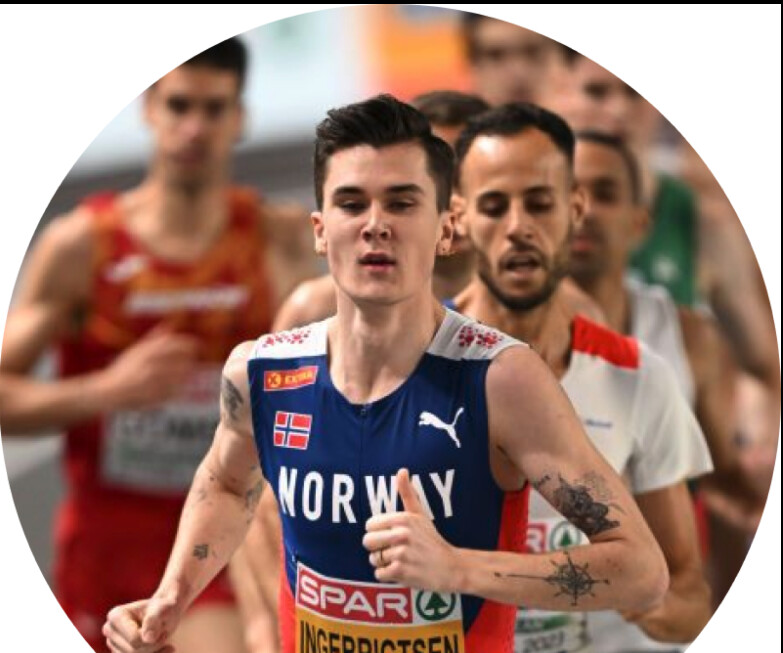
On Thursday, they selected former Heisman winner Bryce Young, of Alabama, to fill that role. That got the editors at Runner’s World thinking: who would go first overall in the sport of running? First, we need to set some parameters for our fantasy scenario. All running events contested at the Olympics—from the 100 meters to the marathon—are included. (Field events can have their own draft). And athletes must be currently competing, so no FloJo or Michael Johnson.
We conducted a quick office poll and consulted our track nerds to come up with a shortlist of three women and three men. Here’s who we’re picking.
Women
Sifan Hassan
Distance, The NetherlandsIf you watched her storm to a win at last week’s London Marathon, you probably already agree with me—Sifan Hassan has the best range in the world right now. Frankly, it’s not even close. At the 2020 Olympics, the Dutch runner pulled off an insane triple, winning the 5,000 meters, 10,000 meters, and capturing bronze in the 1,500 meters. She had a down year in 2022, missing the podium at the World Championships, but she reasserted herself as a force this year after her comeback win at London. Her only draft stock drawback? At 30 years old, she might not be the best investment for a team looking far down the line.
Sydney McLaughlin-Levrone
Hurdles, United StatesThe world record holder in the 400-meter hurdles is a sure-fire pick for a team looking for star power and incredible consistency. She’s a monster talent—making the Olympics at just 16 years old—and since then, now 23, she’s only gotten better. Last year, at the World Championships, she set the world record, beating a loaded field. But McLaughlin-Levrone’s upside is in her versatility: she’s world class in the 110-meter hurdles as well, and was a ringer on Team USA’s gold-medal winning 4x400-meter relay team at the 2020 Olympics. Syd the Kid is a no-brainer for a team that needs a recognizable, long-term talent in the sprints.
Letesenbet Gidey
Distance, Ethiopia The Ethiopian star’s range is not quite as expansive as Hassan’s, but at 25, she’s already an instant threat in whatever she’s entered in. She’s the current world record holder in the 5,000 meters, 10,000 meters, and half marathon—plus, she boasts a marathon PR of 2:16:49. Gidey is a perfect fit for a team looking to sacrifice a bit of experience for one of the top up-sides in distance running.
Men
Jakob Ingebrigtsen
Distance, NorwayThe mid-distance prodigy hasn’t raced much on the roads, but he’s almost a lock in anything from 1,500 meters to 5,000 meters. He’s starting to run out of accomplishments at only 22 years old: Olympic gold? Check. World record? Check. Ingebrigtsen will do well on a team that needs a vocal leader, and who can back up his talk with his speed. Plus, he’s got swagger, and the entire country of Norway behind him.
Grant Holloway
Hurdles, United StatesI have a soft spot for consistent hurdlers, I guess. Sure, Holloway finished a disappointing second at the 2020 Olympics, but he won world championships in the 60-meter hurdles and 110-meter hurdles last year. In fact, Holloway hasn’t lost a 60-meter hurdles race in nine years. And he’s only 25. In college, he also won national championships in the flat 60 meters, 4x100-meter relay, and split 43.7 on the 4x400-meter relay—talk about a utility player.
Jacob Kiplimo
Distance, Uganda Staying within the theme of impressive range and youth, Jacob Kiplimo is a solid pick for a team that wants to focus on the long distances. Sure, you can go with a proven legend like Kipchoge, or an accomplished marathoner like Evans Chebet, but Kiplimo owns the half marathon world record (57:31) and recently won gold at the World Cross Country Championships earlier this year. He’s less experienced than some of his counterparts (like fellow Ugandan Joshua Cheptegei), but the 22-year-old has an extremely high ceiling and has proven that he’s not afraid to take on the world’s best.
(04/29/2023) ⚡AMPby Runner’s World
Nine-time winner of Morocco's "Marathon des sables" race abandons
Shocking news struck the runners of the Marathon des Sables late Thursday (Apr. 27). 9-time winner of the race, Rachid El Morabity threw in the towel a few minutes after being caught red-handed with food in the bag.
The goal of the race is to cover 250 km in 7 days across the Sahara, in food self-sufficiency. Any food provided by a third party is therefore prohibited. But an unannounced control operated in the tent of the Moroccan proved to be positive.

The sanction of the organization was immediate: a penalty of 3 hours sealing the end of the dreams of tenth title for Rachid El Morabity.
He who was aiming to join his compatriot Lahcen Ahansal in the legend of the event. El Morabity's teammate and compatriote, Aziz El Akkad, has decided to abandon.

Rachid El Morabity's younger brother, Mohamed, remains alone at the top of the ranking, 3 minutes 17 seconds ahead of his direct contender Aziz Yachou.
In the women's ranking, French marathoner Maryline Nakache is first, get ahead of Moroccan Aziza El Amrany and Japanese Tomomi Bitoh by 30 minutes.
(04/28/2023) ⚡AMPby Africanews and Pierre Michaud
Marathon Des Sables
The Marathon des Sables is ranked by the Discovery Channel as the toughest footrace on earth. Seven days 250k Known simply as the MdS, the race is a gruelling multi-stage adventure through a formidable landscape in one of the world’s most inhospitable climates - the Sahara desert. The rules require you to be self-sufficient, to carry with you on your...
more...Vicoty Chepngeno eyes World Championships after 10,000m win
Vicoty Chepngeno has set her eyes on the World Championships in Budapest after claiming the women's 10,000m title at the sixth leg of the Athletics Kenya (AK) track and field weekend meet at Kasarani Stadium on Thursday.
This was her first AK meeting in two years having featured last in 2021.

In an interview, Chepngeno said: "After this win, my next target is the World Championships in August in Budapest Hungary. I intend to double my effort because I know it won't be easy achieving my dream," she added.
The 29-year-old attributed her victory to discipline and focus.

" I will take this step by step until I achieve my goal because I feel this is the time to represent my country and I am ready to travel to Budapest and bring the medal back home," she added.
"Discipline makes me different from the rest of the athletes and that is why I am able to win today. In everything I do, It's all about discipline and that is why I believe I will make the cut for Team Kenya to Budapest," he noted.
She said she followed the program given to her by the coach strictly and she is happy it bore fruits.
Chepngeno added: "I was not expecting this win but I thank God. I worked very hard during the training and patience was one of my key guiding factors," she noted.
(04/28/2023) ⚡AMP
by Maryan Siyad Abdirahman
World Athletics Championships Budapest 23
From August 19-27, 2023, Budapest will host the world's third largest sporting event, the World Athletics Championships. It is the largest sporting event in the history of Hungary, attended by athletes from more than 200 countries, whose news will reach more than one billion people. Athletics is the foundation of all sports. It represents strength, speed, dexterity and endurance, the...
more...What is the best diet for runners?
As a runner, your diet plays an important role in your performance and overall health.
Eating the right foods can help you reach peak performance while avoiding injury or fatigue.

But with so many different diets out there, it can be difficult to figure out which one is best for runners.
In this comprehensive guide, we’ll discuss what makes up a healthy diet for runners and how you can tailor it to fit your individual needs.

We’ll also explore some of the most popular diets among runners—including plant-based diets, low-carbohydrate diets, and intermittent fasting—and explain why they may or may not be beneficial for athletes.
Finally, we’ll provide tips on how to get started with any new eating plan so that you can maximize its benefits and start seeing results quickly!
What Makes Up A Healthy Diet For Runners?
A healthy diet for runners should consist of a variety of nutrient-dense whole foods, including vegetables, fruits, lean proteins, and complex carbohydrates.
Eating these foods in the right amounts can provide the energy needed for running and help keep you feeling full longer.
Hydrating frequently with water or sports drinks is important to ensure that your body is properly fueled and hydrated during exercise.
Aim to consume 20-50 grams of protein per day and at least 5 servings of fruits and vegetables.
Runners should eat complex carbohydrates such as whole grains, legumes, nuts, and seeds for sustained energy levels throughout the day.
Lastly, incorporating healthy sources of fat like avocado, olive oil, nuts and seeds can help promote joint health and provide essential nutrients.
Eating a balanced diet that provides adequate amounts of these food groups will ensure optimal performance and good overall health for runners.
Popular Diets Among Runners
Runners can benefit from various types of diets depending on their individual goals and needs. Some popular diets among runners include plant-based, low-carbohydrate, and intermittent fasting.
Plant-Based Diets focus on eating primarily fruits, vegetables, legumes and whole grains while avoiding animal products.
Low Carbohydrate Diets restrict carbohydrates in favor of eating more protein and fat.
Intermittent Fasting involves periods of fasting and eating within specific windows of time each day, allowing for improved energy levels during runs.
All three types of diets can provide runners with improved performance, endurance, and recovery if done properly.
However, it is important to consult with a nutritionist or dietician before starting any type of diet in order to ensure that you are getting the necessary macronutrients and micronutrients for optimal health.
Plant-Based Diets
Plant-based diets are becoming increasingly popular among runners due to their potential health and performance benefits.
If you’re considering going vegetarian you can take a look at this quiz, and check the results. Maybe a plant-based diet is just for you.
These diets focus on eating primarily plant-based foods such as fruits, vegetables, legumes, nuts, seeds and whole grains while avoiding animal products.
Plant-based diets can provide runners with increased energy levels during runs and promote faster recovery post-run due to their high nutrient content.
These diets can help reduce the risk of developing chronic diseases like diabetes and heart disease by reducing inflammation, improving blood sugar levels, and lowering cholesterol.
When following a plant-based diet, it is important to focus on consuming varied sources of whole grains, legumes, fruits and vegetables in order to ensure that you are getting all the necessary vitamins and minerals.
Plant-based protein sources such as tofu, beans, quinoa, nuts, and seeds should be consumed regularly for adequate amounts of protein.
Lastly, incorporating healthy fats from avocados, olives, nuts and seeds can help promote joint health and provide essential fatty acids.
Eating a balanced plant-based diet can provide runners with improved performance and good overall health.
Low Carbohydrate Diets
Low Carbohydrate Diets are becoming increasingly popular among runners looking to lose weight or improve performance.
These diets focus on reducing carbohydrates while emphasizing the consumption of proteins and healthy fats.
They can help improve running performance by providing sustained energy levels without spikes in blood glucose and insulin.
Low-carb diets also promote fat burning, which can be beneficial for runners looking to lose weight.
When following a low-carbohydrate diet, it is important to focus on eating proteins from sources such as lean meats, fish, eggs, and legumes and healthy fats from sources like nuts, seeds, olive oil and avocado.
It is important to incorporate adequate amounts of non-starchy vegetables like broccoli, kale, spinach and cauliflower to provide essential vitamins and minerals.
While following a low-carb diet can help improve performance and aid in weight loss, it is important to ensure that you are getting enough carbohydrates for optimal performance and recovery after runs.
Intermittent Fasting
Intermittent Fasting is becoming an increasingly popular diet among runners looking to improve performance and health.
This type of diet involves fasting for certain periods throughout the day, while consuming all meals within specific windows of time.
During the fasting period, it is advised to avoid food and only consume water or other calorie-free beverages such as tea or coffee. This type of diet can help improve running performance by providing sustained energy levels and promoting fat burning for weight loss.
Intermittent fasting has been shown to reduce inflammation, improve insulin sensitivity and reduce cholesterol levels.
When following an intermittent fasting diet, it is important to ensure that you are consuming adequate amounts of macronutrients and micronutrients during the non-fasting window.
Consuming high-fiber foods can help keep you feeling nourished and energized throughout the day.
Intermittent fasting is a beneficial diet for runners who are looking to improve performance and health, but it should be done in moderation to ensure that you are getting adequate nutrients for optimal performance and recovery.
Final Word
Overall, there are many different diets that can be beneficial for runners.
Whether you choose to follow a plant-based diet, low carbohydrate diet or intermittent fasting plan, it is important to ensure that you are getting adequate amounts of nutrients and calories in order to promote optimal performance and good overall health.
By understanding how the human body reacts to specific foods, runners can optimize their nutrition plans for improved running performance and better recovery post-run.
Making small changes such as incorporating more plant proteins into your meals or reducing carbohydrates may make all the difference when it comes to improving your running results.
With these tips in mind, you should have no problem finding an effective dietary strategy that works best for you!
(04/28/2023) ⚡AMPby Colorado Runner
Prep for your upcoming 10K with tempo 400’s
To race a 10K, you need a combination of speed and endurance. The 10K is one of the most popular distances to race and is considered a gateway into longer distances (i.e., the half-marathon and marathon). Running a fast 10K isn’t easy, but if you can put in a few solid weeks of aerobic training, you’ll be destined for a strong finish.
For 10K training, most online coaches will generally recommend one-kilometre or two-kilometre repeats to get you more familiar with your goal race pace, and to raise your aerobic threshold. These repeats can feel tedious, especially if they are in your training plan every week. But you can spice up your speed training and head to your closest track to try this tempo 400’s workout.

Workout
10 to 15 reps of 400m @ goal race pace with 100m jog between reps.
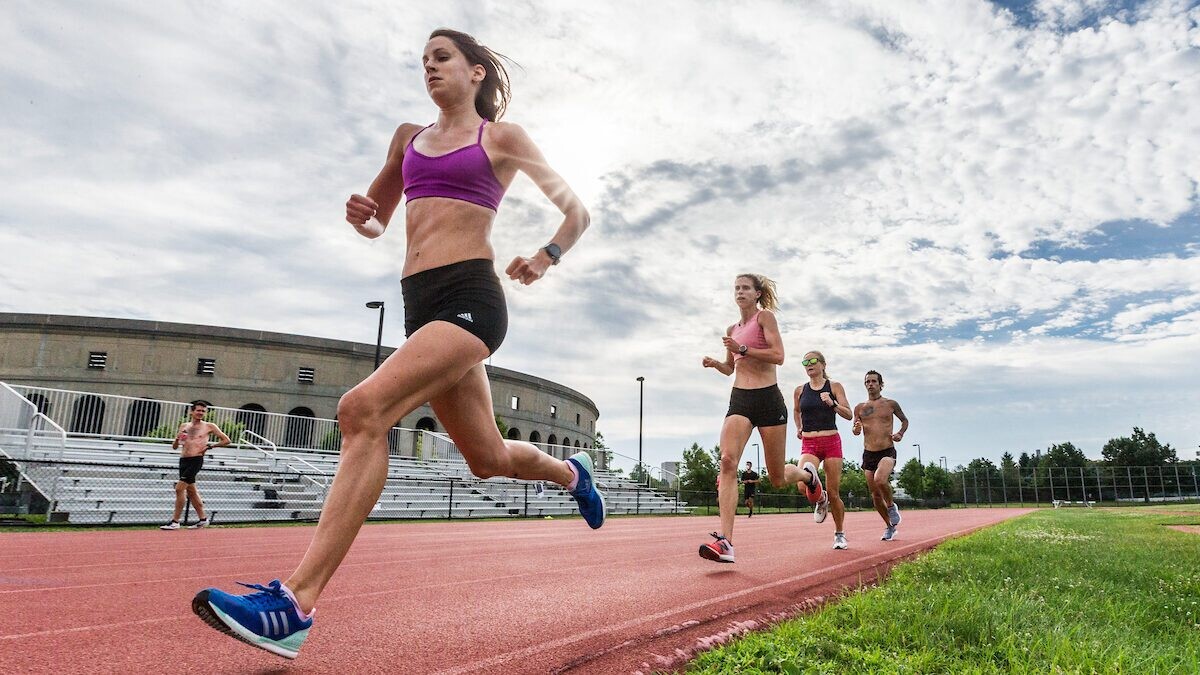
Start the workout with a 10- to 15-minute warm-up jog, followed by 10 to 15 minutes of dynamic stretching.
If your local track is not 200 or 400 metres in length or if the track is non-existent, you can modify the workout to 10 to 15 reps of 100 seconds at 10K race pace with 40 seconds of jog rest.
Start the first rep at your goal pace or a tad slower, to ensure you aren’t overdoing it. If you go out too fast, it’ll likely come back to haunt you later in the workout. The 100m jog between reps should be done at an easy run pace.
The purpose is to improve your aerobic endurance by keeping your heart rate steady and managing your effort accordingly, helping you finish strong. If you finish all 15 reps at goal pace, you will have a strong indication of where your fitness is, heading into your 10K.
(04/28/2023) ⚡AMPby Marley Dickinson
How to donate blood while training for a race
Among the ways running changes lives is through philanthropic pursuits, and there is perhaps no more valuable—or needed—way to help others than donating blood. Fifty-two per cent of Canadians say they or a family member has needed blood or blood products, according to Canadian Blood Services, the non-profit charity responsible for managing the national supply of blood products in all provinces and territories except Quebec.
Runners who meet the Canadian Blood Services’ criteria for being a donor, can make the life-saving gift of blood donation a regular part of their lives. For those in the process of getting ready for a big race, however, a little planning will ensure that making a blood donation and meeting your training goals can both be accomplished in the safest possible way.

Preparing to donate
The standard blood donation collected through Canadian Blood Services is around 450 milliliters. That’s a small portion of the total volume of blood in the average human body—around five litres—but it does demand that you take good care of yourself before and after each donation, which will will aid your return to full strength following a donation. Canadian Blood Services recommends staying hydrated, eating a healthy meal and getting plenty of rest the night before the donation. Donors are also advised to drink 500 ml of water and to eat a salty snack right before making the donation.

Followup care
The actual donation generally takes only 15 minutes, and the whole process—including another 15 minutes of immediate post-donation resting and snacking—takes about an hour. According to Canadian Blood Services, it takes only hours to replenish the plasma portion of a donation, and days to replenish the platelet portion, while red blood cells can take months to replenish.
Canadian Blood Services recommends avoidimg strenuous exercise (i.e., running) for six to eight hours following a donation, and to continue drinking extra fluids 24 hours after the donation. The World Health Organization’s guidelines are more conservative, recommending avoiding strenuous physical activities or sports for 48 hours following a donation.
Performance impacts
Although concerns over physical performance come secondary to those of safety, how a blood donation might affect the quality of training is understandably of interest to runners. According to this 2016 study, a standard blood donation of 400-500 ml leads to “potentially physiologically important” reductions in VO2max (7 per cent) and maximal exercise capacity (10 per cent) in the first two days after a donation.
A scheduling solution that would satisfy all of the above would be to plan the week’s long run for early on the day before making the donation, allowing plenty of time to rehydrate and rest later in the day. Staying off your feet during the hours before the donation can ensure your body is primed for the recovery to follow. Setting aside the following 24-48 hours as rest days will give you a chance to recover from the physiological impact of the donation, making your return to running that much stronger.
Whether you adjust your training schedule to fit donation times, or schedule a donation to fit around your training schedule, there’s room for both, with a little planning. To schedule a donation or to find out more about the donation process, visit blood.ca.
(04/27/2023) ⚡AMPby Paul Baswick
Mississauga runner to complete 19 consecutive marathons to honor late son
Eighteen years ago, David Harris of Mississauga made a promise to himself after losing his son Cameron to suicide.
Cameron died while Harris was training for his first Mississauga Marathon in 2005. He found that running gave him a measure of peace to help him cope with his grief, and he made it his goal to fight youth mental illness and raise awareness of others’ suffering. On April 30, he will complete his 19th consecutive Mississauga Marathon–one for each year of Cameron’s life.
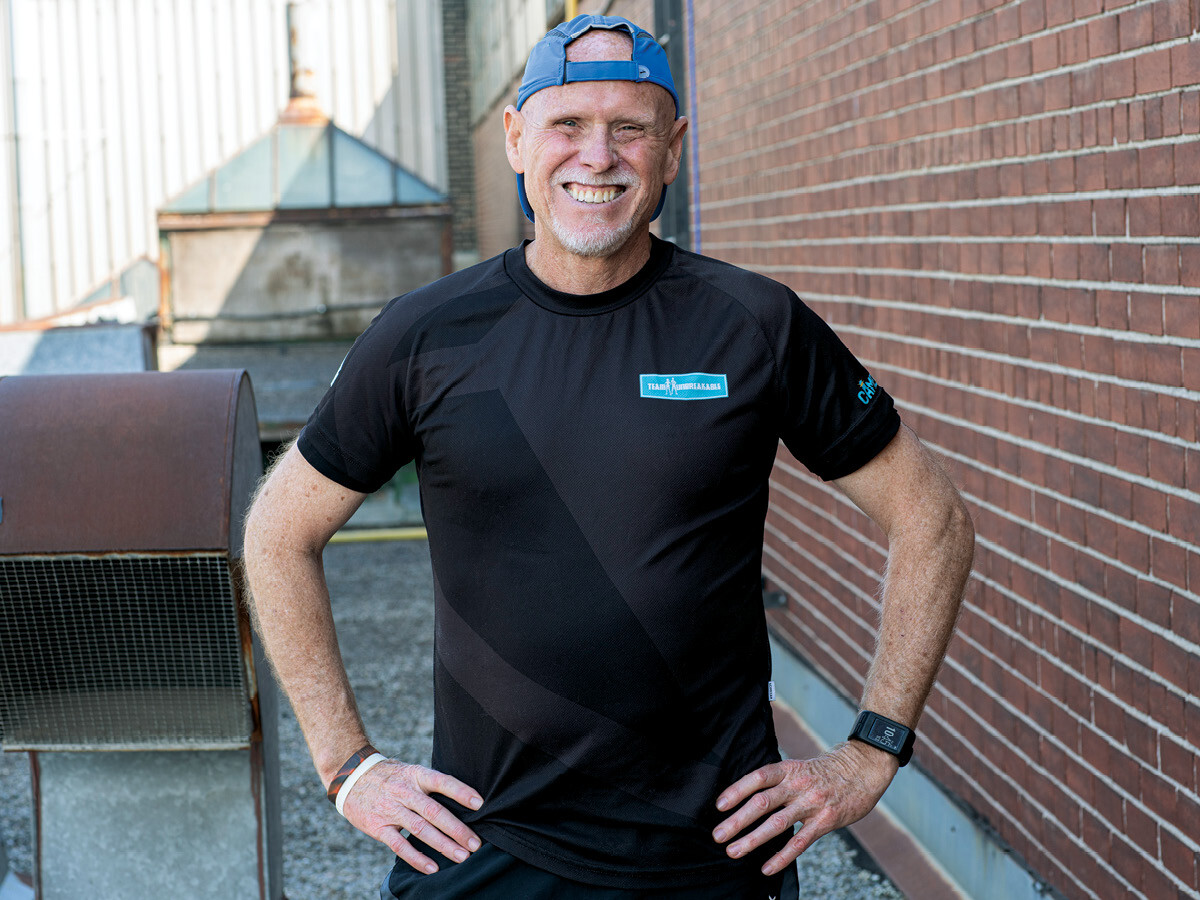
On Feb. 14, 2005, Harris’s life was changed forever when Cameron took his own life at 19. “There was a lot of fallout from his death,” says Harris. “People grieve in different ways, but running saved my life.”
“People weren’t talking about mental health in 2005,” says Harris. “The sad reality was, people did not want to hear what I had to say.”

In 2006, Harris founded CameronHelps to help raise awareness about teen suicide and youth mental health. This organization evolved and changed its name to (Team Unbreakable), which demonstrates through a running program that physical activity, such as running, can help improve mental health. For many years CameronHelps/Team Unbreakable organized running events geared toward youth and their families.
Harris also began volunteer coaching with Dan McGann of Credit Valley Hospital and its Run Group Therapy Program, which provides teens with a unique approach to coping with depression. He coached with the program for 14 years, working with kids, teaching them how to run, and getting them to up to 5K. “The transformation of these kids was magical,” says Harris. “It meant the world to me.”
The 63-year-old fell into running before Cameron’s death. “In 2003, I looked in the mirror and didn’t like what I saw,” he says. “I went to Chapters and found a book called Body for Life, which had a 90-day program that could change your life.”
Harris says he followed the book religiously: “I felt brand new in three months. I was physically and mentally stronger, and I fell in love with running.”
Nineteen consecutive Mississauga Marathons have not been easy for Harris, though. In 2012, he was mugged the week before the race and ran the marathon with a torn meniscus, resulting from the attack. And in 2020 and 2021, he had to complete both Mississauga races virtually. “Every year, my motivation is Cameron and to finish that damn race,” says Harris. ” I know this year’s race will be filled with mixed emotions, but it’s incredible the journey is coming to an end.”
Harris, now a father of three boys, says not a day goes by that he doesn’t think about Cameron. “The feelings of grief–I still have them,” he says. “I tell myself it’s OK to cry. I always had to fight that, but now I embrace my emotions.”
This year’s race is now branded as the Mississauga Half and changed to a half-marathon format, dropping the marathon. Harris said the Mississauga Half team has been supportive, allowing him to start earlier than the other runners and run the course twice.
Harris aims to raise $1 million for Jack.org, an organization his friend, Eric Windeler, started, whose son also died by suicide. His campaign is backed by a sponsor, TC Energy, which will match all donations to Harris’s campaign.
(04/27/2023) ⚡AMPby Running Magazine
Nikki Hiltz, Sam Prakel both become two-time winners at Usaft 1 mile road
The USATF Indoor 1,500-meter winners demonstrated they could also rule the roads Tuesday night at the USATF 1 Mile Championships.
Nearly 10 weeks after both winning USATF Indoor titles Feb. 18 in Albuquerque, N.M., adidas professional Sam Prakel and Lululemon athlete Nikki Hiltz each secured their second career national road championships as part of the annual Grand Blue Mile event.

Hiltz produced the fastest performance in the history of the women’s race, which began in 2009, clocking 4 minutes, 27.97 seconds to edge reigning USATF Outdoor 1,500 champion Sinclaire Johnson of Nike’s Union Athletics Club in 4:28.70.
Hiltz, who prevailed in 2019 in Des Moines in 4:29.7, became the only athlete in event history to produce a pair of sub-4:30 efforts, benefitting from a 65-second opening quarter-mile and the pack reaching the midway point in 2:14.

Emily Lipari, who had the previous all-time mark of 4:29.3 in 2020, and Johnson are the only other competitors to achieve a sub-4:30 performance in the race.
Hiltz, who ran a lifetime-best 1:59.03 in the 800 meters April 14 at the Bryan Clay Invitational at Azusa Pacific University, earned $5,000 for the victory and an additional $2,500 for the record bonus. Hiltz also joined Heather Kampf and Emily Lipari as the only three competitors to capture multiple women’s championships in event history.
Addy Wiley, a freshman at Huntington University in Indiana who secured five NAIA Indoor national titles March 2-4 in South Dakota, raced for the first time since that memorable showcase and took third in 4:30.94.
Wiley, 19, became the youngest top-three finisher in event history and achieved the No. 6 all-time performance in the nine years the competition has been held in Des Moines.
Wiley, who placed fourth in the 1,500 at the USATF Indoor Championships in February in Albuquerque, elevated to No. 7 in the history of the national road mile competition, including Sara Hall clocking 4:30.8 in Minnesota to secure the 2011 crown.
Colleen Quigley, representing Lululemon, finished fourth in 4:31.1 in her debut at the event, with Nike’s Shannon Osika and Alex Teubel also being credited with 4:31 performances to secure fifth and sixth.
Alli Cash (4:32), Jenn Randall (4:33), Micaela DeGenero (4:34) and Helen Schlachtenhaufen (4:37) completed the top 10 women’s competitors in the 23-athlete race.
Prakel prevailed in 4:01.21, remaining patient following an opening quarter mile of 61 seconds and a 2:05 split at the midway point, to take control in the final 500 meters and never relinquish his advantage.
Under Armour Mission Run Baltimore Distance athlete Casey Comber edged last year’s champion Vincent Ciattei by a 4:02.88 to 4:02.91 margin to grab second.
Prakel, who ran 13;22.78 in the 5,000 meters April 14 at Bryan Clay, also secured a $5,000 prize for the road mile title, becoming only the third male athlete in event history to capture multiple championships, joining David Torrence (2009-11) and Garrett Heath (2013 and 2015).
Prakel produced the fastest all-time mark in Des Moines with his 3:58.3 effort in 2020. Ben Blankenship holds the meet record with his title in 3:55.8 in 2016 in Minnesota.
Nick Randazzo, Kasey Knevelbaard and Jake Gillum were all credited with 4:04 performances to finish fourth, fifth and sixth, followed by Shane Streich and David Ribich both clocking 4:05 for seventh and eighth, Craig Nowak earning ninth in 4:06 and Colin Abert taking 10th in 4:08 in the 17-athlete race.
(04/27/2023) ⚡AMPGrand Blue Mile
The Grand Blue Mile was created by Wellmark Blue Cross and Blue Shield and the Drake Relays to encourage healthy habits and empower positive change. Held annually since 2010, the Grand Blue Mile has hosted more than 30,000 participants from 26 states, six countries, and four continents. The annual event brings friends and families together to celebrate wellness through a...
more...Eliud Kipchoge to rest before planning on next marathon
World Marathon record holder Eliud Kipchoge has prioritised recovery before making a decision on his next marathon.
Kipchoge, who flagged off the the London marathon men's elite race last Sunday that was won by Kenya's Kelvin Kiptum, said he is firmly focused on the challenges ahead.

"Thank you London for having me. I felt inspired to meet so many runners from around the world. Their energy motivates me for the challenges ahead. I'm heading back to Kenya to recover and make plans for my next marathon," Kipchoge posted on his twitter account.
Kipchoge has won the London and Berlin Marathons four times apiece.

Speaking on BBC One before flagging off the race, he said: "I love being in London. The crowd is always wonderful and it's great to see how the running community is coming together. London is like home to me and it is the place to be for a marathon.
On Sunday April 16, Kipchoge finished sixth in the Boston marathon where he was making his debut. The 38-year-old who is a two-time Olympic champion, failed to sparkle in the much-hyped marathon.
Defending champion Evans Chebet won the Boston Marathon, surging to the front at Heartbreak Hill to cut the tape in a time of 2:05:54.
(04/27/2023) ⚡AMPby Evans Ousuru
Pro triathlete takes shots at Olympians after doping ban
Ironman champion Collin Chartier said he won't blame a "tainted burrito or tainted COVID vaccine" for his positive EPO test.
American professional triathlete Collin Chartier was handed a three-year ban from competition on Monday after a positive result for erythropoietin (EPO) in a random drug test from February. The Ironman champion took to Instagram to address the positive test, stating that he was not going to make excuses, instead admitting his guilt. At the end of his apology note, Chartier took blatant shots at Olympic runners Shelby Houlihan and Zane Robertson, both of whom have faced doping bans in recent years.

Shots fired
“I am not going to give myself or anyone else the bullshit excuse like a tainted burrito or tainted COVID vaccine,” Chartier wrote. The “tainted burrito” was a reference to Houlihan’s post-doping-ban excuse in June 2021, while the COVID vaccine line was a nod to Robertson’s more recent doping bust in March.

After testing positive for the steroid nandrolone in Dec. 2020, Houlihan claimed it was due to contaminated meat that she ate at a food truck the night before her test. Robertson took a similar route following his ban, blaming his positive test (which occurred in May 2022) on a COVID-19 vaccine he received in Kenya.
Chartier’s apology has not been well received by the triathlon community, with many of his peers going after him online. While there is no excuse for his actions or decision to use EPO, at least he admitted to cheating.
“Tell the whole truth”
Chartier’s apology has sparked an important conversation in the triathlon world surrounding dopers and the help they receive to cheat. Many other pro triathletes have demanded that Chartier take his admission of guilt a step further by exposing anyone who helped him cheat and any other athletes whom he knows have doped.
“Tell the whole truth,” eight-time Ironman champion Ben Hoffman wrote on Instagram. “How did you do it, who helped, who else is involved, and give the full story of why.” Former Ironman world champion Sebastian Kienle commented directly on Chartier’s apology post, writing, “Let me guess, you bought [the EPO on] the internet and also learned how to use it—all from the internet. Nobody helped you, nobody knew.”
These athletes—and many fans—have said Chartier’s apology feels hollow and insincere, since he has yet to identify others who helped him or who are also cheating. They object to any praise he may be receiving for being honest about having cheated, insisting that he has a further role to play in cleaning up the sport. (Robertson admitted to doping after originally making the bogus COVID vaccine excuse.)
Although Chartier said he is retiring, he is now serving a three-year ban from competition. Houlihan was given a four-year ban and is not eligible to race again until 2025. Robertson announced his retirement before his ban was made public, but was still given an eight-year ban.
(04/26/2023) ⚡AMPby Running Magazine
Six tips for hitting the trails, follow these tips to help you succeed as a trail runner
There’s no reason you shouldn’t add trail running to your training schedule every now and then, but before you hit the trails, there are some things you should consider. We’ve compiled a short list of tips and suggestions that will help you succeed in the realm of off-road running, whether you plan to pursue the sport seriously or simply want to train on the trails once or twice a week.
1.- Eyes on the trail

On the road or track, you can look wherever you want and you’ll probably be OK; for the most part, your runs are smooth and without obstacles. But when trail running, rocks, roots and anything else in nature could trip you up if you’re not looking for them. Keep your eyes on the trail. Otherwise, you might take a tumble.
2.- Bring a map

If you don’t know the area, bring a map. No, you don’t have to carry a fold-up paper map into the forest with you, but it’s a good idea to have a map or GPS on your phone. It’s so easy to get lost in unfamiliar territory, and sometimes you can even get disoriented in forests you thought you knew well. Having your phone or GPS watch to help get you back to civilization is a nice safety net.
3.- Get trail gear
If you’re going to really give trail running a go, you need to invest in the proper gear. This could just be trail-specific running shoes (which have lugs on the outsole for better traction on dirt, sand or mud), but if you plan to run longer distances, you may want to get a hydration vest and poles. Really, it’s up to you to decide how invested in the sport you want to become.
4.- Lower your expectations
You’ve got your shiny PBs from the road and the track, but none of that matters when you hit the trails. Oh, you’re running a 5K trail race? Odds are you’re not coming close to your road PB. You plan to run 40 minutes hard in the woods for your next workout? That’ll be a good effort, but don’t be upset when you check your distance and it’s nowhere near last week’s 40-minute workout on the road. Trail running is hard, so lower your expectations when it comes to pace.
5.- Jump into a race
Racing is fun. Trail running is fun. So, it only makes sense that racing on the trails would be fun, too. Enter a race. Don’t set a certain time expectation, just go out and have fun.
6.- Take food and water
When you’re running on the roads, you’re rarely too far from either home or somewhere that you can get water or some nutrition. If you bonk on the trails, you could have a long slog back to your car. Carry a gel and bring a water bottle. You’ll thank yourself later when the effort and the heat starts to get to you.
(04/26/2023) ⚡AMPby Ben Snider-McGrath
Mo Farah says Great North Run will be his final race
Britain's four-times Olympic champion Mo Farah said he will end his athletics career at the Great North Run in September.
Farah finished ninth in his final marathon in London on Sunday, clocking 2:10:28 - nine minutes behind winner Kelvin Kiptum.
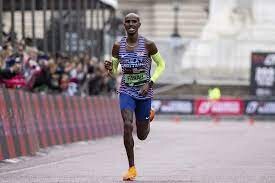
The 40-year-old will compete at the 10km Great Manchester Run on May 21 before the Great North Run half-marathon on Sept. 10.
"Part of me was wanting to cry," Farah told BBC on Sunday after the London Marathon. "I will miss that feeling, I am emotional today.
"I want to pass that on. The Great North Run is going to be my last ever run and that will be my goodbye.

"My career has been amazing, my wife and kids have been with me throughout this journey and I want to give time to them now, as well as getting involved in grassroots sport and give back to this sport."
Farah has won the Great North Run six times.
(04/26/2023) ⚡AMPGreat North Run
Great North Run founder Brendan Foster believes Britain is ready to welcome the world with open arms after the launch of the event's most ambitious plan to date. The Great World Run campaign seeks to recruit one runner from every country in the United Nations – 193 in total – to take part in the iconic half marathon in...
more...Gene Dykes hopes to become oldest Western States finisher
Gene Dykes, the record-setting 75-year-old ultrarunner from Philadelphia, will hit the trail this summer in a bid to become the oldest finisher in the history of the 100-mile Western States Endurance Run.
This year’s event, which takes place June 24-25 in Auburn, Calif., will mark the race’s 49th year.

The current oldest finisher is Nick Bassett of Cheyenne, Wy., who finished the 2018 race in 29:09. (The cutoff for all finishers is 30 hours.) Bassett was 73.
A self-proclaimed “ultra geezer,” Dykes started competing in races when he was in his 60s and has since broken multiple records for his age group. In 2021, he broke the M70 50K world record at the USATF national 50K road championships in East Islip, N.Y., crossing the finish line in 3:56:43 and beating the previous record of 4:15:55, set by Germany’s Wilhelm Hofmann in 1997, by nearly 19 minutes. Dykes broke the M70 100-mile and 24-hour track records at the Dawn 2 Dusk 2 Dawn 24-hour ultramarathon in Sharon Hill, Penn., in 2019.

In 2018, Dykes ran his fastest marathon time—2:54:23—at age 70 at the Jacksonville Marathon in Florida. The result would have seen him take the world M70 marathon title from former record holder Ed Whitlock, but Dykes’s final time was not ratified due to the race not being a USATF-sanctioned event.
In total, Dykes has run 157 marathons and ultras since 2006. His daughter Hilary will pace him at this year’s WSER.
Dykes is being sponsored in his latest effort by Calgary-based Stoked Oats. As part of their support, the company has kicked off its Breakfast with Gene series on Instragram and YouTube. The series will feature guests including Vancouver-based WSER female record holder Ellie Greenwood, three-time WSER racer Michael Wardian and race director Craig Thornley.
In 2016, 72-year-old Wally Hesseltine made a valiant and heartbreaking attempt to break the “oldest finisher” record, but missed the 30-hour cutoff by two minutes.
“We are thrilled to be supporting Gene on his journey to WSER,” says series host and Stoked Oats founder Simon Donato. “Running 100 miles is a tall order for professional runners, let alone someone in their 70s. What Gene is trying to accomplish is truly remarkable and we’re looking forward to supporting him every record-setting step of the way.”
Western States, first run in 1974, is the world’s oldest 100-mile trail race and one of the most prestigious. Each June, 369 runners from across the United States and around the world embark from the start line in Olympic Valley, Calif., to tackle a challenging course to the coveted finish line at Placer High School in Auburn.
(04/26/2023) ⚡AMPby Paul Baswick
Western States 100
The Western States ® 100-Mile Endurance Run is the world’s oldest and most prestigious 100-mile trail race. Starting in Squaw Valley, California near the site of the 1960 Winter Olympics and ending 100.2 miles later in Auburn, California, Western States, in the decades since its inception in 1974, has come to represent one of the ultimate endurance tests in the...
more...Five things all runners can learn from London Marathon champion Sifan Hassan
Two-time Olympic champion Sifan Hassan made her marathon debut at the 2023 London Marathon, and she won in heroic fashion–making a comeback after stopping twice to stretch an impinged hip. Heading into the race, Hassan said she went through the typical pre-race antics that every runner has: why did I decide to do this? Did I train enough? I don’t know what to expect.
Hassan executed her resiliency, showing that anything can be possible and how normal it is to question everything before your race. Here are five takeaways from the 2023 London Marathon champion.

1.- It is OK to be nervous!
Even after setting world records and winning multiple Olympic medals in her career, Hassan said she was excited, yet very nervous about her marathon debut in London.
Runners are only human, and most put in countless hours of training into a goal race–so being nervous is not a bad thing. Nerves are just runners’ sympathetic nervous system (SNS) kicking in, which is one of two components of the body’s central nervous system. The SNS releases two hormones in response to high-stress situations–epinephrine and norepinephrine (also known as adrenaline and noradrenaline), which result in that feeling of having butterflies in your stomach.
According to research, nerves are a good thing, and they can help your body perform better. Nerves help your reflexes become faster and improve blood circulation before exercise.
2.- Put expectations to rest
Before the London Marathon, the 2019 world 1,500m champion said during a pre-race press conference she did not change much in her training and had no goal time in her mind. “The marathon is a different distance for me; I do not know what to expect, but I want to try it,” said Hassan.
If you are trying a new distance or race, you will not know what to expect until you finish. Try to leave your expectations behind and embrace the experience. There’s a good chance you’ll surprise yourself.

3.- Trust yourself
There are a million training tips online on what to do before your first marathon or how much mileage you should run per week, but not all tips will work for you. Hassan said she did not change up much of her training and kept a similar schedule similar to her 2020 Tokyo Olympics build.
It is okay to take advice, but there’s no 100 per cent blueprint on how to train for the marathon since all runners are different. Find out what works for you, and stick with it.
4.- Don’t be afraid to stop
Hassan might be the first woman to win a marathon major while stopping twice to walk. She clarified after the race that she had hip tightness and found that the pain only increased as she continued to run. Once she stopped, walked, and stretched out the discomfort, she started running again, eventually catching the lead group around 35 km.
Running is a high-impact sport on your joints and muscles. If there is any tightness or tenderness, it can usually be better to stop and quickly address the issue rather than running and doing more damage.
There is a negative connotation around stopping during a race, but a short walking interval can also break up the monotony and help you deal with the mental challenges or discomfort you may be feeling. This tip is helpful for runners doing longer distances (like a half or full marathon) for the first time.
5.- Have fun out there
Although trying something new can bring challenges, have fun and enjoy the experience. Hassan had no thoughts of winning the London Marathon beforehand, she just wanted to try something she wasn’t used to doing, which ended up working in her favor, leading to her first Abbott World Marathon Major win.
(04/25/2023) ⚡AMPby Marley Dickinson
TCS London Marathon
The London Marathon was first run on March 29, 1981 and has been held in the spring of every year since 2010. It is sponsored by Virgin Money and was founded by the former Olympic champion and journalist Chris Brasher and Welsh athlete John Disley. It is organized by Hugh Brasher (son of Chris) as Race Director and Nick Bitel...
more...90-year-old TCS London Marathoner sets British masters record
The desire to help those battling the same disease that claimed his sister fuelled David Picksley of Croydon, Surrey, to claim the British 90+ men’s marathon record at this year’s TCS London Marathon. Picksley, the oldest of the more than 48,000 runners at this year’s event, finished the race with a time of 7:16:46.
He becomes the first to record a master’s marathon record in the British male 90+ category. Previously, the oldest British male marathoner on record was Alf Gibson, who at age 85 ran the 1993 London Marathon in 5:48:09. In 2002, Jenny Wood-Allen set the standing record in the British 90+ women’s category, running the London Marathon in 11:34:00.
In Canada, the record in the oldest men’s masters group is held by the late Ed Whitlock, who topped the men’s 85+ category with a 3:56:38 marathon finish in Toronto in 2016.

Picksley entered this year’s marathon as a fundraiser for JustGiving, a U.K. charity aimed at eradicating bowel cancer, and has raised more than $12,000 for the organization through this year’s marathon.
“When my sister April was diagnosed in 1973 with bowel cancer, this was generally seen as a death sentence,” Picksley shares in a statement on his fundraising page. “She died just a few months later at 42, with three young children. Now, almost 50 years on, of those in the UK diagnosed at the earliest stage, 97% will survive five years after their diagnosis. Currently, only just under 40% of cases are diagnosed at an early stage. The focus of the policy and the influencing work of Bowel Cancer UK over the next three years is to improve early diagnosis. I am walking the London Marathon in 2023 to recognise the improvements made in the last 50 years, and to support their campaign, to save more lives by spreading knowledge of the symptoms.”

The TCS London Marathon course is familiar territory for Picksley, who has a long history going the 42.2-km distance.
“In my 50s and 60s I ran 13 marathons, including 4 in London, and since those days I have been enjoying a walk with my stick, early every morning,” says Picksley. “Latterly that had become a lockdown habit, and when a Virtual London Marathon was introduced, I took it on. After a finish in under 7.5 hours in 2021, I did it again in 2022, in 7:13:15, just 3.5 minutes over the ‘good-for-age’ over-85 age category.”
In a video tweeted by TCS London Marathon organizers, Picksley says “it feels wonderful, it really does,” to have finished the event at age 90.
Asked if he “might have a small glass of something to celebrate,” Picksley replies: “Yeah, I should think I will. I might even make it a big one.”
(04/25/2023) ⚡AMPby Paul Baswick
TCS London Marathon
The London Marathon was first run on March 29, 1981 and has been held in the spring of every year since 2010. It is sponsored by Virgin Money and was founded by the former Olympic champion and journalist Chris Brasher and Welsh athlete John Disley. It is organized by Hugh Brasher (son of Chris) as Race Director and Nick Bitel...
more...Esther Chesang banned for four years
29-year-old marathoner Esther Chesang has been banned for four years by the Anti-Doping Agency of Kenya for use of a prohibited substance.
"The period of ineligibility (non-participation in both local and international events) for the respondent shall be for four years from the date of mandatory provisional suspension that is 11/5/ 2022 pursuant to article 10.2.1.2 of the WADC," read a Sports Disputes Tribunal ruling of April 23.

Chesang, the Sierre-Zinal 2022 women's winner, was suspended for the presence of triamcinolone acetonide.
The panel was chaired by Gichuru Kiplagat while Peter Ochieng and Gabriel Ouko were members.

The Tribunal added: "The disqualification of results in the event during which the ADRV occurred and in competitions after sample collections or commission of the ADRV with all resulting consequences including forfeiture of any medal, points and prizes pursuant to Article 9 and 10 of WADC."
(04/25/2023) ⚡AMP
by Evans Ousuru
Emmanuel Wanyonyi to use Kip Keino Classic to gauge readiness for Budapest
The 2021 World Under-20 800m champion Emmanuel Wanyonyi says he wants to use next month’s Kip Keino Classic to gauge his preparedness ahead of the World Championships in Budapest, Hungary in August.
Speaking in an exclusive interview on Monday, the speedster said he is tirelessly toiling at an elite camp in Kapsabet to perfect his act for a podium finish at Moi Stadium, Kasarani on May 7.
The prestigious one-day meet is part of the World Athletics Continental Tour Gold series and enters the third edition with at least 1,000 athletes set to battle for a share of the prize purse and world ranking points.
“I’m currently practicing for the Kip Keino Classic in Kapsabet at the 2-Running Club training camp,” Wanyonyi stated.

“I’m currently concentrating all my energies on training for the Kip Keino Classic. I’ll be using the competition to get ready for the Budapest World Athletics Championships next year,” Wanyonyi said.
He added: “I’ve been training with my eyes set squarely on the World Championships. I’m eager to demonstrate my dominance on this grand platform.”
A podium finish in Hungary is the middle-distance track sensation’s bare minimum.
“I plan to finish on the podium. I also want to better my personal best, but I wouldn’t mind trying for the record as well. I want to be considered one of the world’s best 800m runners. This is doable if I put in enough time in training,” Wanyonyi explained.

He believes lack of senior-level experience cost him a podium finish in Oregon. Nonetheless, he reckons he gleaned some invaluable lessons that could propel him to victory in Budapest.
“It was lack of experience that cost me the victory. It was my first World Championships and I’m glad I came away with a lot of valuable lessons,” Wanyonyi, who finished fourth in 1:44.54, stated.
However, he redeemed himself at the World Athletics Cross Country Championships in Bathurst, Australia when he, alongside Mirriam Cherop, Daniel Munguti and Brenda Chebet, scooped the mixed relay title.
He believes their amazing performance at the competition has increased his ambition to achieve global greatness and add another medal to his cabinet.
“Our performance in Bathurst was quite encouraging heading to the World Championships. It was a huge morale booster and my confidence in repeating this performance in Budapest has skyrocketed,” he said.
Wanyonyi rose to global stardom after storming to the gold medal at the 2021 World Under-20 Championships at the Moi Stadium in Kasarani, where he set a championship record of 1:45.01.
(04/25/2023) ⚡AMPby Tony Mballa
World Athletics Championships Budapest 23
From August 19-27, 2023, Budapest will host the world's third largest sporting event, the World Athletics Championships. It is the largest sporting event in the history of Hungary, attended by athletes from more than 200 countries, whose news will reach more than one billion people. Athletics is the foundation of all sports. It represents strength, speed, dexterity and endurance, the...
more...Paris 2024 announces Marathon for All on evening after men's Olympic race
The Paris 2024 Marathon for All will take place on the evening of August 10 on the same course as the men's Olympic marathon earlier in the day.
The race will start at 9PM from the Hotel de Ville and end in Les Invalides, organisers have confirmed.
This event is a first, as no such general public event has ever been organised in the history of the Olympic and Paralympic Games.

There will be two different distances for two different routes - a full marathon for those aged 20 and over, and a 10 kilometres race, starting at 11.30PM, for those aged over 16.
The idea is to include and bring together the maximum number of participants in events that will finish at the Esplanade des Invalides.

Paris 2024 organisers describe it as "a majestic setting to heighten the emotions and the pride of taking part in an exceptional sporting epic."
Organisers say the field will be 40,048 runners, with equal places for men and women, and that they will be "surrounded by athletes and ambassadors of the Games, who will take their place in each starting area to encourage them, fully experience the moment with them and maintain the fervour until the finish line at the Invalides."
There are still 35,000 participant bibs to be won via the Paris 2024 Club, the Marathon pour tous mobile application and the @teamorangerunning Instagram account.
A thousand of them will also be awarded during the next relay race organised by Orange on the evening of June 17, designed as a taste of the marathon.
The marathon route and the 10km route start from the square in front of Paris City Hall and finish in Les Invalides.
Runners pass through Boulogne-Billancourt, Sèvres, Ville d’Avray, Versailles, Viroflay, Chaville and Meudon and then along the Seine at Issy-Les-Moulineaux to Invalides.
An historic route awaits runners past the finest monuments in the Paris region.
The women's Olympic marathon will take place on the following day.
(04/24/2023) ⚡AMPby Mike Rowbottom
Paris 2024 Olympic Games
For this historic event, the City of Light is thinking big! Visitors will be able to watch events at top sporting venues in Paris and the Paris region, as well as at emblematic monuments in the capital visited by several millions of tourists each year. The promise of exceptional moments to experience in an exceptional setting! A great way to...
more...High school sprinter beats world champion Noah Lyles in 100m race
American high schooler Issam Asinga ran an incredible 9.83-second 100m race on Sunday, winning the race and beating 200m world champion and Olympic bronze medalist Noah Lyles in the process. The 18-year-old Asinga’s time is the fastest ever recorded by an American high school athlete under any conditions, although it was wind-aided at 2.6 meters per second (the limit for wind is 2.0 meters per second). Wind-legal or not, Asinga’s run was phenomenal, and he is certainly someone to follow in the coming years.
Sunday’s run was not Asinga’s first time storming into the record books. In March at the New Balance Nationals Indoor meet, he tied the American high school 60m record with a 6.59-second run, and broke the national high school 200m record in 20.48 seconds. His 100m result in Florida is undoubtedly his most impressive feat yet, as he took down Lyles to do it.
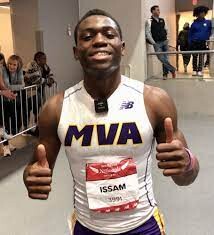
The official American high school boys record stands at 10 seconds flat—a time Trentavis Friday ran in 2014. That is as close as any high schooler has come to breaking 10 seconds in legal conditions. Before Asinga’s run on Sunday, Matt Boling had the fastest all-conditions run in American high school history, posting a 9.98-second 100m back in 2019. That race saw winds of 4.2 meters per second.
Despite running in far slower winds than Boling felt during his race, Asinga obliterated that record, flying to the finish line. A wind conversion calculator shows that his result is equal to a 9.85 run in 2.0m/s wind and a 9.93 in still conditions. In either case, Asinga’s time would smash all previous American high school records.

After the race, Lyles took to Twitter to congratulate the young sprinter. “Shout out to Issam Asinga,” he wrote. “I can definitely see us racing on the big stages if you keep improving and you can definitely get that HS record man!” There’s no word on when Asinga’s next race will come, but it will be an exciting one to watch as he chases a wind-legal result.
(04/24/2023) ⚡AMPby Running Magazine
Kenya’s Samwel Mailu smashed the course record at the Vienna City Marathon
Kenya’s Samwel Mailu smashed the nine-year-old course record of the Vienna City Marathon, running 2:05:08 at the World Athletics Elite Label road race on Sunday (23).
Despite warm conditions during the second half of the race, the 30-year-old was 33 seconds quicker than the former course record-holder GetuFeleke of Ethiopia, who clocked 2:05:41 in 2014. Mailu’s compatriots BethwelYegon and Titus Kimutai followed with 2:06:57 and 2:07:46 in second and third, respectively.
There was a Kenyan double as Magdalyne Masai won the women’s race in 2:24:12 from Agnes Keino, who ran 2:24:25. Ethiopia’s GadiseMulu was third with 2:24:50.

With temperatures climbing to around 20°C in unexpectedly sunny conditions during the second half of the jubilee race, the men’s leading group ran a consistently fast pace. After a 29:43 10km split, a group of 11 runners including three pacemakers reached halfway in 62:43.
The pace continued to be fast and the group then partly broke up between 26km and 28km in the Prater Park, where EliudKipchoge broke the two-hour barrier in 2019.

There were still six runners in contention when the leaders reached 30km in 1:29:13 and it was an all-Kenyan affair: Yegon, Mailu, Kimutai, Joshua Kogo, Bernard Chepkwony and debutant Elvis Cheboi. The latter two then lost contact, while Mailu started to pull away.
Between 32-33km he had a lead of around 10 meters over Kimutai and another 15 meters over Yegon. While these gaps grew considerably in the final five kilometers, Yegon was able to overtake Kimutai for second place.
But there was no way of catching Mailu, who ran an unexpected marathon debut in Frankfurt last year. He was a pacemaker but then continued to run and finished second with 2:07:19.
“The race in Frankfurt gave me a lot of motivation,” he said. “For me, today was kind of another marathon debut. This was my biggest career win.”
In contrast, the women never really started the planned attack on the course record. With slower split times than expected, there were initially 11 runners in the first group. Once the pace picked up a bit the group was reduced to seven at the 10km mark (33:48). Six women then reached halfway in 72:04: Kenyans ViselineJepkesho, Masai, RebeccaTanui and Keino as well as Ethiopians Mulu and NuritShimels. Tanui and Shimels were then dropped while the other four passed the 30km mark in 1:41:58.
With little over seven kilometers to go, Keino made a move in the Prater Park. The winner of last year’s Munich Marathon was around 15 meters ahead of Masai, but she could not increase her advantage. Instead, Masai responded and overtook her Kenyan rival soon afterwards.
“It was a perfect race for me,” said Masai, who is the younger sister of 2009 world 10,000m champion Linet Masai and 2009 world 10,000m bronze medalist Moses Masai. “I ran well and had some energy left for the last couple of kilometers. I have prepared for the Vienna City Marathon since January. I am very happy to have won, but I would have like to run a bit faster than 2:24.”
(04/24/2023) ⚡AMPby World Athletics
Vienna City Marathon
More than 41,000 runners from over 110 nations take part in the Vienna City Marathon, cheered on by hundreds of thousands of spectators. From the start at UN City to the magnificent finish on the Heldenplatz, the excitement will never miss a beat. In recent years the Vienna City Marathon has succeeded in creating a unique position as a marathon...
more...London Marathon Men — Kiptum Blinder With Boggling Splits
Kelvin Kiptum found a way to better his marathon debut world record as he dashed away from a quality field, blitzing a stupefying 59:45 second half to win the London Marathon with a 2:01:25 clocking.
“I am so happy with my performance in my first World Marathon Majors, and to run the second fastest time in history,” Kiptum beamed. “The secret is hard training, and my preparation was very good. Everything was going one way, and I was expecting good results.”
Race day certainly went Kiptum’s way as the 23-year-old not only pared 72 seconds off Eliud Kipchoge’s London course record, he scared Kipchoge’s 2:01:09 global standard, and moved past Kenenisa Bekele to No. 2 on the all-time list.
Left far behind was the competition as Geoffrey Kamworor ran a PR 2:04:23 to finish 2nd as Tamirat Tola filled out the podium with a 2:04:59 effort.
Kiptum picked up right where he left off last December in Valencia when he ran a stunning 2:01:53 marathon debut, closing the second half in 60:20. Having logged that impressive sub-2:02 debut, this run was less stunning than it was spectacular as Kiptum hit speeds seldom seen on a marathon course.

While the runners set off on wet pavement, the expected steady rain did not materialize and the light wind, 50-degree (10C) temperatures and a crisp 38-degree dewpoint combined for some fast running. Well at least for Kiptum.
Defending champ Vincent Kipruto and Kiptum were ready for a fast getaway, clipping at the pacers’ heels through the downhill opening 5K (14:30) before settling into a steady 2:56K pace.
Crossing 20K on the Tower Bridge in 58:31 (2:03:27 pace), Kiptum seemed to egg on the trio of pacers as they upped the tempo to pass halfway in 61:40. The move also yielded a generational change of sorts as the 40-year-old Bekele slipped out of contention while Kiptum sped on in an effort that would supplant the Ethiopian’s 2:01:41 Berlin ’19 win.
The ensuing 5K segment in 14:22 between 20 and 25K pared the pace down to a 2:03:01 clip, and the lead group to 6 contenders. Kenyans Kiptum, Kamworor and Kipruto led the charge, a stride ahead of the Ethiopian trio of Tola, Seifu Tura and Leul Gebrselassie.

Covering the subsequent 5K in 14:30 pushed the tempo down to 2:02:57 at 30K (1:27:23) when Kiptum’s obvious exuberance could no longer be restrained.
Kiptum’s break came after he missed his 30K fluid grab. “My plan was to catch a water,” he said. “But unfortunately, I missed and I said, ‘Let me make a move,’ so I try.”
Kiptum’s try was a sharp acceleration covered at first by Kamworor and Tola, but soon they were left behind.
After facing Kiptum in Valencia, Tola was ready for the move but discovered one of his legs wasn’t: “When he was moving, I start with him but my leg was not OK, so I kept on my pace to finish.”
Kamworor clung to the radical speed a bit longer before coming to his senses: “When Kelvin made a move, that was a crazy pace and I couldn’t go with it because that was insane, so I said, let me go with my pace.” Note that this perspective comes from an athlete who knows something about insane pace as he closed out his 2018 World Half-Marathon Championship in Valencia with a blistering 13:01.
Once cut loose, Kiptum covered ground effortlessly, with a little side-to-side shoulder movement in his arm swing, but from his bib number on down he ran as smoothly as Kipchoge. Looking well within his comfort zone Kiptum’s breakaway was sealed with a 13:49 split to hit 35K in 1:41:12 — 2:02-flat pace.
The sub 2:50 kilo pace continued all the way down the Thames Embankment with a 14:01 split through 40K, and running 6:12 over the final 2195m.
Kiptum admitted, “It was difficult between 30 and 40K, and at 41 and 42 I was so exhausted I had no energy.”
The 58:42 half-marathoner’s transition to the full distance seems complete as for a second race in a row, after some 30km of running, Kiptum was able to shift back into the 2:48 pace of a sub-59:00 HM.
Scant few marathoners split a sub-2:50 kilometer; Kipchoge recorded 8 in the first half of his WR run last October, and 4 in his 2:01:39 record run. Kiptum ran 6 consecutive sub-2:50s between 31 and 37K in Valencia, and went even faster here, averaging 2:47.5 over the final 12,195 meters.
That’s 1:57:48 marathon pace.
Kiptum’s improbable finishing speed and rise to the top tier of marathoners over the short span of 5 months and two competitions is a rare achievement. The Kenyan phenom has impacted the marathon world like an unassuming rookie pitcher hitting the big leagues and pounding the strike zone with 105mph fastballs.
Managed by Marc Corstjens, the soft-spoken Kenyan is based in Chepkorio, 6km east of Kipchoge’s Kaptagat camp. Kiptum is self-coached, often trains alone with a preference for long, hilly runs in the forest — reminiscent of Sammy Wanjiru’s ’08 Olympic year training.
“My focus now is marathon,” Kiptum said. “I have done some half-marathons, I have run 59 or 58 seven times, so I said, ‘Let me try to shape up for the marathon.’”
As for chasing Kipchoge’s WR, Kiptum demurred with the patience evidenced in his opening 30K: “I will go home and see, but not now. Maybe in 2 or 3 years with good preparation.”
Among the field’s highly decorated veterans, Kamworor was happy to run his best race since his ’19 motorbike accident: “The race was good, and I am happy that I have come back after a long time struggling with injuries.”
Mo Farah closed out his marathon career finishing 9th in 2:10:58, while Bekele was less fortunate, perhaps closing out his stellar career with a DNF.
Top 10 Men Finishers
1. Kelvin Kiptum (Kenya) 2:01:25
2. Geoffrey Kamworor (Kenya) 2:04:23
3. Tamirat Tola (Ethiopia) 2:04:59
4. Leul Gebresilase (Ethiopia) 2:05:45
5. Seifu Tura (Ethiopia) 2:06:38
6. Emile Cairess (Great Britain) 2:08:07
7. Brett Robinson (Australia) 2:10:19
8. Phil Sesemann (Great Britain) 2:10:23
9. Mo Farah (Great Britain) 2:10:28
10. Chris Thompson (Great Britain) 2:11:50
(04/24/2023) ⚡AMPby Track and Field News (Sean Hartnell)
TCS London Marathon
The London Marathon was first run on March 29, 1981 and has been held in the spring of every year since 2010. It is sponsored by Virgin Money and was founded by the former Olympic champion and journalist Chris Brasher and Welsh athlete John Disley. It is organized by Hugh Brasher (son of Chris) as Race Director and Nick Bitel...
more...Kenya’s Bernard Koech won the men's race at the Haspa Marathon Hamburg in a course record while Dorcas Tuitoek completed a Kenyan double by winning the women’s race
Kenya’s Bernard Koech won the men's race at the Haspa Marathon Hamburg in a course record of 2:04:09, while Dorcas Tuitoek completed a Kenyan double by winning the women’s race in 2:20:09 on Sunday (23).
Their compatriots Joshua Belet and Martin Kosgey took second and third in the men’s race with 2:04:33 and 2:06:18, respectively. Long-time leader Tiruye Mesfin of Ethiopia struggled in the final stages and despite falling, she still finished second in the women's race in 2:20:18, while Stella Chesang clocked 2:20:23 on her debut to break the Ugandan record.

In almost perfect conditions a leading group of 13 runners formed in the men’s race right after the start and they stayed together until the 27th kilometer. The half marathon mark was passed in 62:32, slightly off course record pace. But after 27km the pace of the leading group increased and Koech, Kosgey and Belet broke away. Kosgey dropped back right before the 35km mark and the decisive moment came when Koech left Belet behind.
Koech built on his lead and with 2:04:09 he improved the course record by 38 seconds.

With 2:04:33 for second place, Belet was also under the previous record, while Kosgey followed in 2:06:18.
Brazil’s Daniel Do Nascimento, who was among the pre-race favorites, finished fourth in 2:07:06.
“I ran a god race and I knew that I probably had to run a time around my PB to win,” said Koech. “I spoke with Eliud Kipchoge about the course before I came here and he gave me some advice.”
Kipchoge won his marathon debut in Hamburg back in 2013.
Kenya’s Rhonzai Lokitam Kilimo finished fifth in 2:08:08, the same time as Germany’s Richard Ringer – a PB for the latter, which is two seconds inside the Olympic qualifying time.
As expected, it was Mesfin who took the lead in the women’s race early on. But with a half marathon split of 69:46, she was not as fast as she had planned. The 2:17:23 course record was out of reach, but at 35km Mesfin looked a certain winner.
She was around a minute ahead of her rivals, but then disaster struck. The 20 year-old slowed and then stumbled, falling to the ground in the final kilometer. Behind her, Tuitoek saw her opportunity and found another gear to pass Mesfin around 300 meters from the finish line.
“I was really surprised to win. I did not see when Tiruye Mesfin fell, I was just fully focused on myself. I still had enough energy,” said 25-year-old Tuitoek, who had a PB of 2:24:54 before the race. “I knew that I could probably run a 2:20 time. This course is really fast and good for records.”
(04/24/2023) ⚡AMPby World Athletics
Haspa Marathon Hamburg
The HASPA MARATHON HAMBURG is Germany’s biggest spring marathon and since 1986 the first one to paint the blue line on the roads. Hamburcourse record is fast (2:05:30), the metropolitan city (1.8 million residents) lets the euphoric atmosphere spill over and carry you to the finish. Make this experience first hand and follow the Blue Line....
more...London Marathon 2023: Kelvin Kiptum and Sifan Hassan win with superb runs
Kenya's Kelvin Kiptum smashed compatriot Eliud Kipchoge's course record to win the men's London Marathon in the second-fastest time ever.
The 23-year-old was just 16 seconds outside Kipchoge's world record, finishing in two hours one minute 25 seconds.

Sifan Hassan also produced a remarkable run to win the women's race.
The Dutch Olympic track champion, 30, suffered with a hip injury but battled to win on her debut at the distance.

“It was really amazing,” she says. She never thought she could win, so can’t believe that she did. The crowd are amazing, she says, and every single kilometre she was grateful to be there.
She’s so happy and it’s beautiful to see; she explains she has a pre-existing hip problem, hence the stretching, and because she was fasting she didn’t practise so didn’t know where to stop for drinks.
At 20km she felt she wasn’t tired and was thinking about getting experience for her next marathon and at every moment she was grateful. She didn’t have confidence because she didn’t practise drinking and she found it really tough; she realised she didn’t have to have as much as she should.
Living in the States, she used to set her alarm to watch this race, and now she’s won it she’ll never forget it. She’d been told she’d hurt, but felt much better after 35km than she thought, and when she saw the line she thought it that really it?!
She needs to decide what race she’ll run at the Paris Olympics next summer but she’s so grateful. What an incredible racer and lovely person.
Kiptum produced the fastest marathon debut in Valencia in December, where he finished in 2:01:53 - the third-fastest time in history.
He went faster still on the streets of London, knocking one minute and 12 seconds off Kipchoge's previous course record to beat second-placed compatriot Geoffrey Kamworor by almost three minutes.
Ethiopia's reigning world champion Tamirat Tola was third, while Britain's Mo Farah finished ninth in what he says will be his last marathon.
Emile Cairess, 25, produced a superb run to finish as the first British man home, taking sixth in 2:08:07 on his marathon debut.
It was the third-fastest marathon time by a British man - behind Farah and Steve Jones - and the second fastest by a Briton in the London race.
Four British runners finished in the top 10 in total, with Phil Sesemann eighth and Chris Thompson 10th.
In the women's race, Hassan, who won the 5,000m and 10,000m at the Tokyo Olympics in 2021, appeared out of the race after dropping back early on with a hip problem, but gradually fought back.
She then produced a sprint finish to win in two hours 18 minutes 33 seconds.
Ethiopia's Alemu Megertu was second and Kenya's previously unbeaten Olympic champion Peres Jepchirchir third.
Kenyan world record holder Brigid Kosgei looked to be limping from the start and dropped out after just three minutes, while Ethiopia's defending champion Yalemzerf Yehualaw was fifth.
Sam Harrison, 27, was the first British woman home, clocking a new personal best of 2:25:59 for the 26.2-mile distance as she claimed 11th.
It was the fifth-fastest time by a British woman in the event.
Switzerland's Marcel Hug knocked 50 seconds off his own course record to win a third consecutive London Marathon men's wheelchair race - and fifth in total.
Hug, 37, finished in one hour 23 minutes 48 seconds, well ahead of the Netherlands' Jetze Plat in second, with Japan's Tomoki Suzuki third and the United States' Daniel Romanchuk in fourth.
Britain's David Weir, 43, finished his 24th London Marathon in fifth place.
Australia's Madison de Rozario held off Manuela Schar, of Switzerland, in a sprint finish to win the women's wheelchair race for a second time.
The four women's favourites made it on the Mall together before De Rozario and Schar pulled away.
De Rozario won in one hour 38 minutes 52 seconds, with defending champion Catherine Debrunner, of Switzerland, in third and the United States' Susannah Scaroni fourth.
Eden Rainbow-Cooper, 21, who was third in 2022, was the first Briton home in seventh.
The event has returned to its traditional date in the calendar, in April, for the first time since 2019 after being moved during the Covid-19 pandemic.
More than 47,000 runners are taking part, with huge crowds lining the streets of London despite damp conditions.
(04/22/2023) ⚡AMPTCS London Marathon
The London Marathon was first run on March 29, 1981 and has been held in the spring of every year since 2010. It is sponsored by Virgin Money and was founded by the former Olympic champion and journalist Chris Brasher and Welsh athlete John Disley. It is organized by Hugh Brasher (son of Chris) as Race Director and Nick Bitel...
more...Two Firefighters Ran the Two Oceans Half Marathon in Full Gear
Renaldo Duncan and Jermaine Carelse completed the Cape Town race to support Volunteer Wildfire Services.Running a half marathon while wearing ski boots is one thing, but taking on a race in full firefighter gear is a whole new level.
On Sunday, two fire and rescue service members, Renaldo Duncan and Jermaine Carelse, completed the Two Oceans Half Marathon in Cape Town, South Africa, while wearing full firefighting gear to support a local charity.The men donned heavy jackets and helmets for the duration of the half—though no large boots were involved, as the firefighters opted to wear traditional running shoes to make things a bit more pleasant.

While the weight of firefighter gear was indeed a hindrance during the race, the biggest challenge was how the equipment would affect body temperature in the late miles.
"We started heating up and [had] to take in a lot of fluids," Duncan told News24 in Cape Town. "It’s probably the most fluid I’ve ever taken in a race."
Duncan, a 13-year veteran firefighter, trained for this year’s Two Oceans by running in full firefighter gear during other races, and the duo had completed the race together—also in full gear—back in 2017. With the gear on, the pair completed this year’s run in 2:41.
The firefighters did the stunt in hopes of raising awareness and donations for the Volunteer Wildfire Services (VWS), which combats runaway fires in the area. The VWS is a collection of about 320 volunteers that fight dangerous brushfires by wading through dense brush and across treacherous terrain to contain fires before they can spread farther.
"A lot of the city’s annual fires, around half, are bushfires, and a lot of that happens in the green belts that surround the city, whether in Helderberg or along Table Mountain National Park,” said JP Smith, a mayoral committee member for safety and security, to News24. “These fires can be utterly devastating [and] we depend heavily on the VWS ... these volunteers do really brilliant work, and they do a lot of fundraising and need a lot of equipment.”
This isn’t the first time firefighters have opted to go full gear for a good cause. In 2015, firefighters in Ontario ran with 70 pounds of gear to raise awareness for PTSD. That same year, a New Jersey firefighter set a record for the fastest mile in full gear with a time of 6:45 to raise awareness for his charity, Team Firefighter.
(04/22/2023) ⚡AMPHere Are the 10 Most Hilarious Guinness World Records Being Attempted at the 2023 London Marathon
So far, 2023 has already given us so many memorable, slightly useless Guinness World Records—from the man who ran a half marathon while wearing 120 t-shirts to the J.K. Rowling fan that ran the fastest half marathon time while dressed as a witch and the man who crushed a half-marathon while in ski boots. Luckily, if you’re a fan of watching such feats, one of the premier events in the running world for setting wacky world records—the London Marathon—is here.
Last year’s event saw 18 records broken out of a possible 34 attempts, including the one completed by Kellie Clark, who, with her Snickers bar outfit, became the speediest female dressed as a candy confectionery item with a time of 4:24:06 and who could forget David Jones, who finished in 2:47:15 while wearing his pajamas.The number of attempts is no coincidence, as the race is entering its 16th year of collaboration with Guinness to bring creative and inspirational runners to the race to raise awareness for specific charities and organizations.

Guinness World Records adjudicators will be present at the start and finish lines of the TCS London Marathon to evaluate costumes, verify runner times, and certify any successful participants as official Guinness World Record holders, entitling them to be featured in the next installment of the book released in September 2023.
“It will be all my birthdays, and Christmases come at once! I used to get a copy of the Guinness World Records book every year under the tree and pore over it, gobsmacked by all the weird and wonderful records. So, to be included in there would absolutely be a dream come true,” said Jack Glasscock, who spoke to marathon organizers about the prospect of becoming the fastest man dressed as a Domino’s Pizza garlic and herb dip. Eliud Kipchoge may never be able to claim that.
While Glasscock, who is running to raise funds for the Teenage Cancer Trust, is one of the many costumed record hopefuls raising money for the charity of their choice, others, like Radio 1 DJ Adele Roberts, are hoping to break a record without an outfit. Roberts is just 18 months removed from surgery to remove her bowel and hopes to become the fastest marathoner with an ileostomy. She will do so to raise money for Attitude Magazine Foundation, which supports LGBTQ+ communities.
The 2023 edition of the race will be even more exhilarating, with a whopping 73 records set to be challenged this time. We’ll spare you the details of all 73, but we will share 10 of this year’s absolute dumbest records being attempted. Strap on your favorite candy-bar costume and get ready to be inspired:
Fastest marathon dressed as a three-dimensional dinosaur (male)
Fastest marathon dressed as a three-dimensional aircraft (male)
Fastest marathon dressed as a three-dimensional aircraft (female)
Fastest marathon dressed as a knight (male)
Fastest marathon in a full-body inflatable costume (male)
Fastest marathon carrying a household appliance
Fastest marathon dressed as a savory food (female)
Fastest marathon dressed as a gingerbread person
Fastest marathon dressed as a crustacean (female)
Fastest marathon dressed as a piggy bank
(04/22/2023) ⚡AMPby Runner’s World


